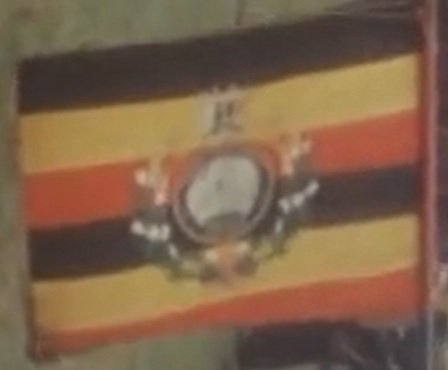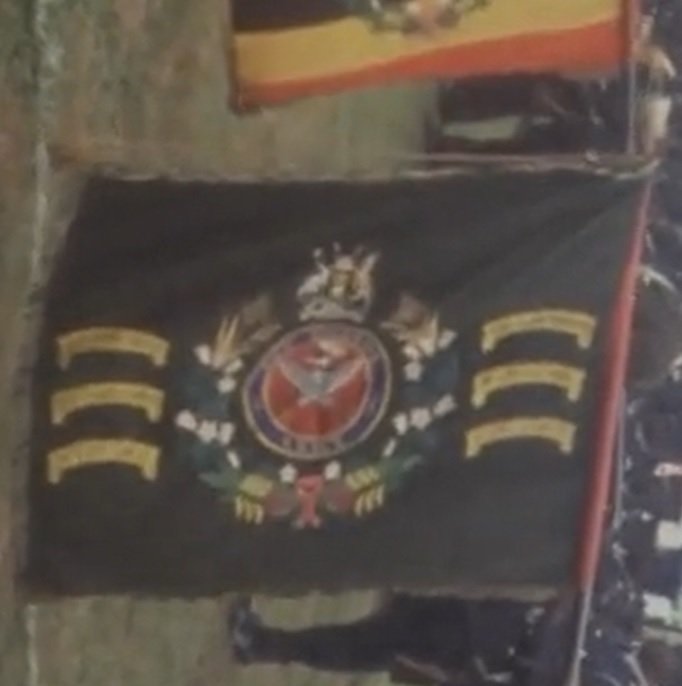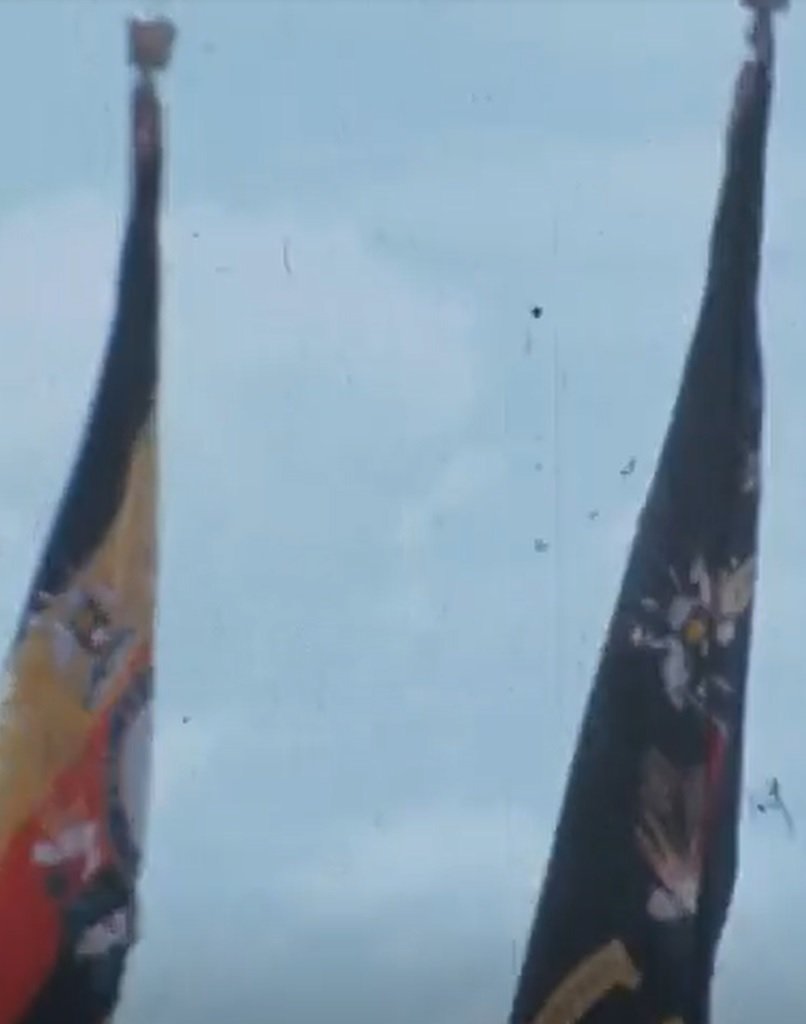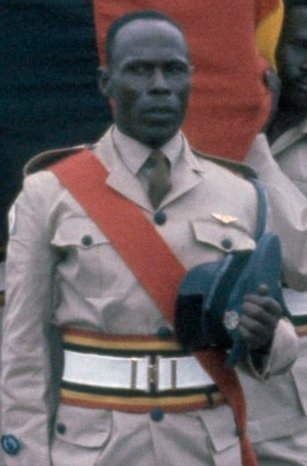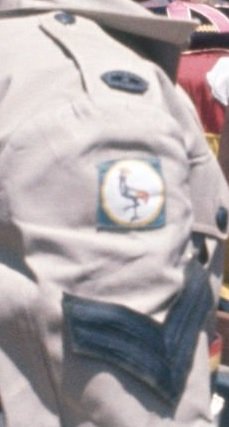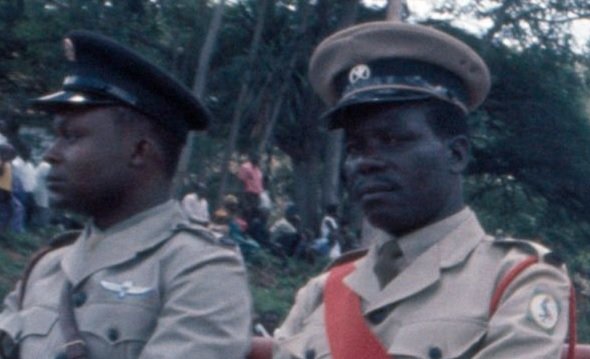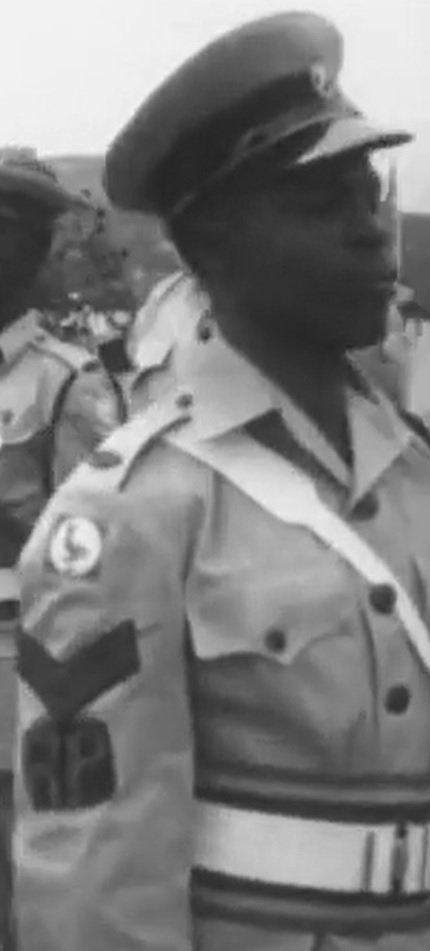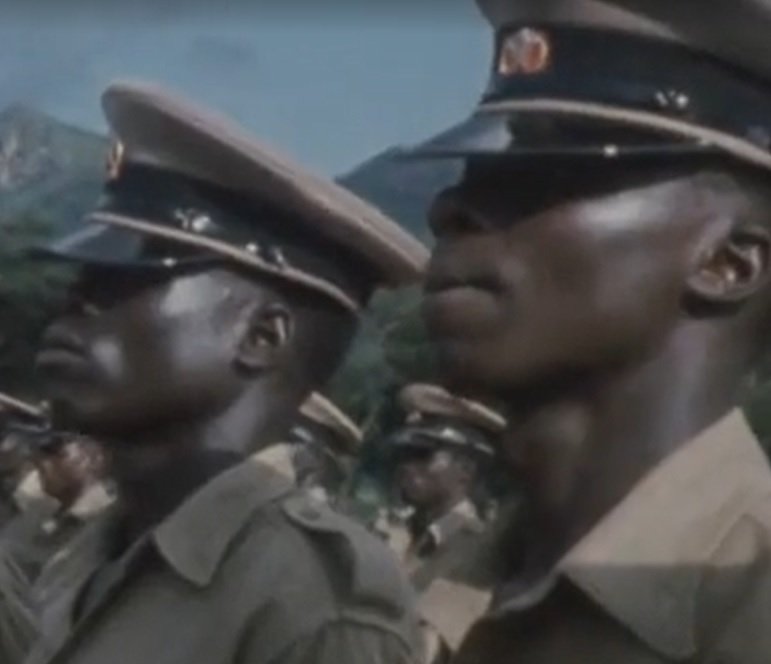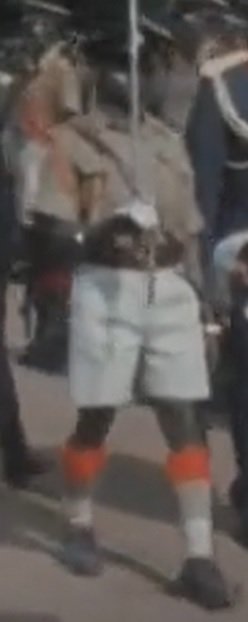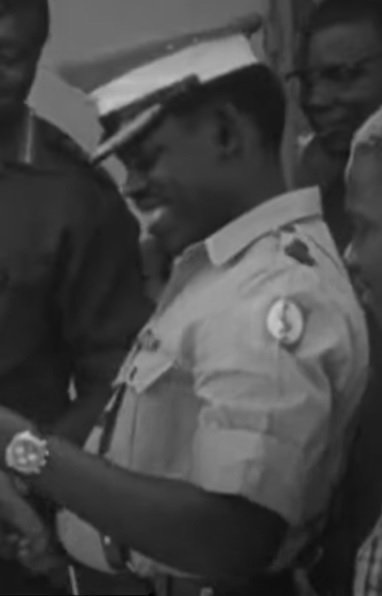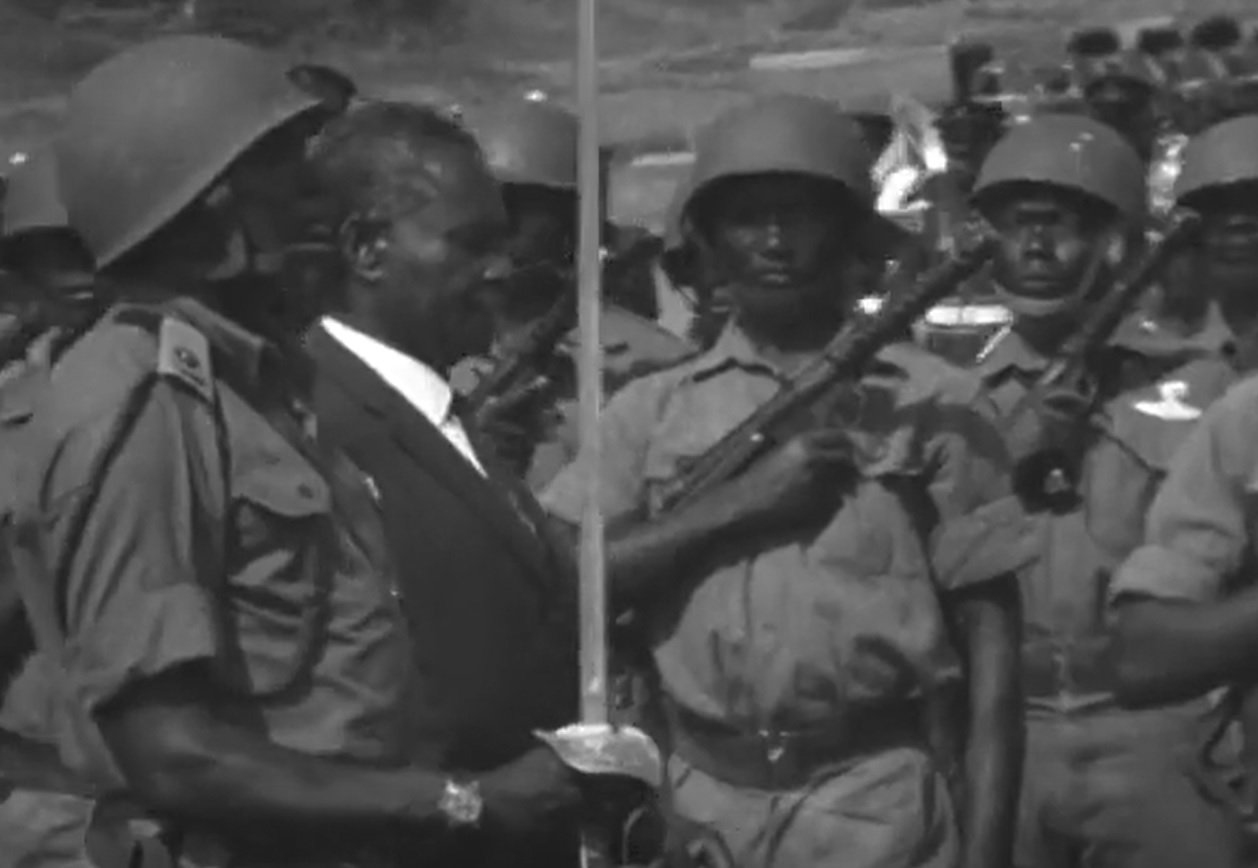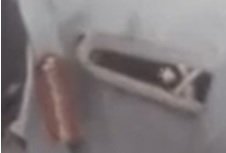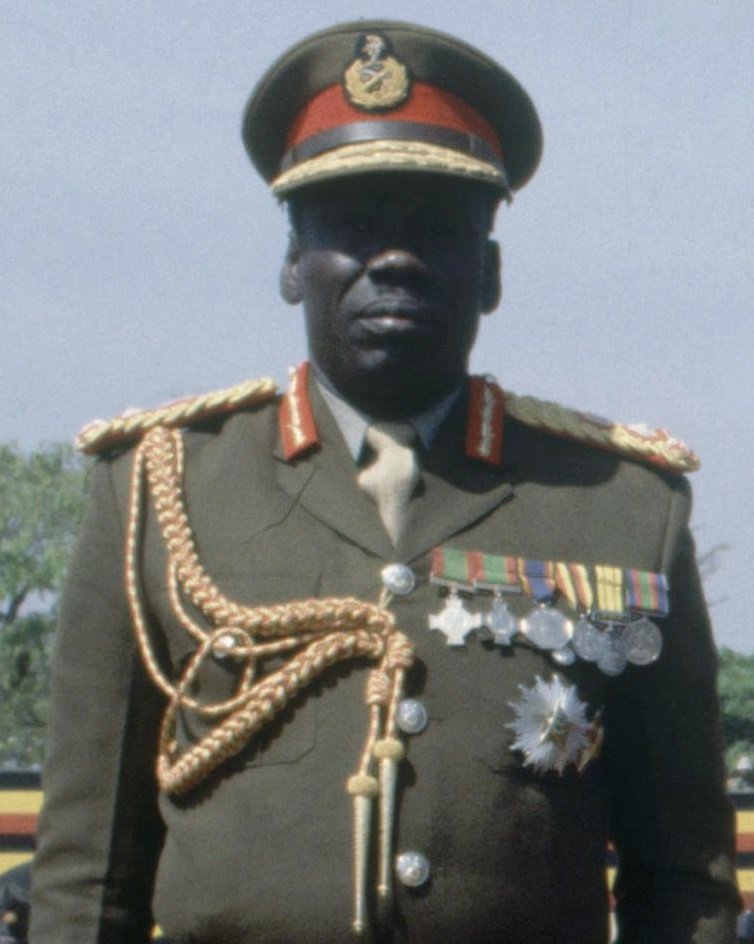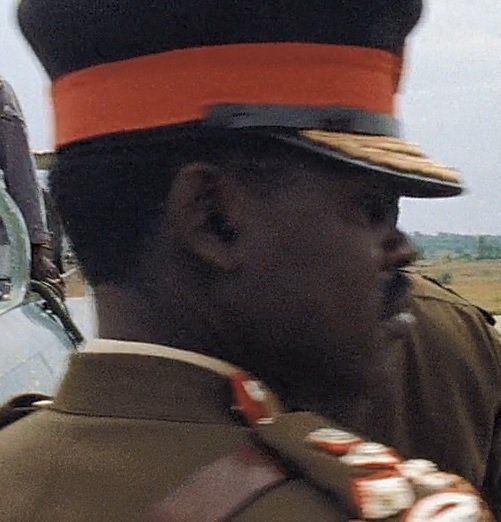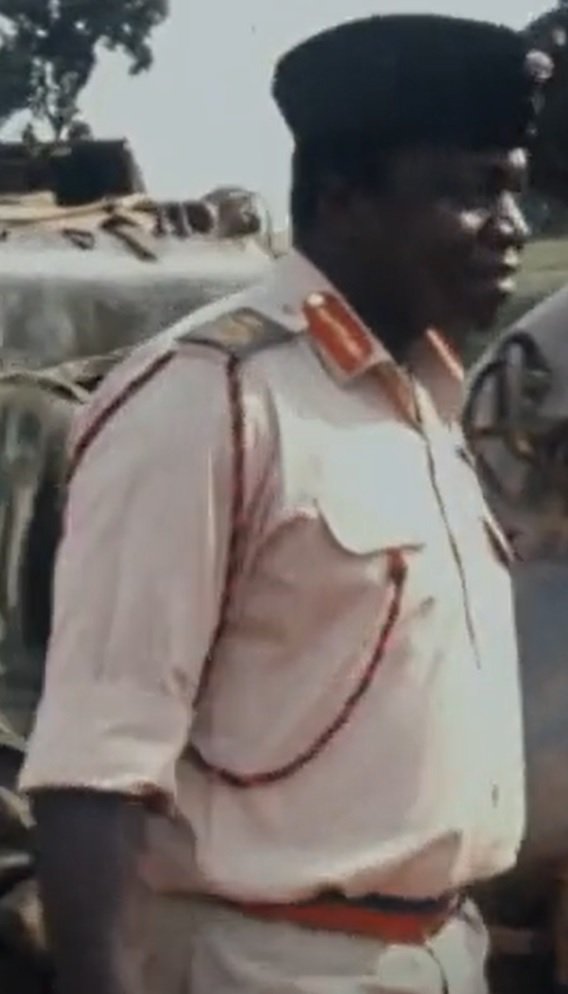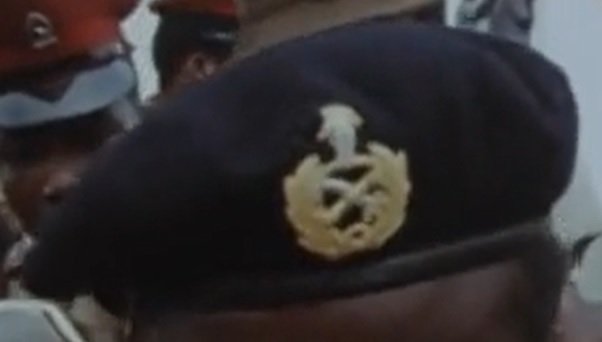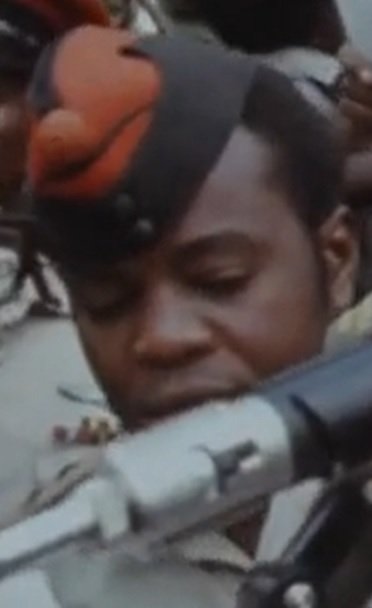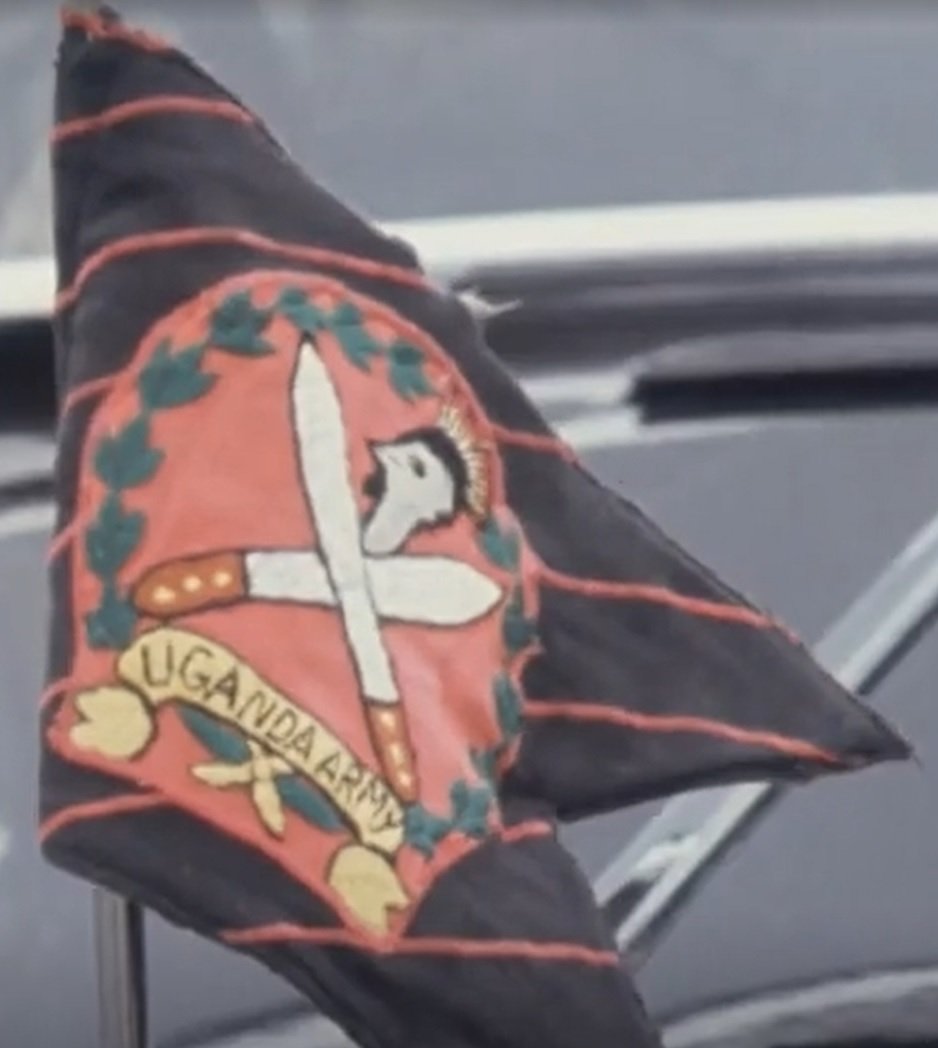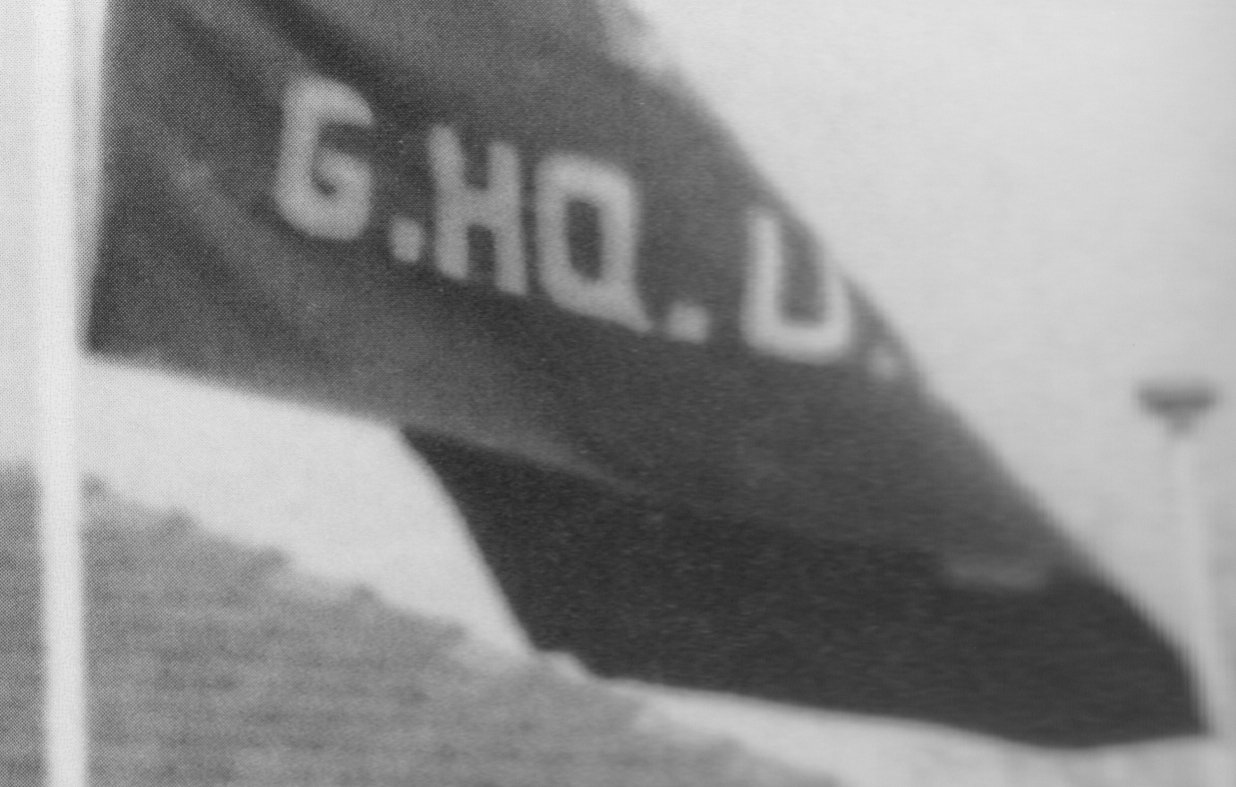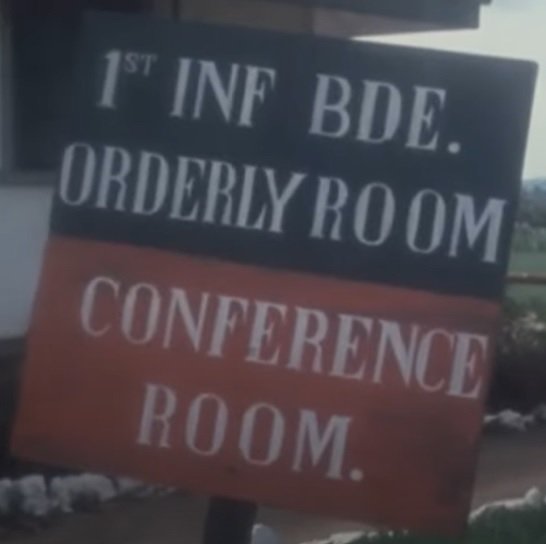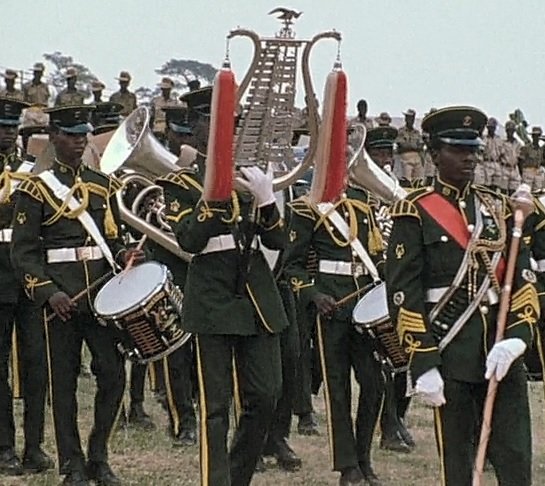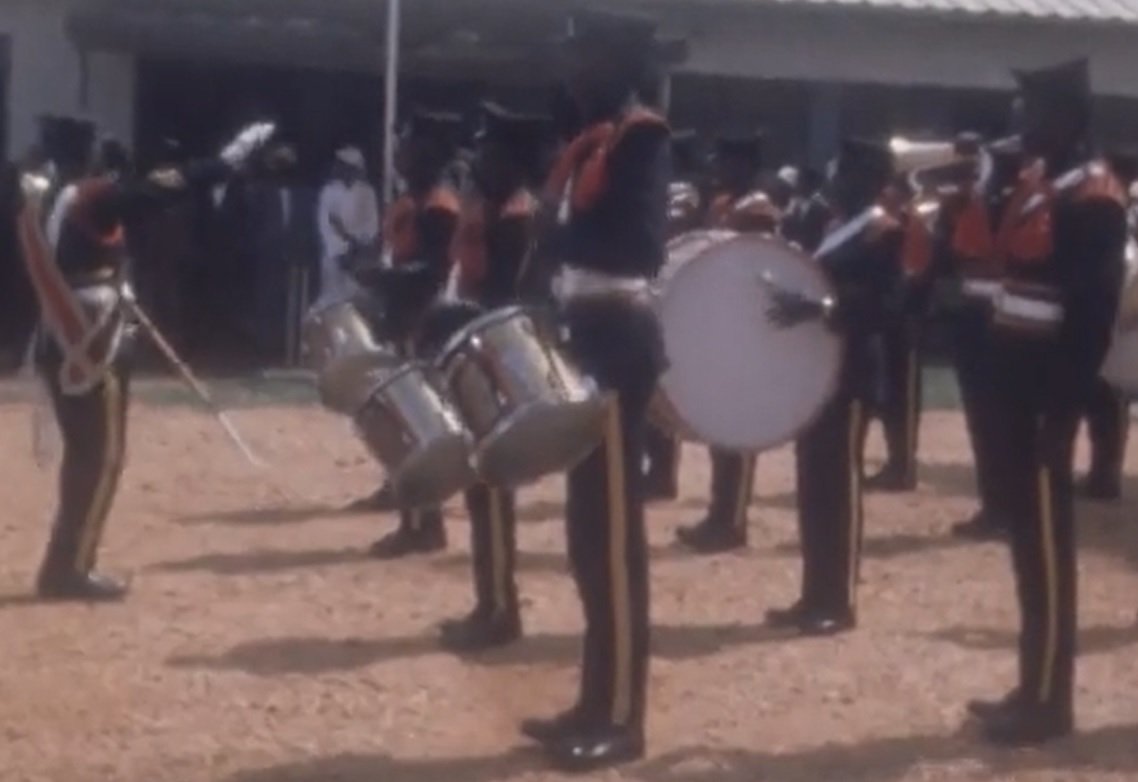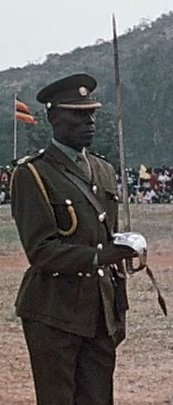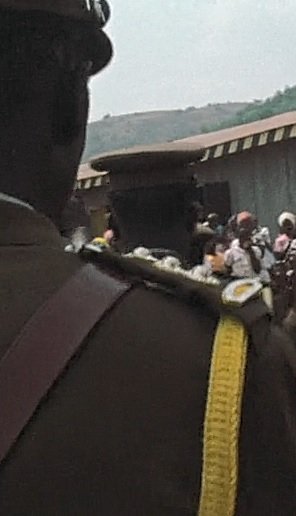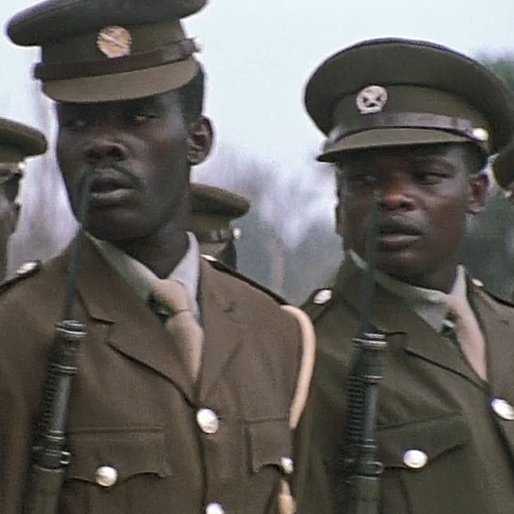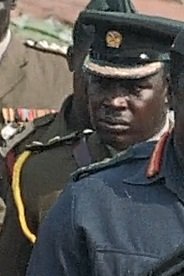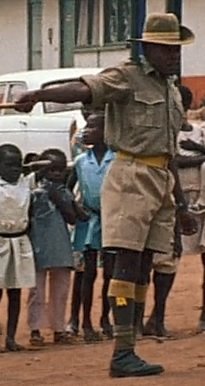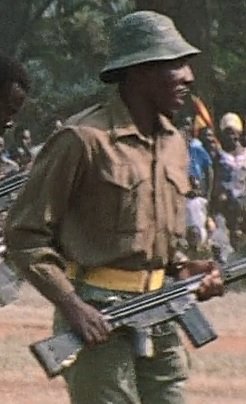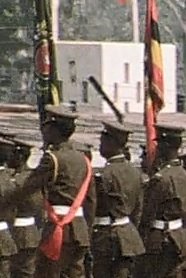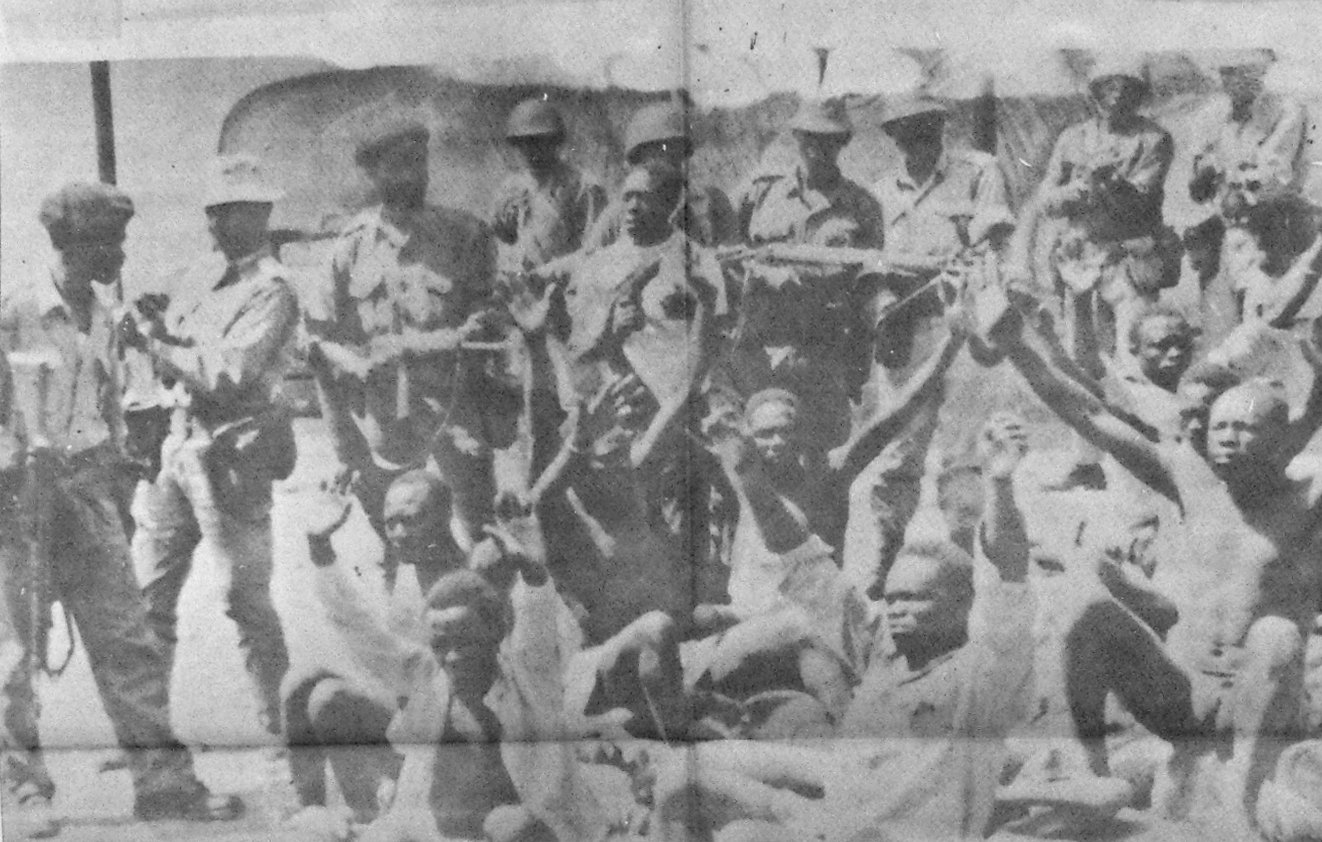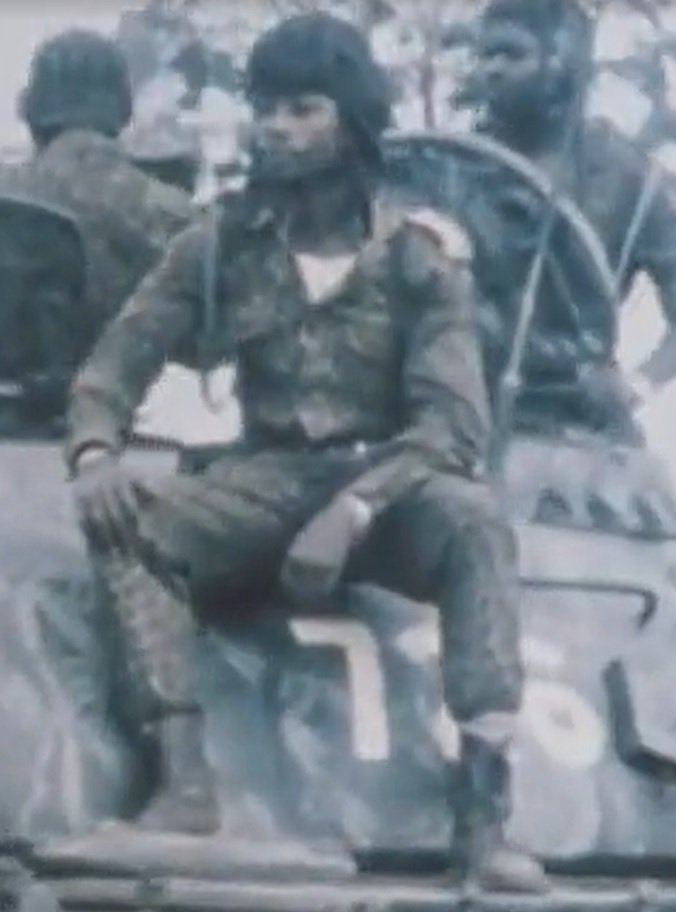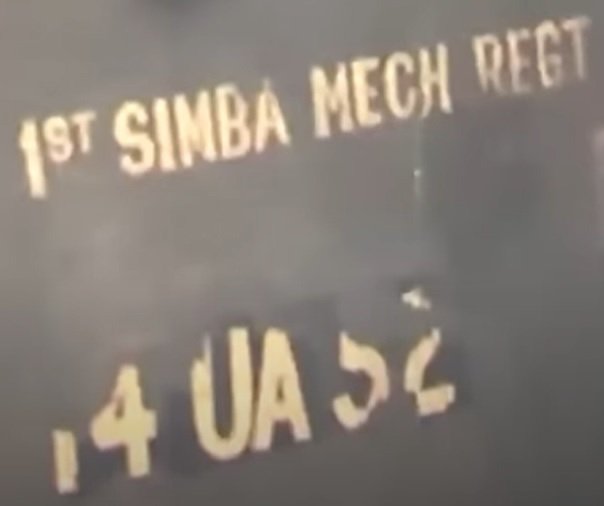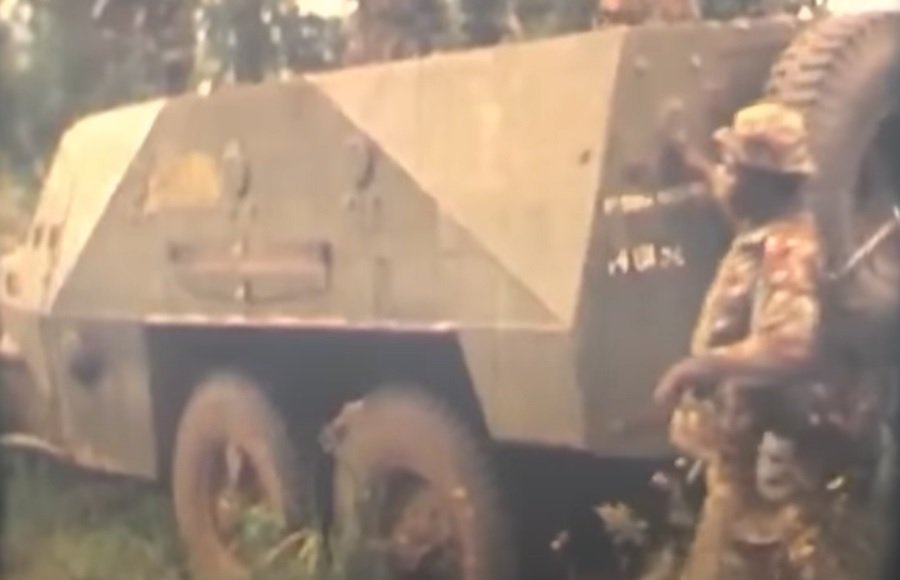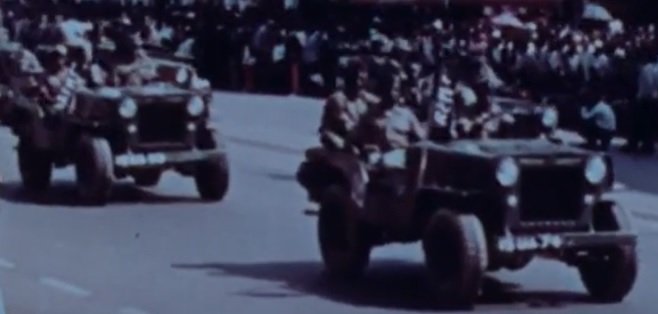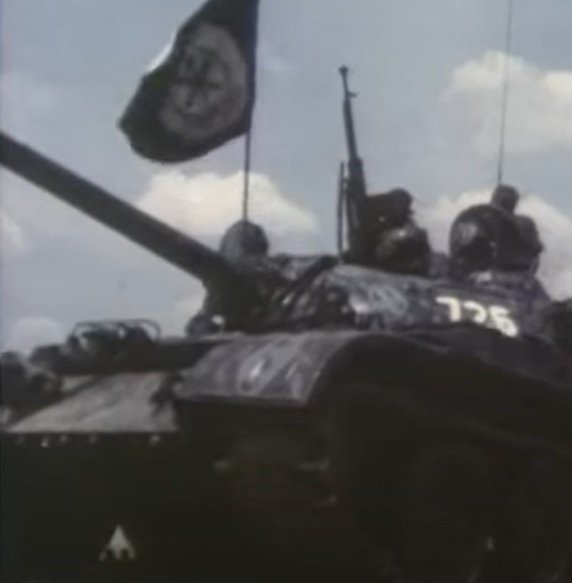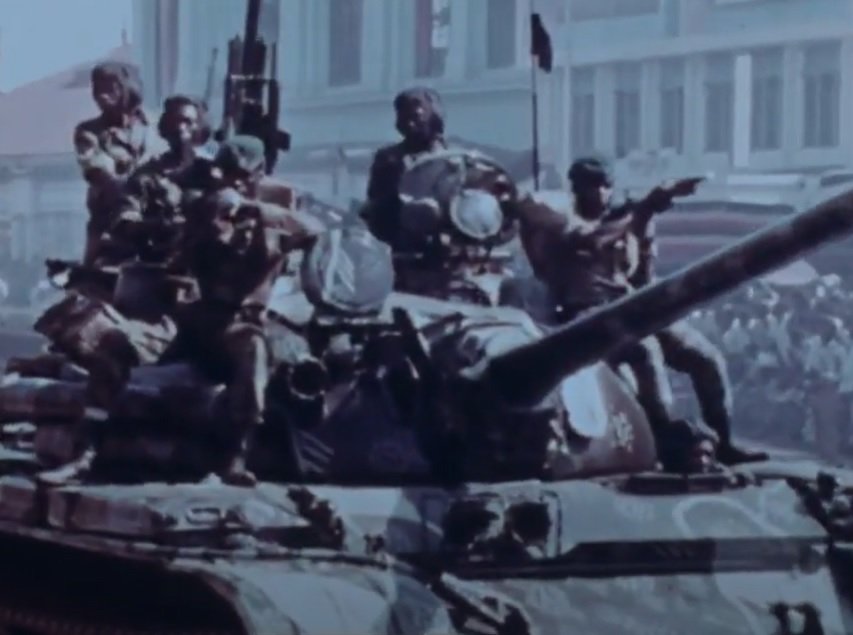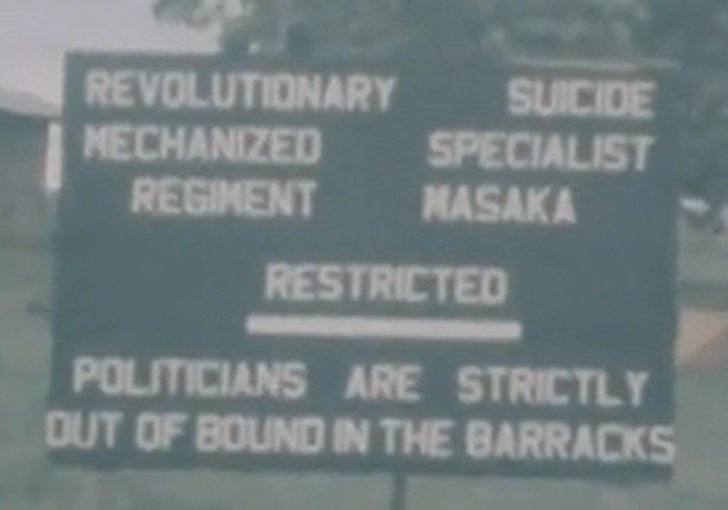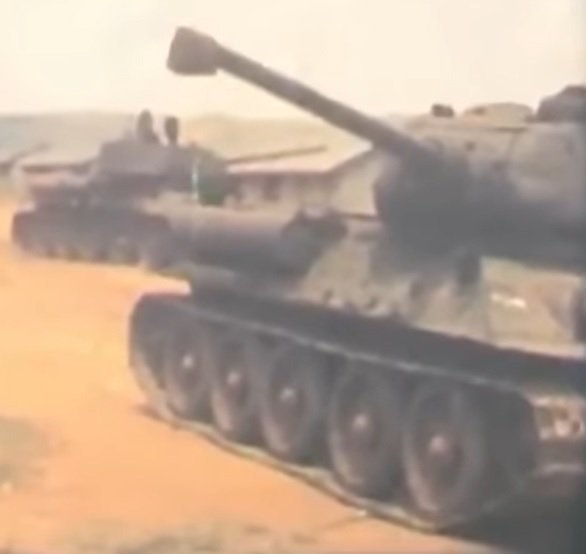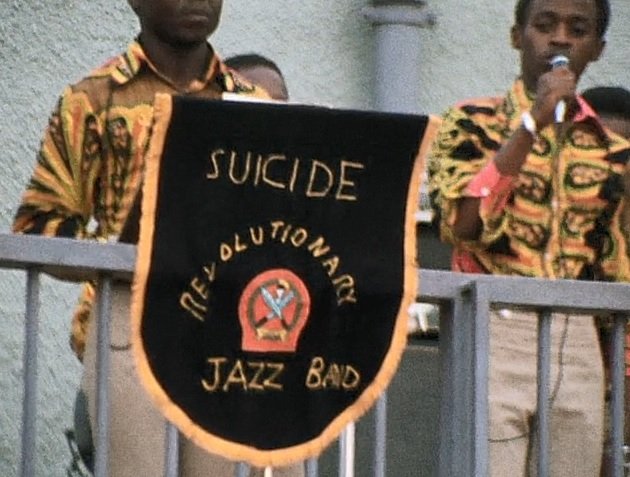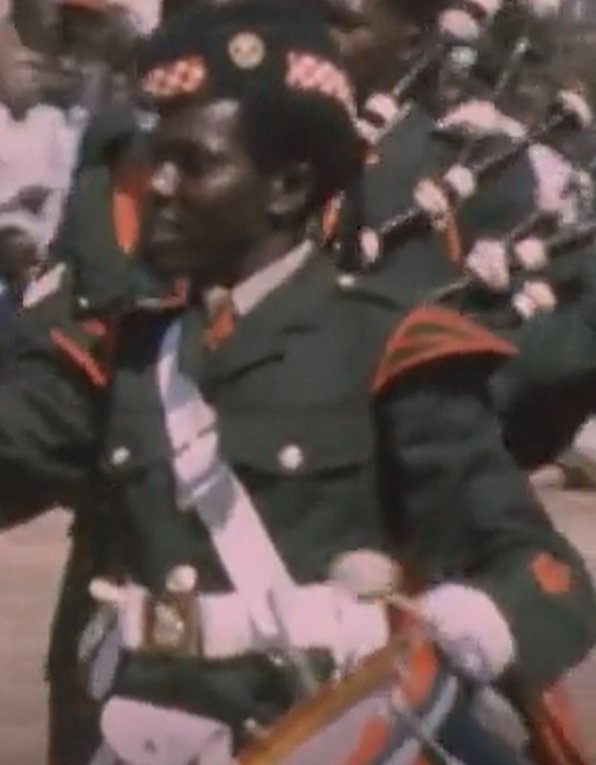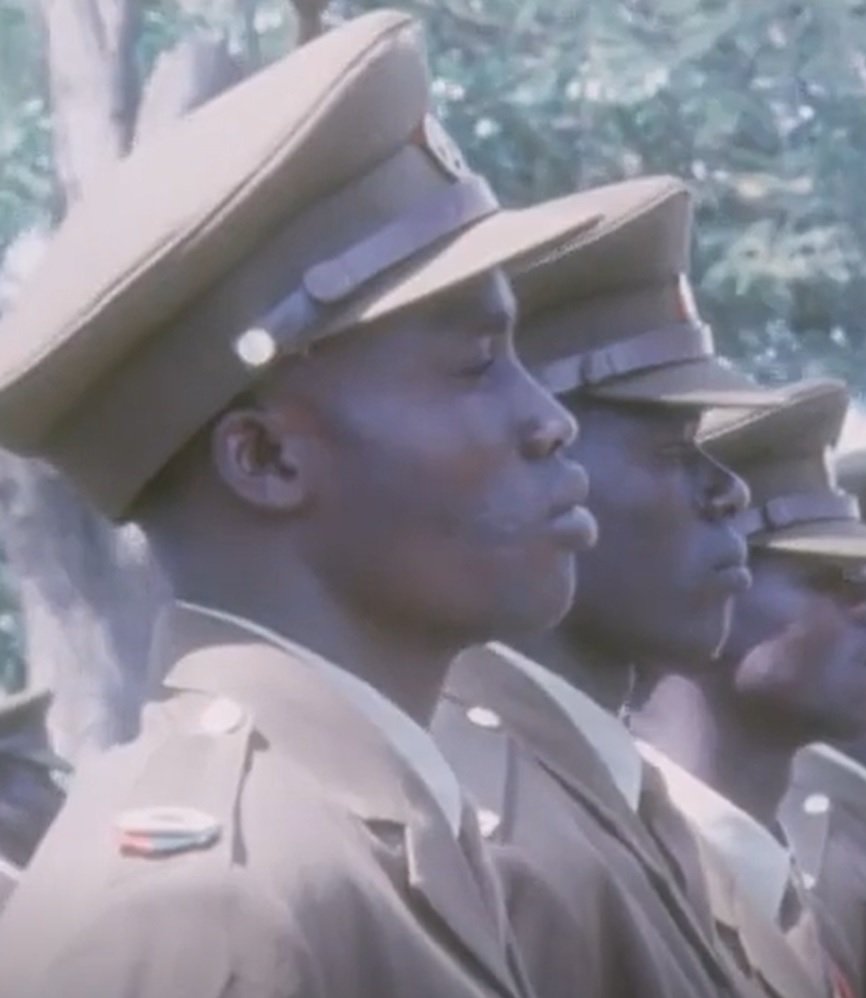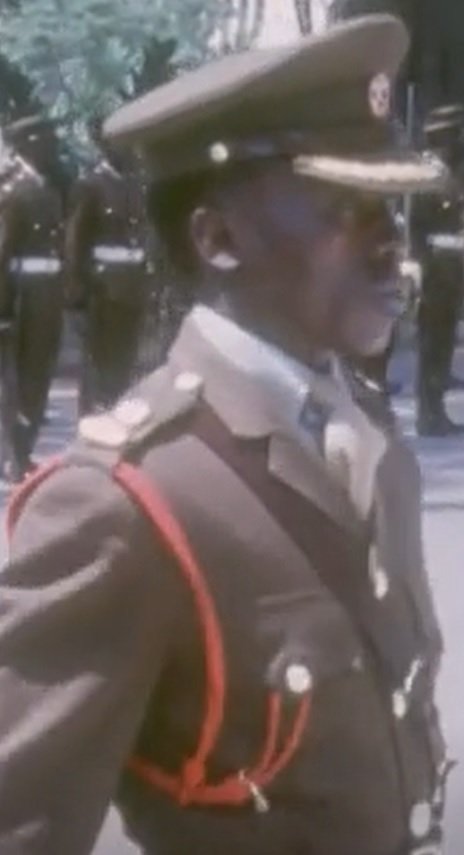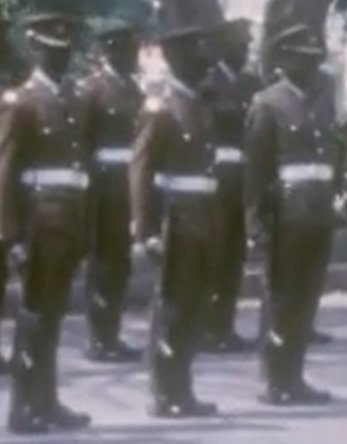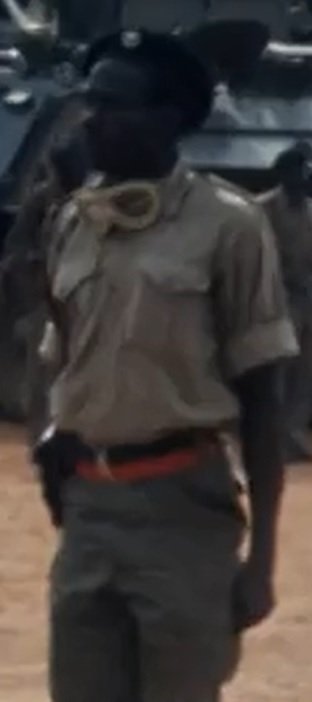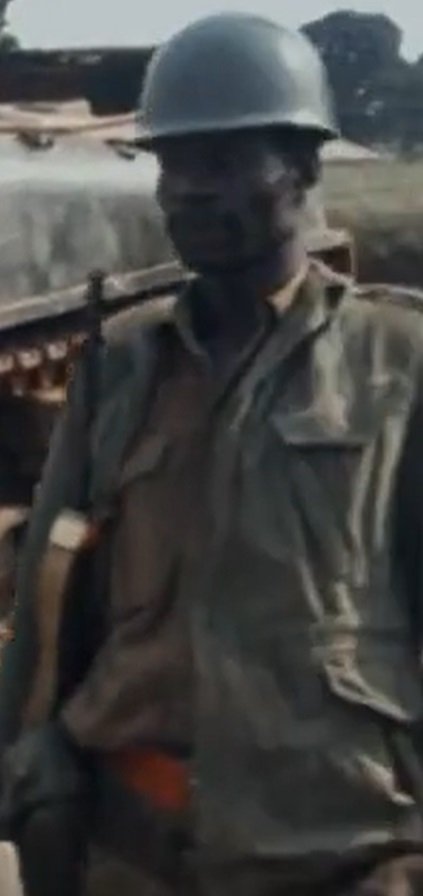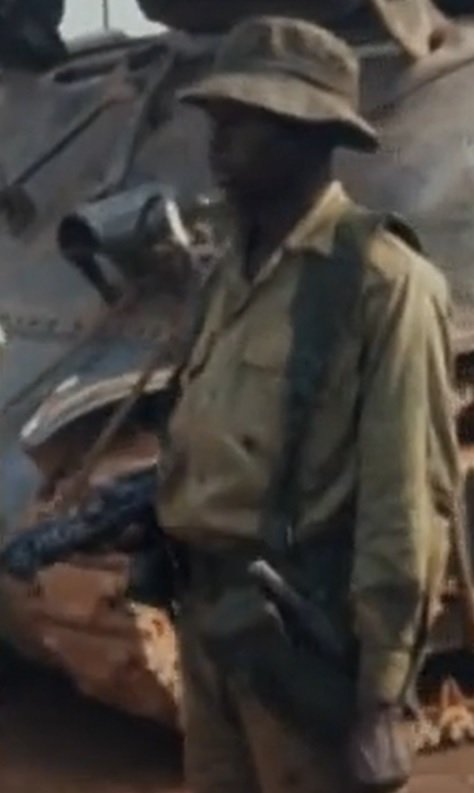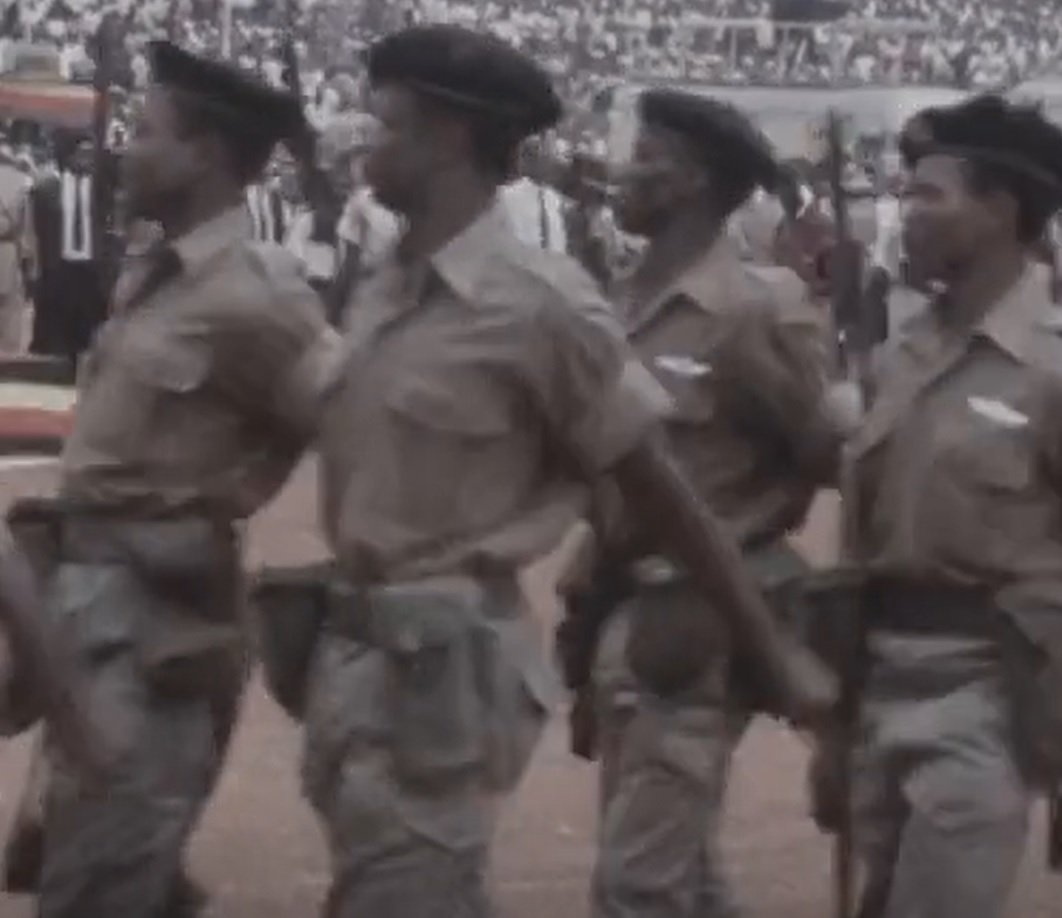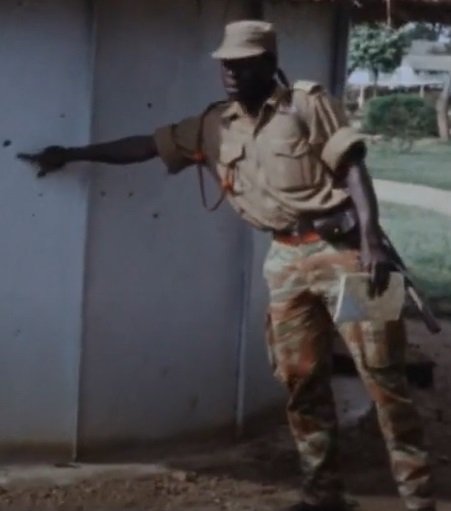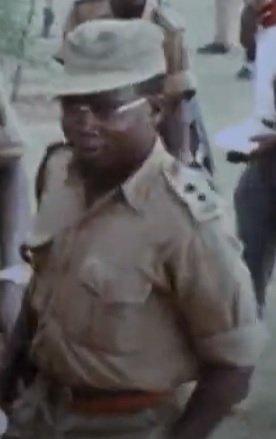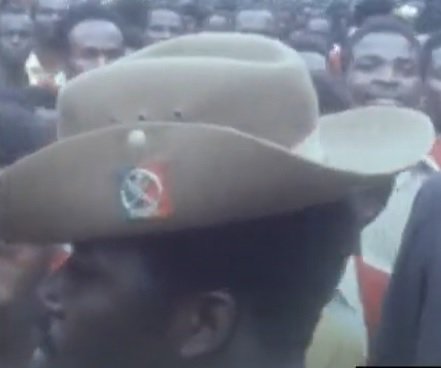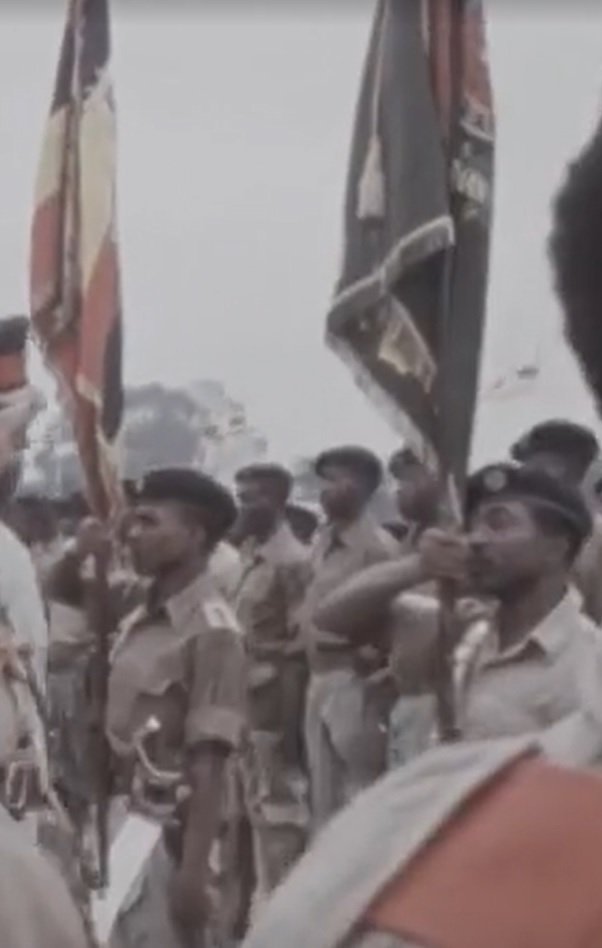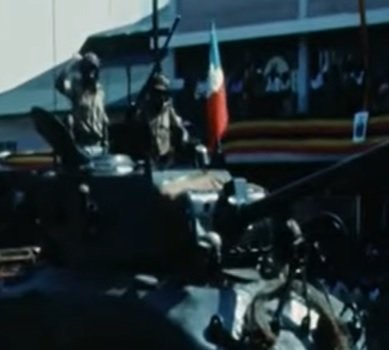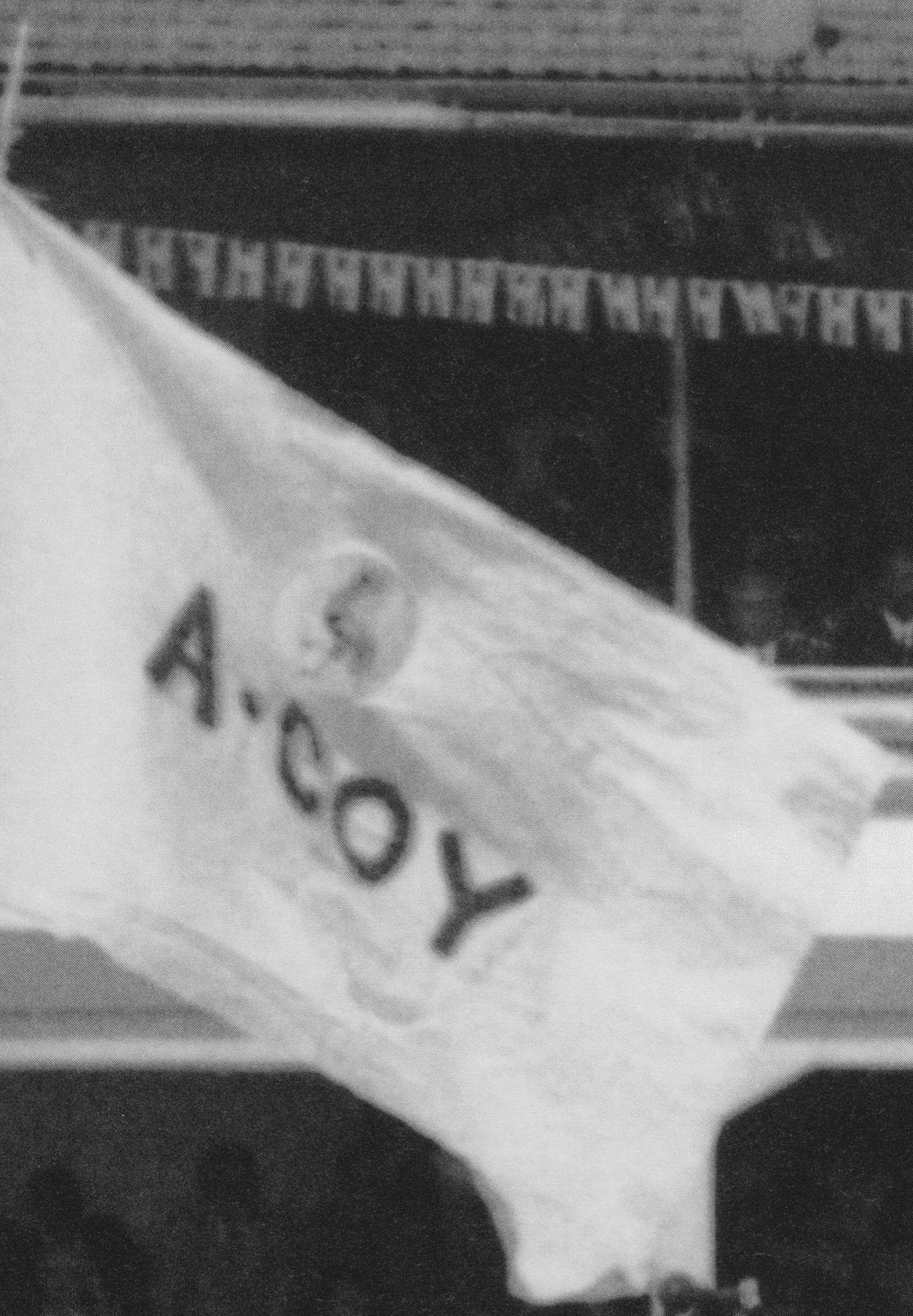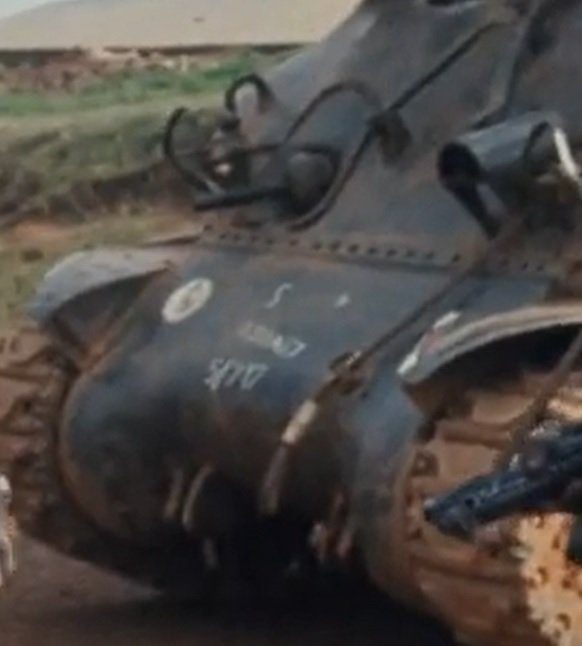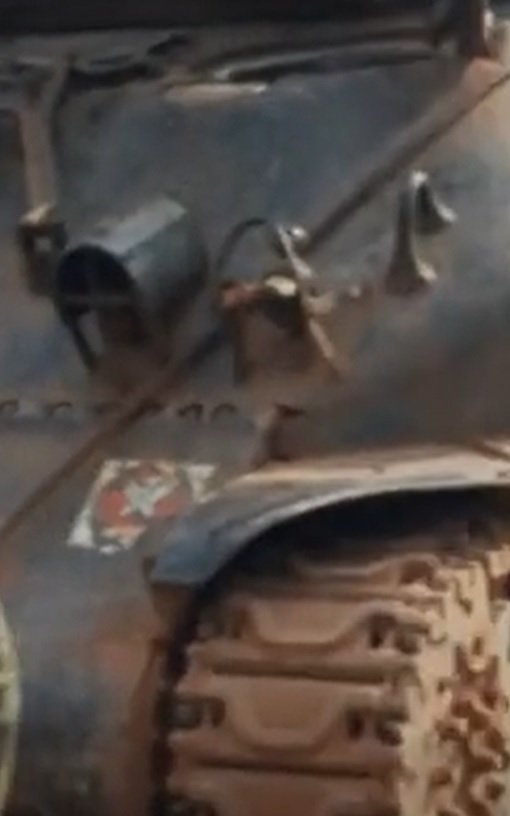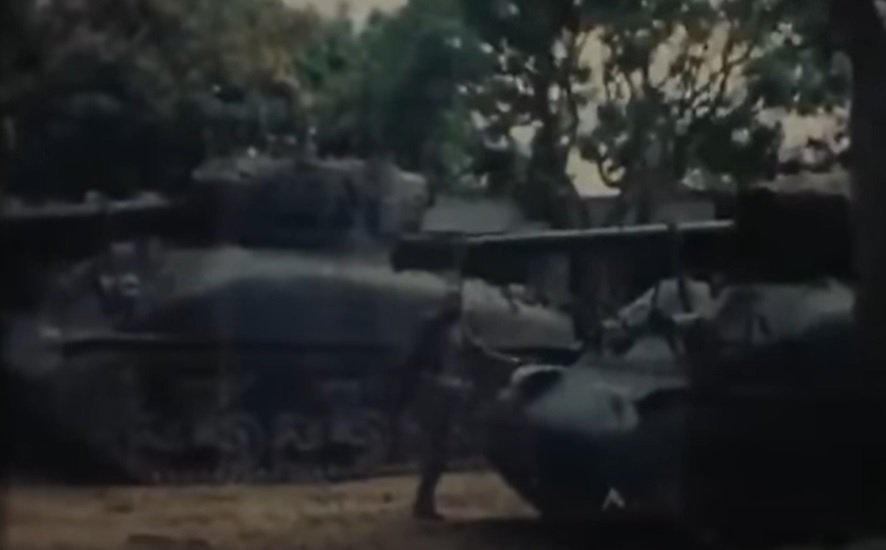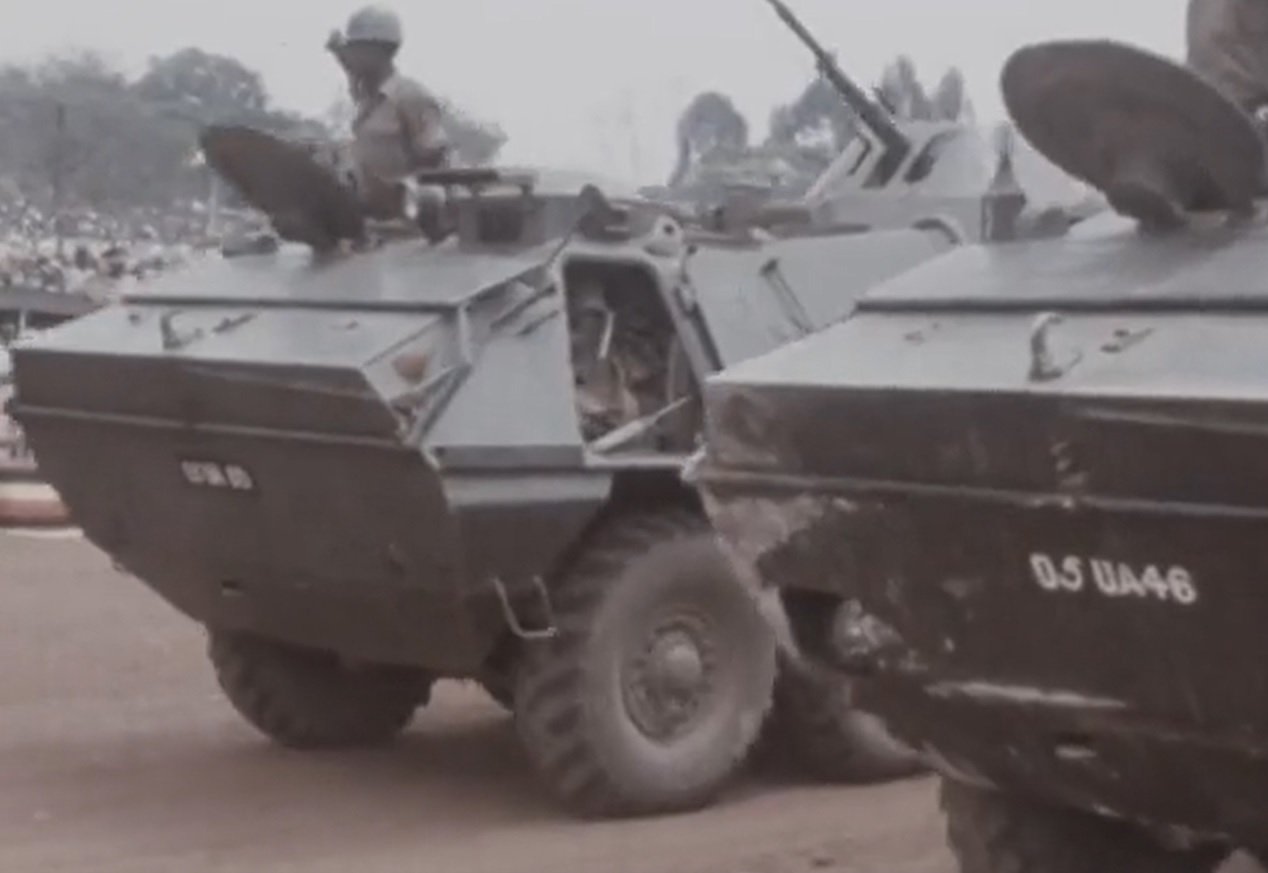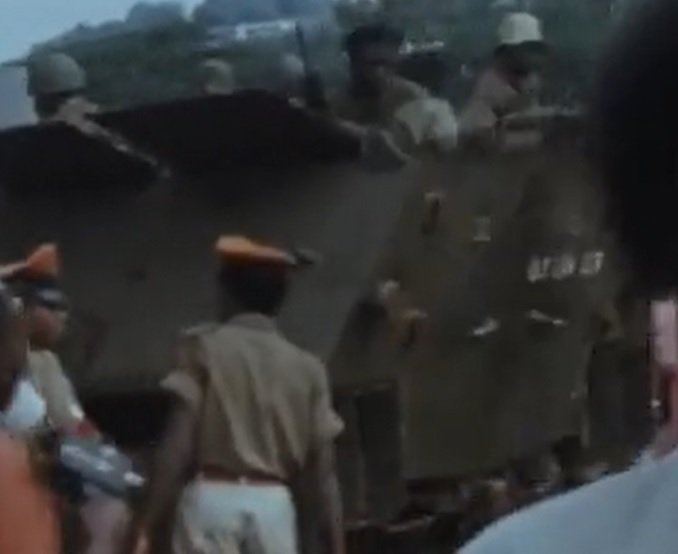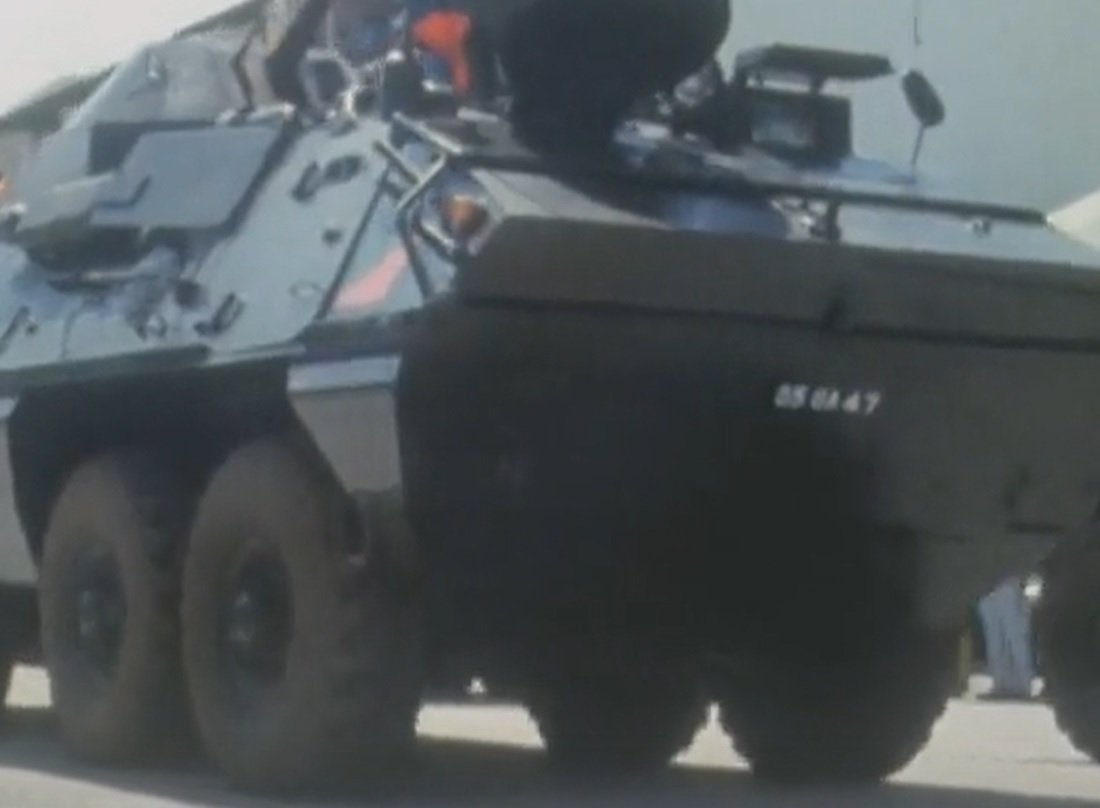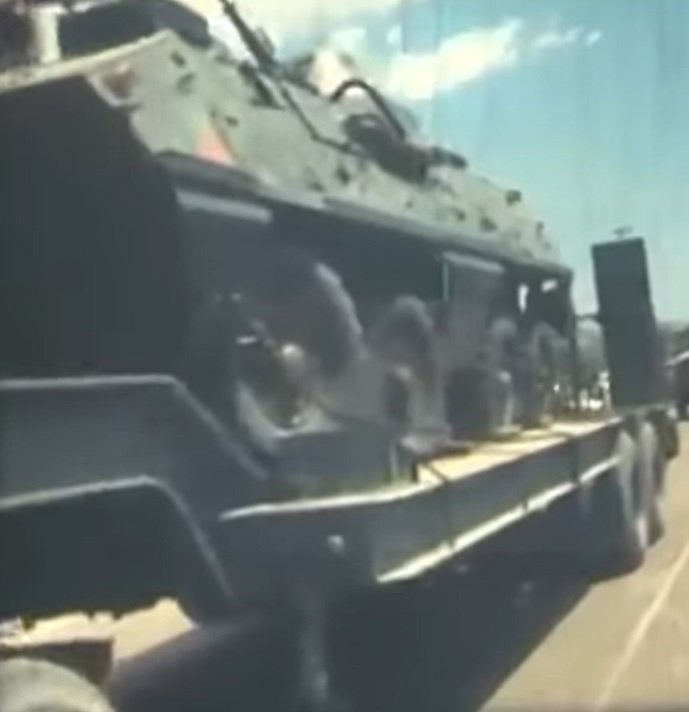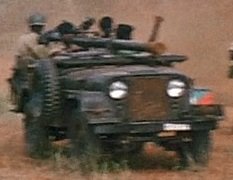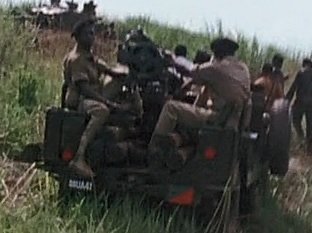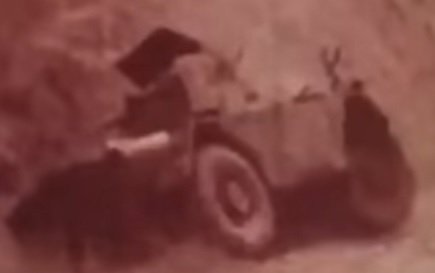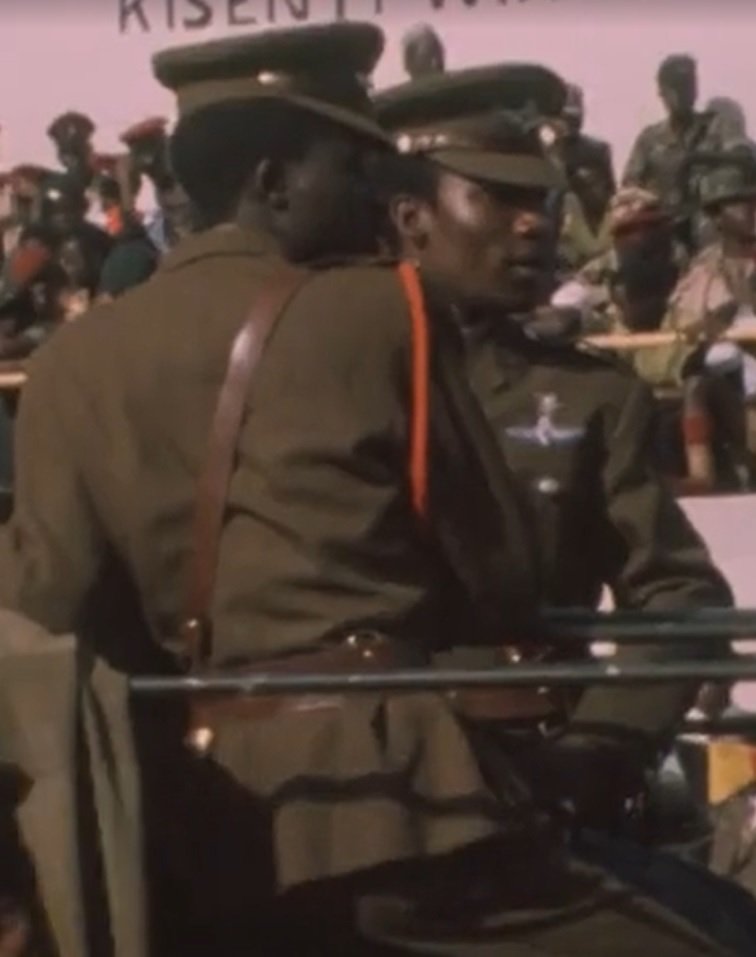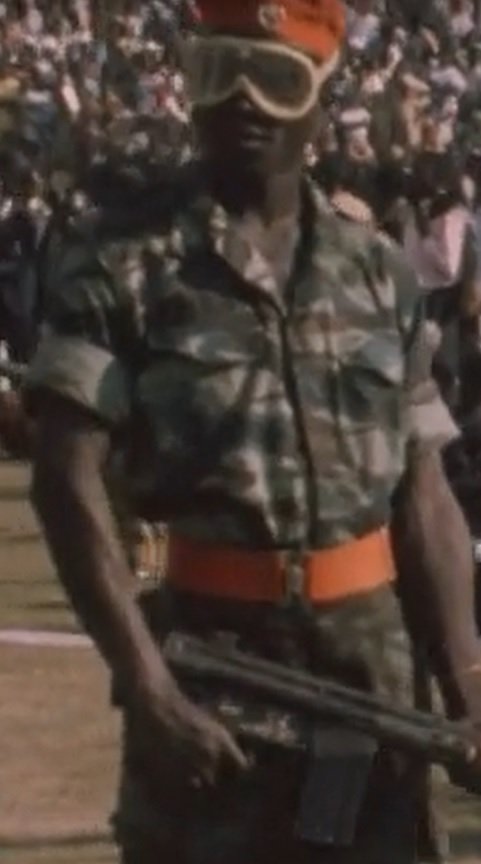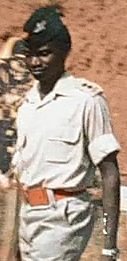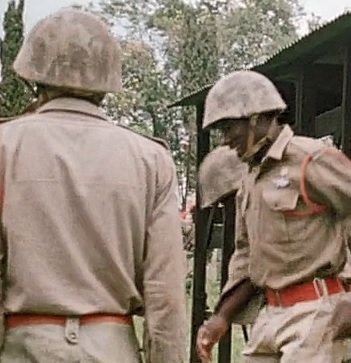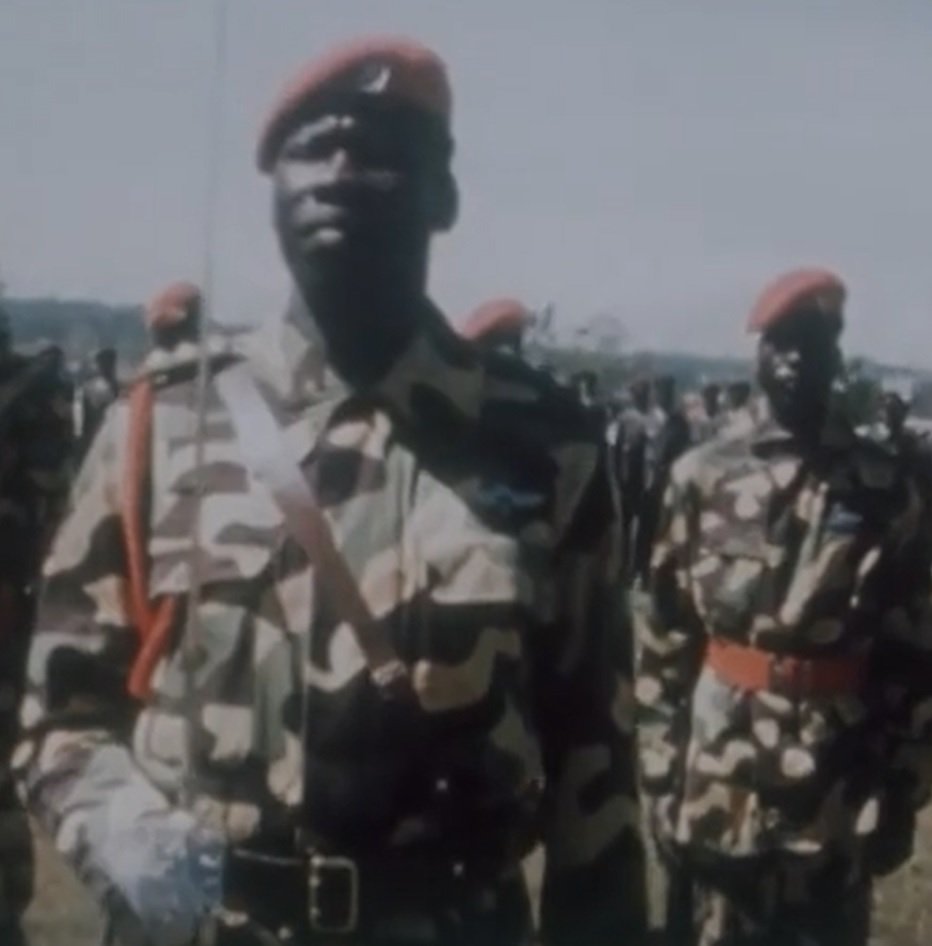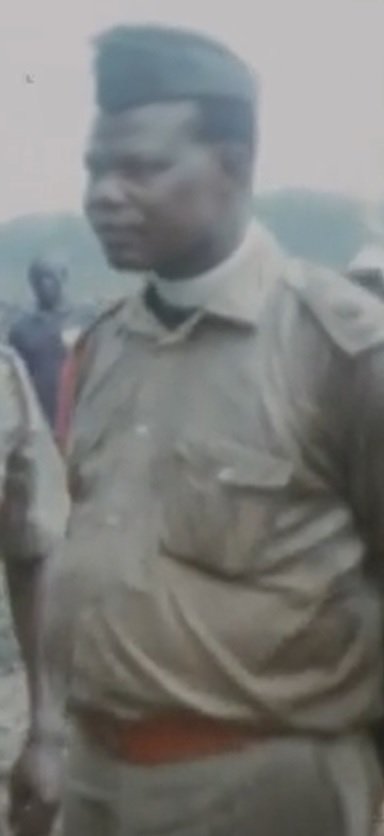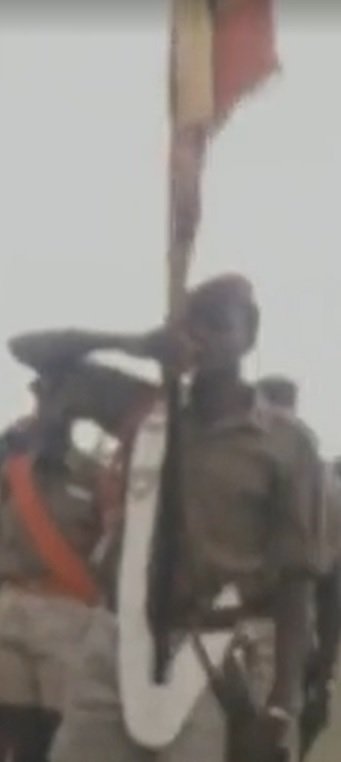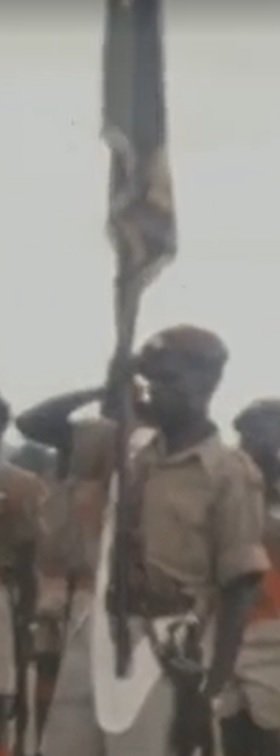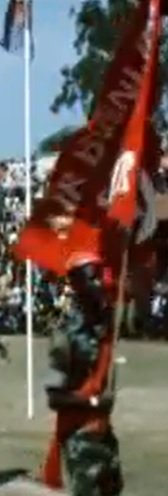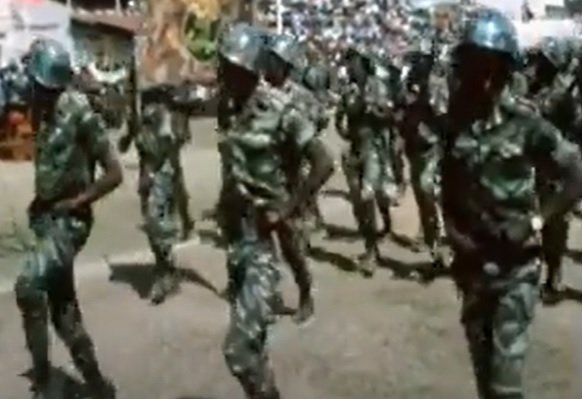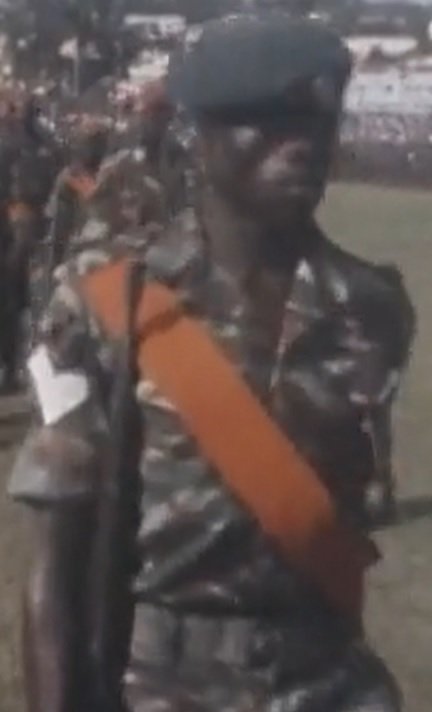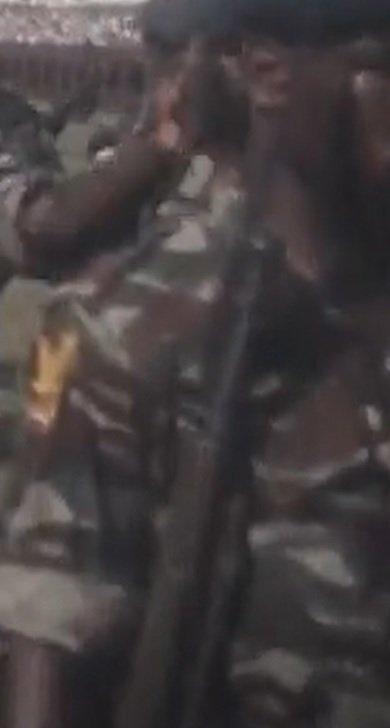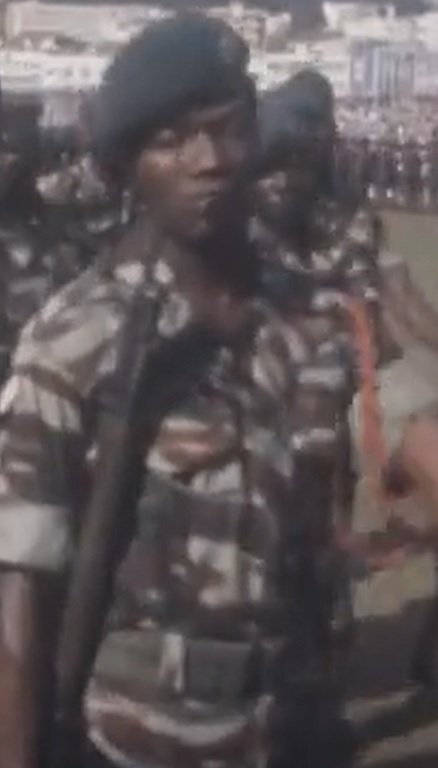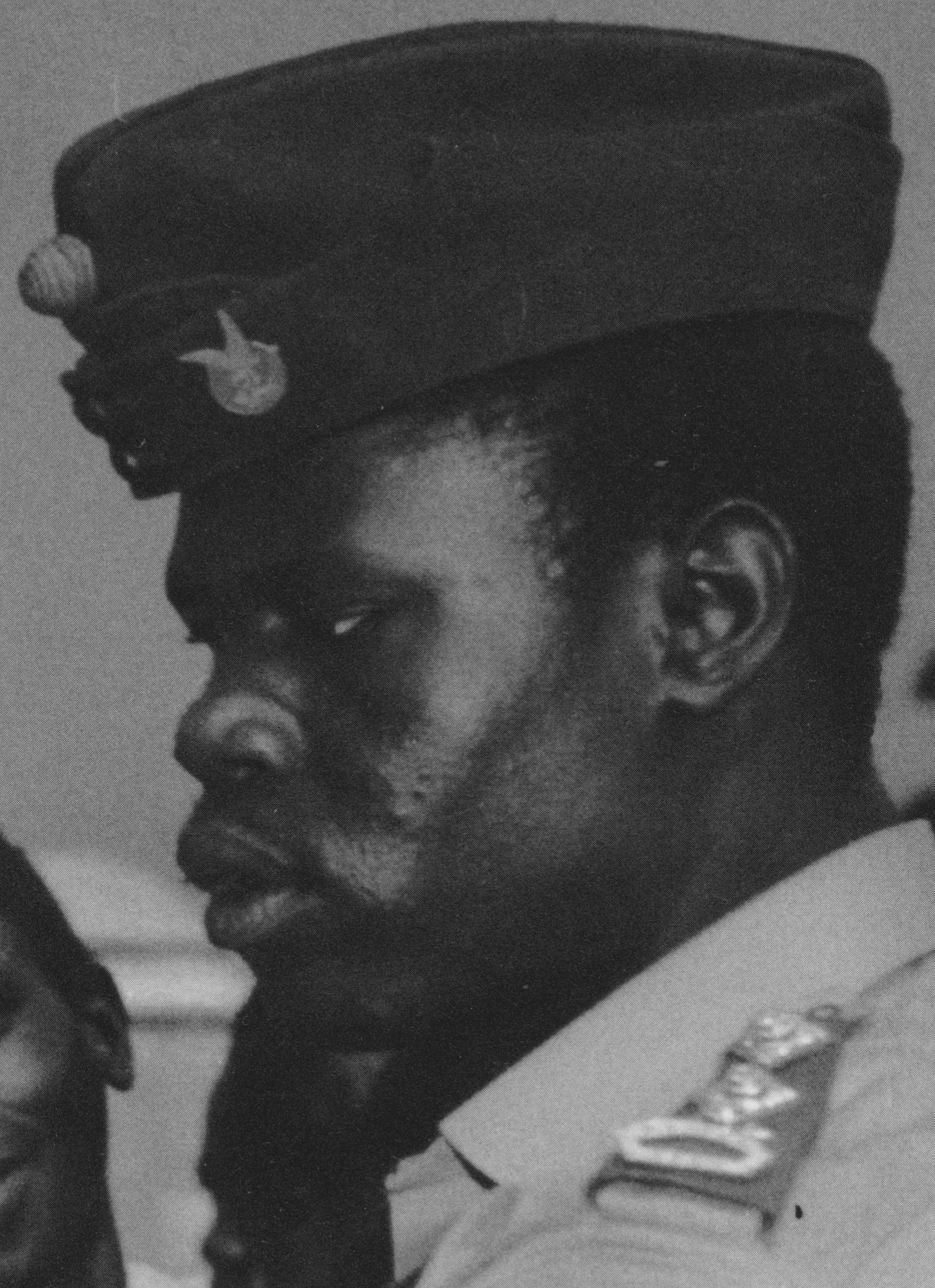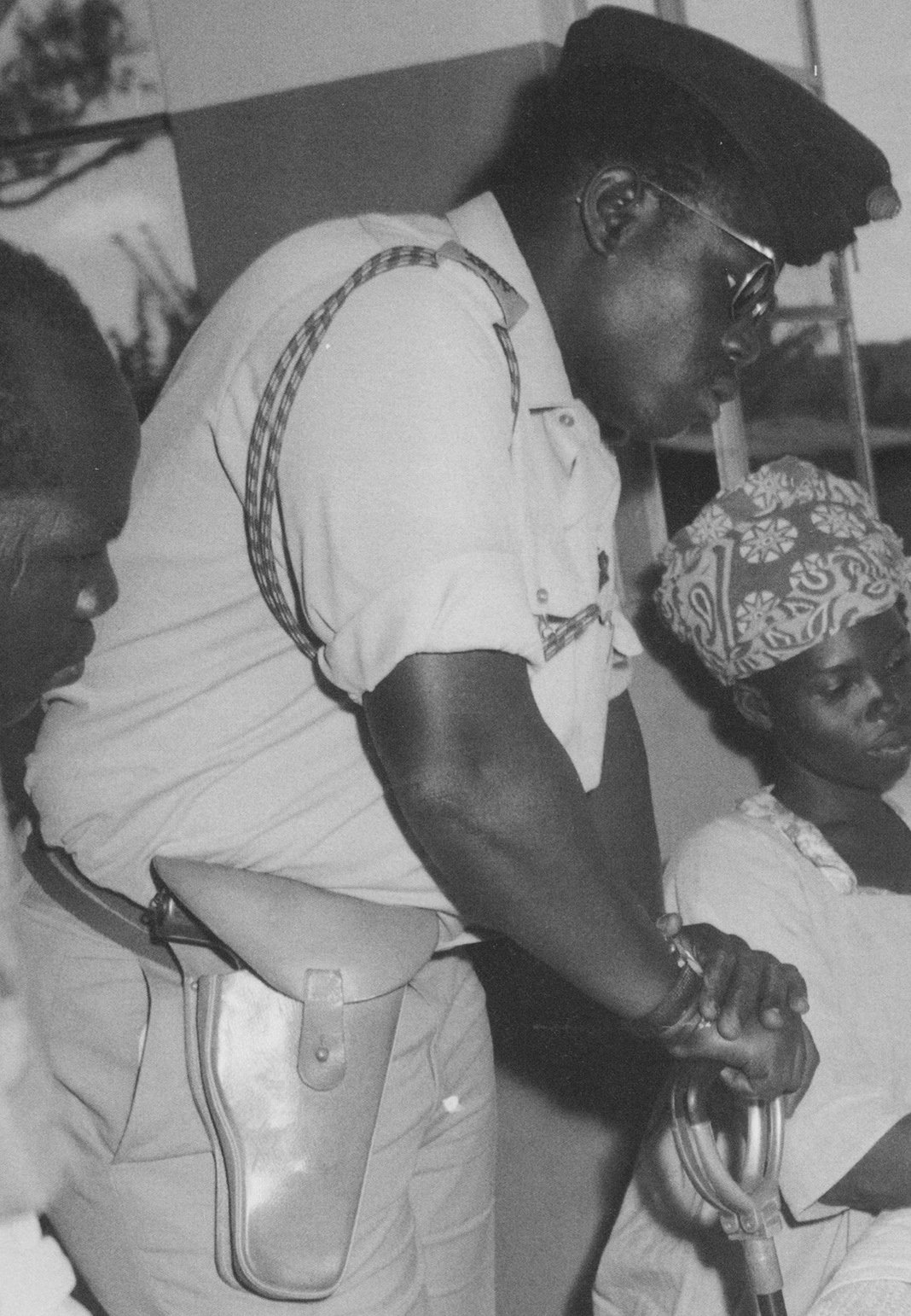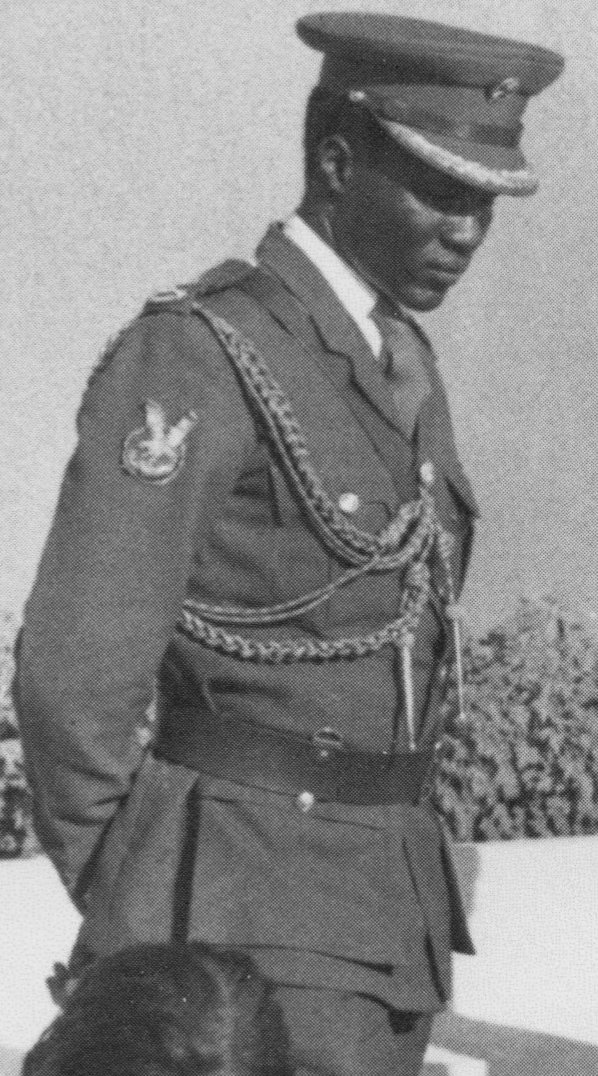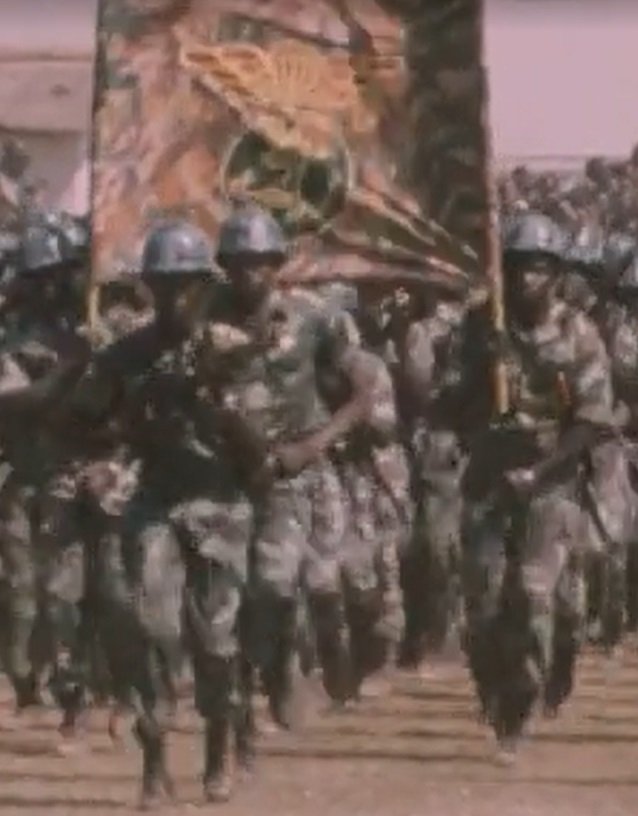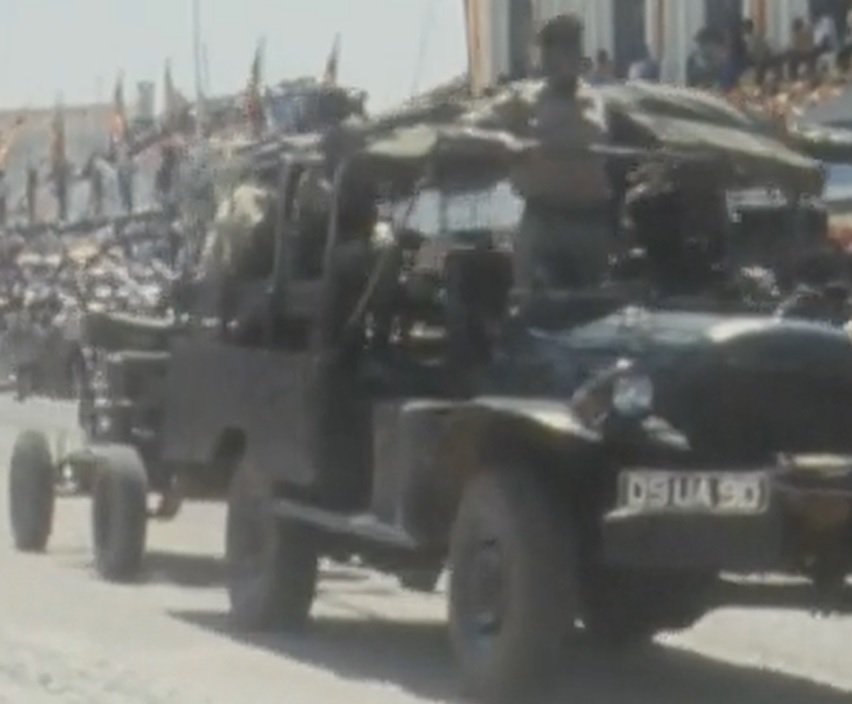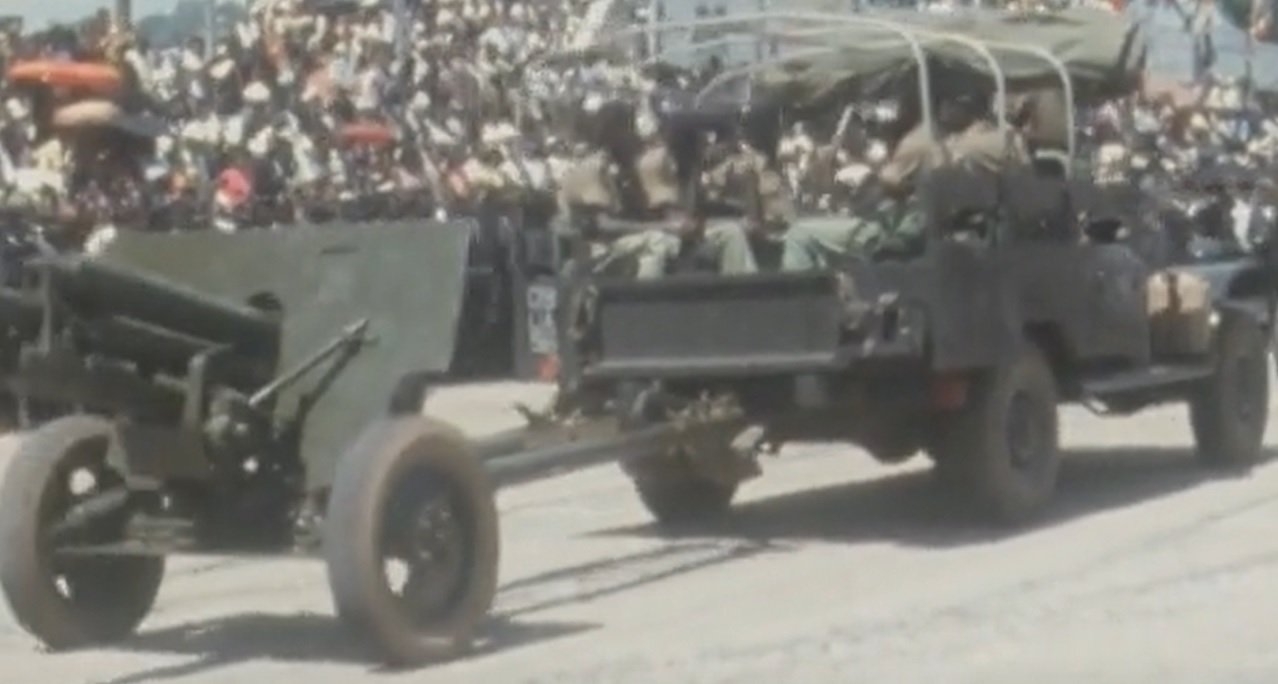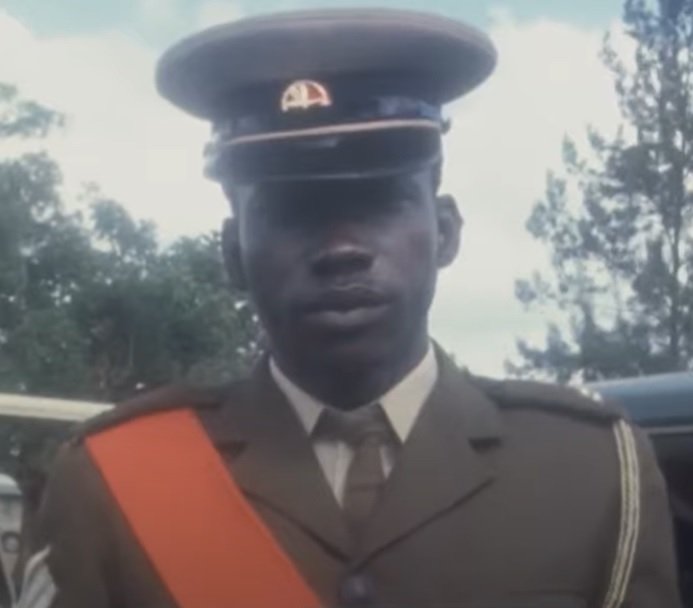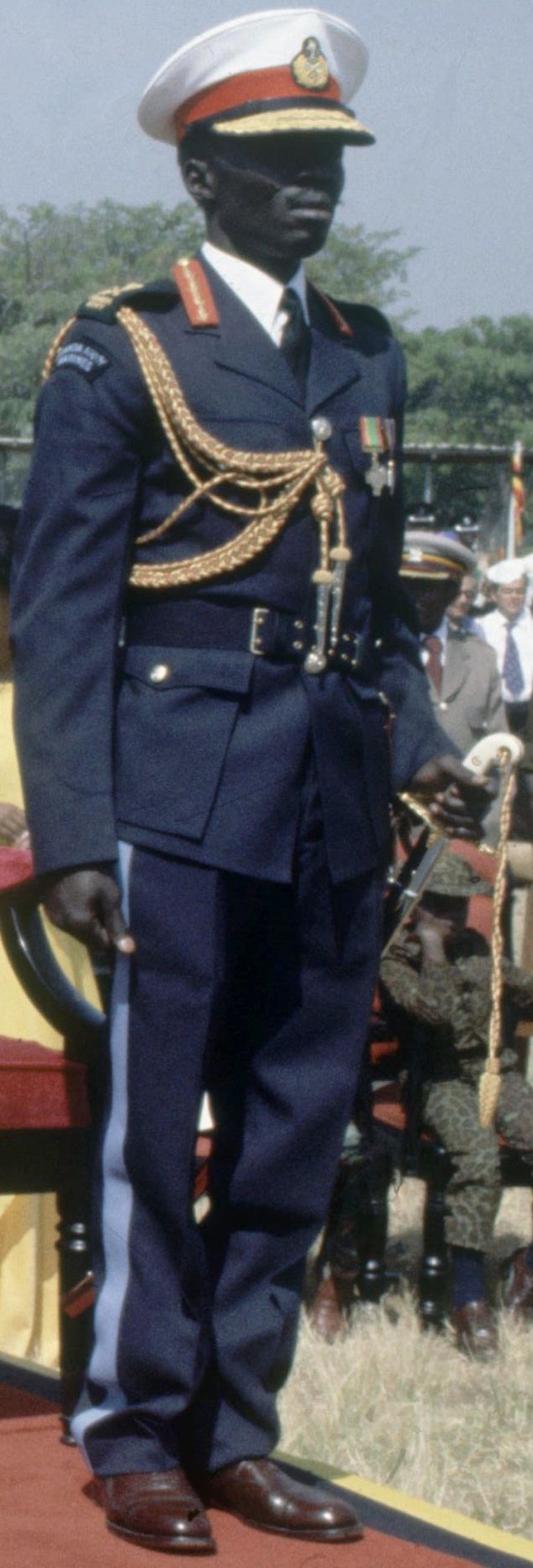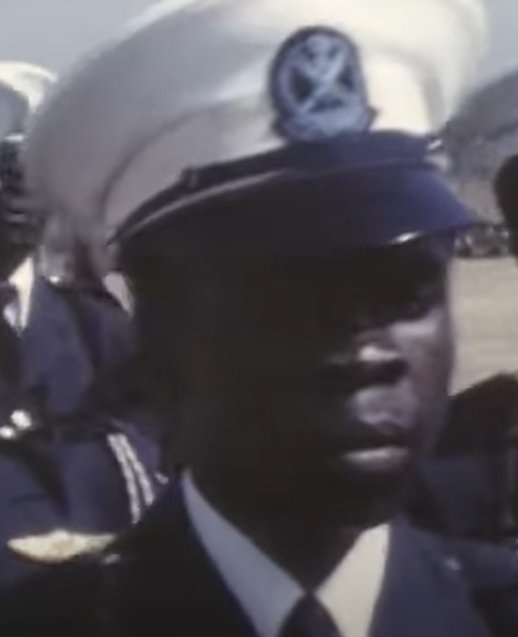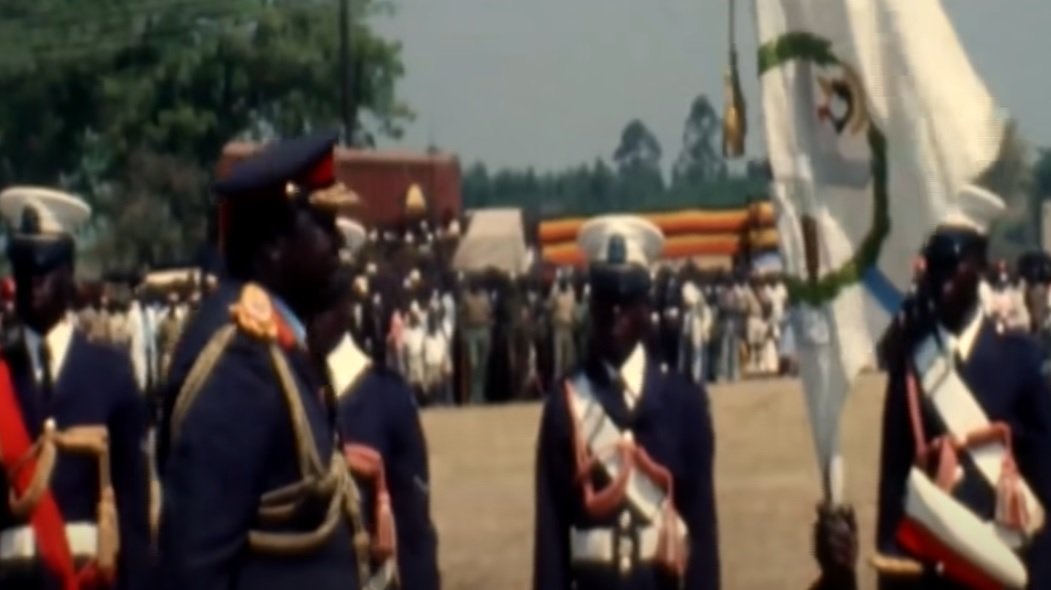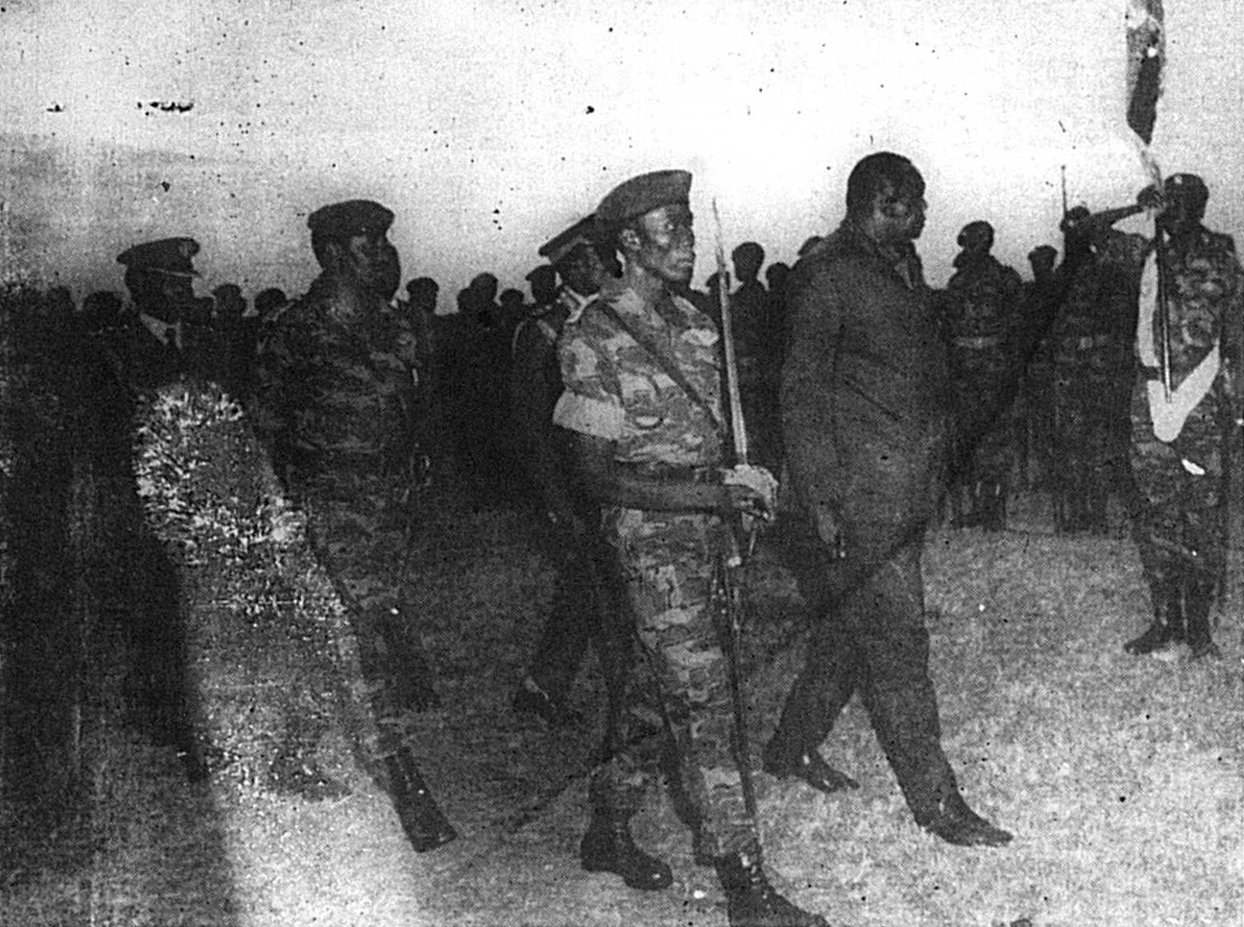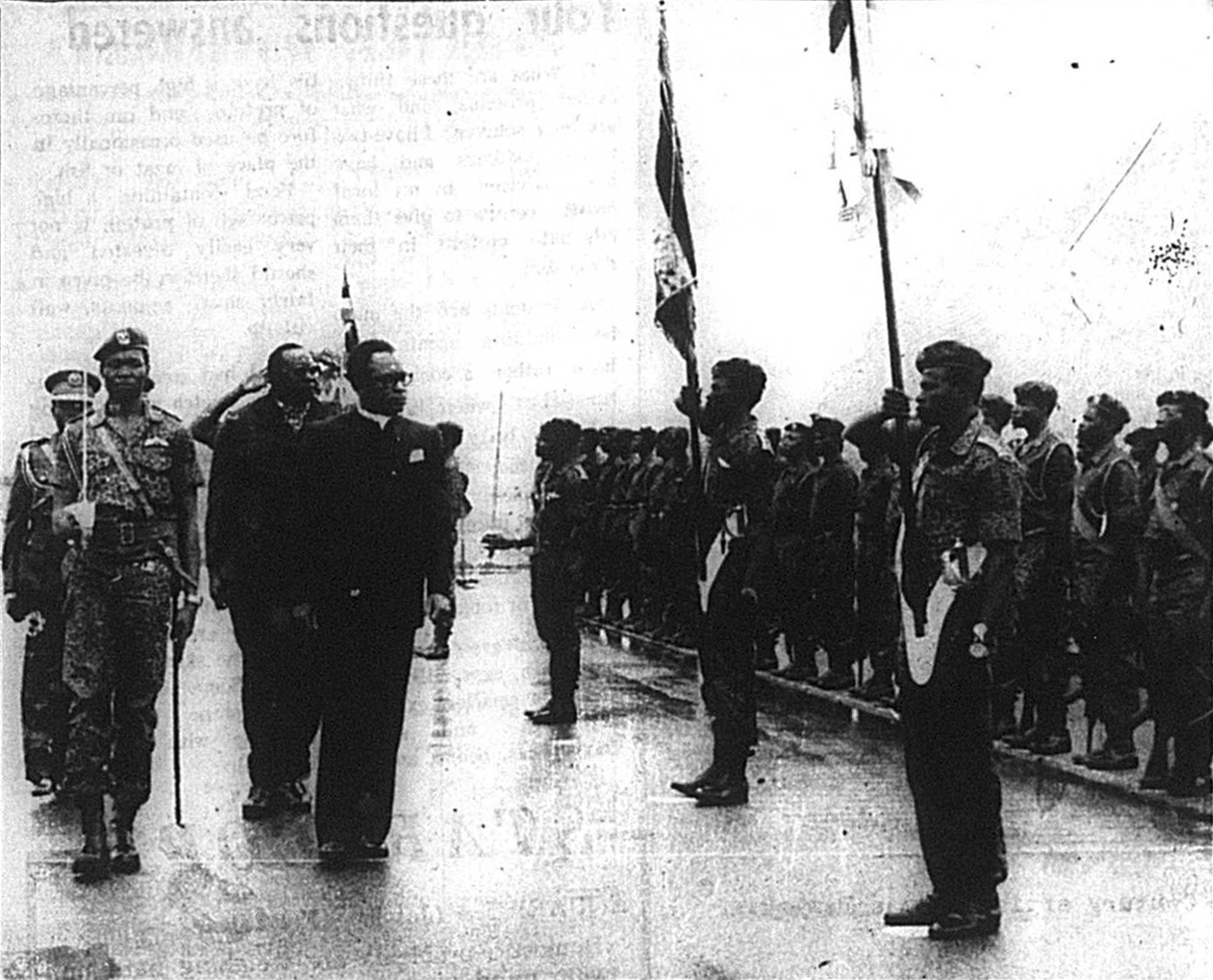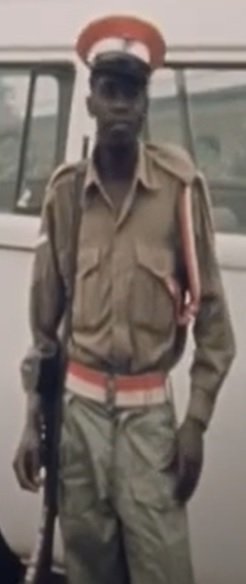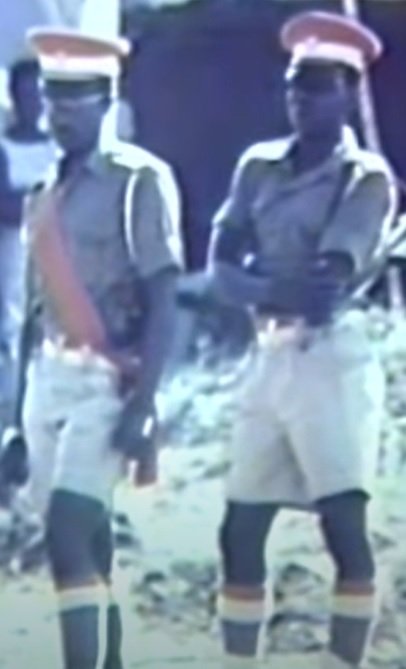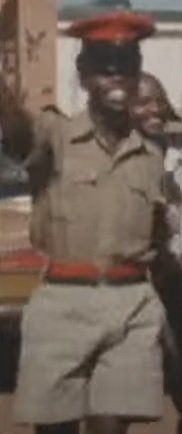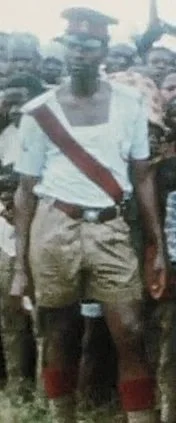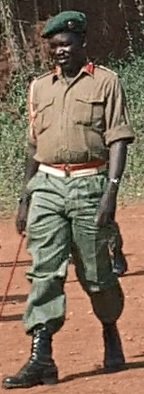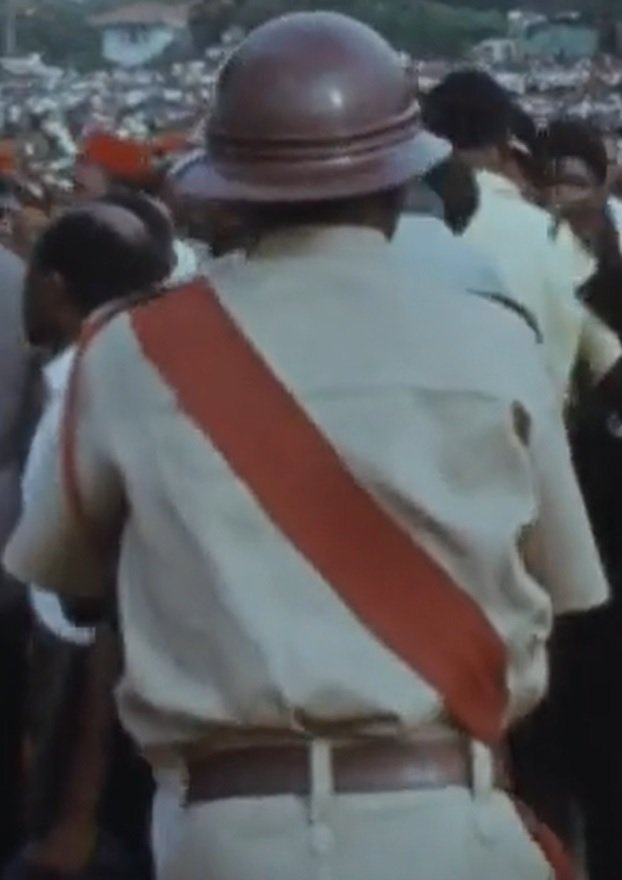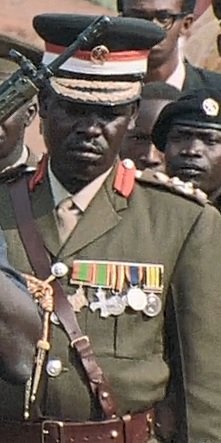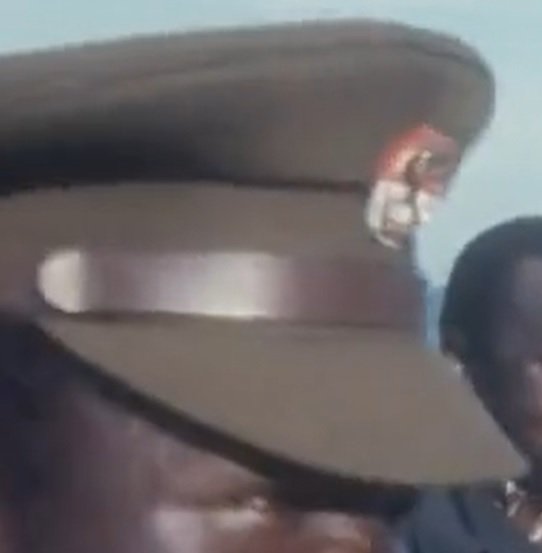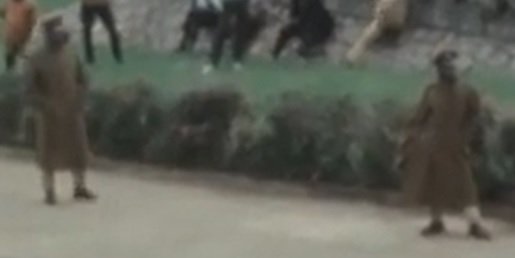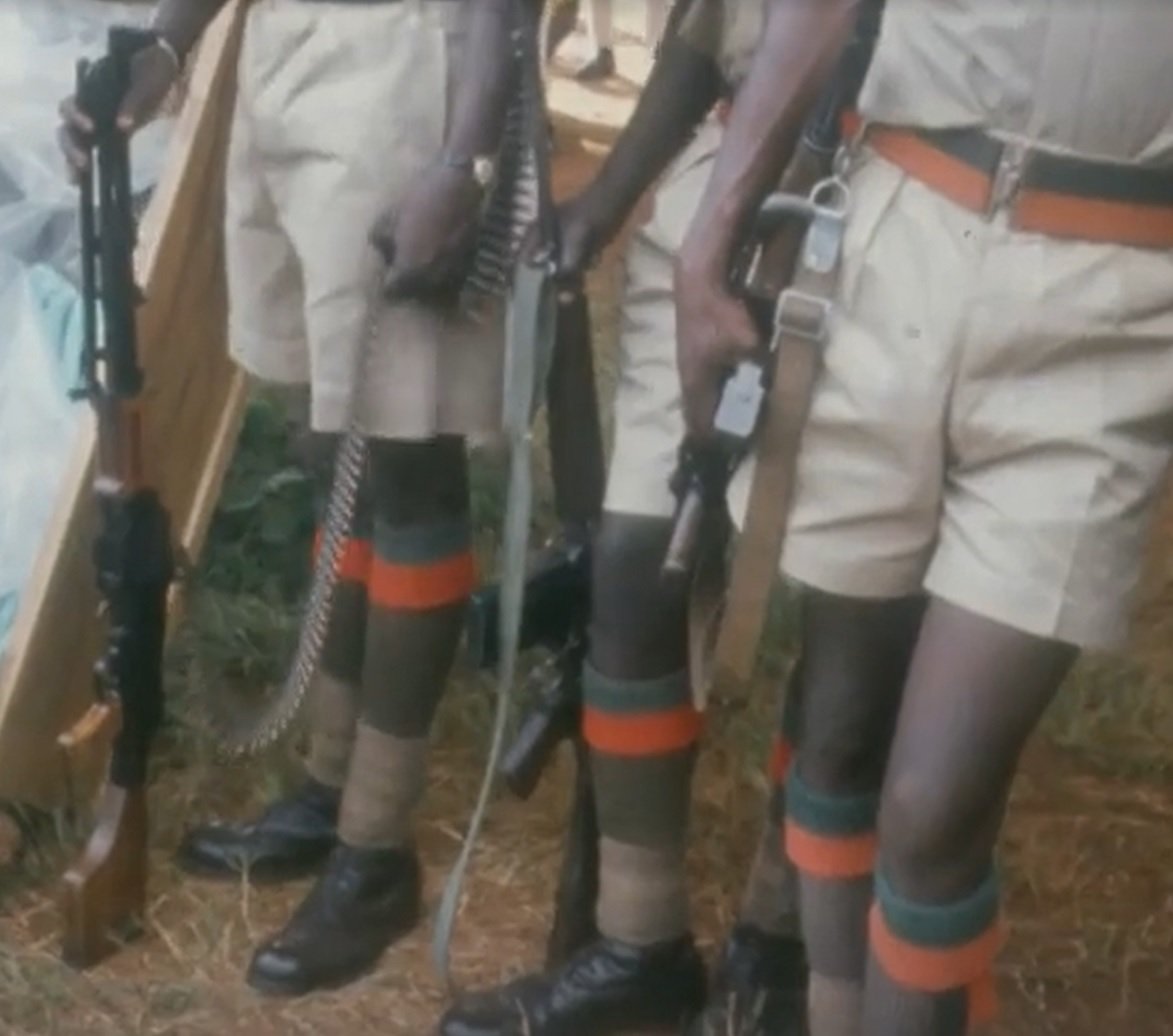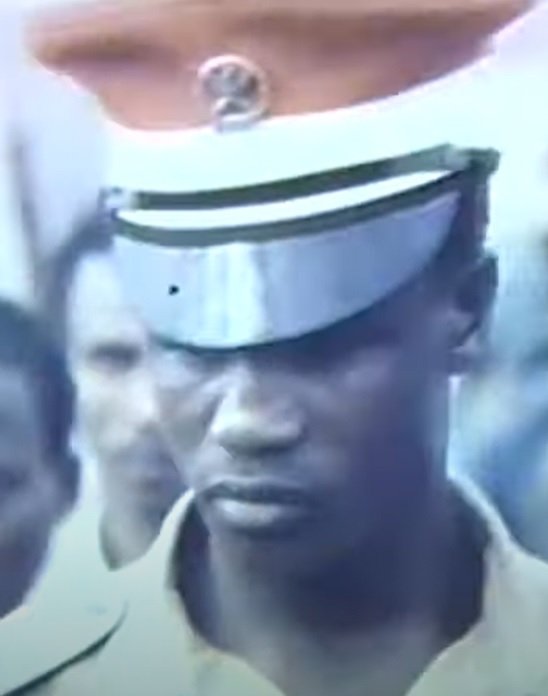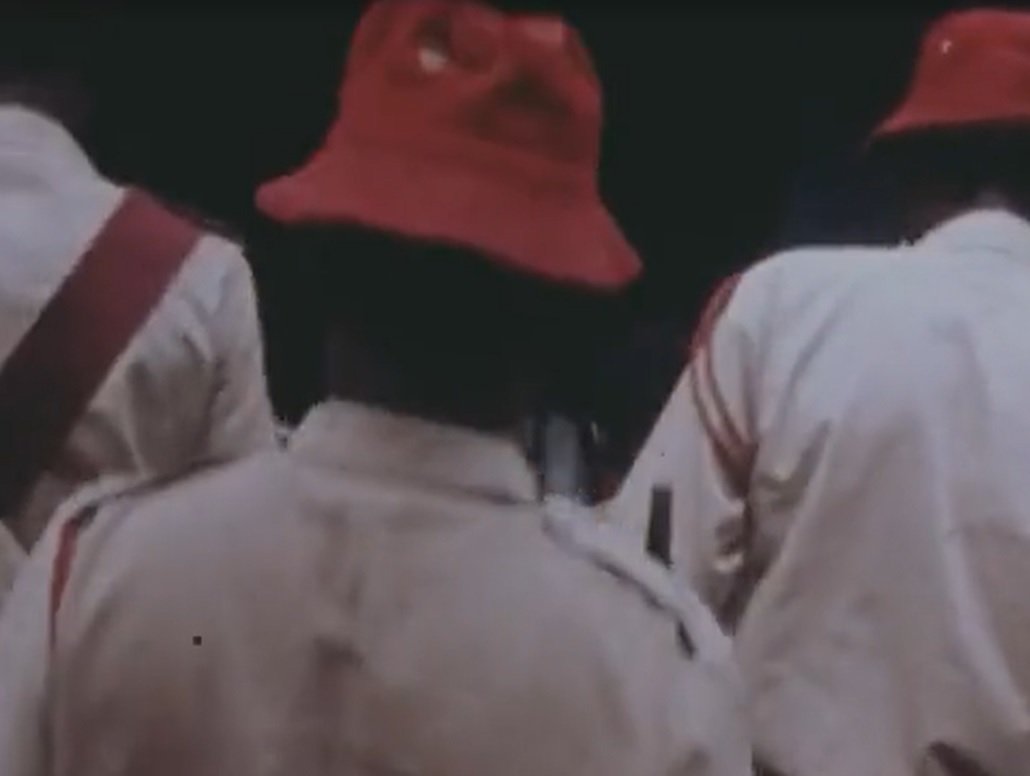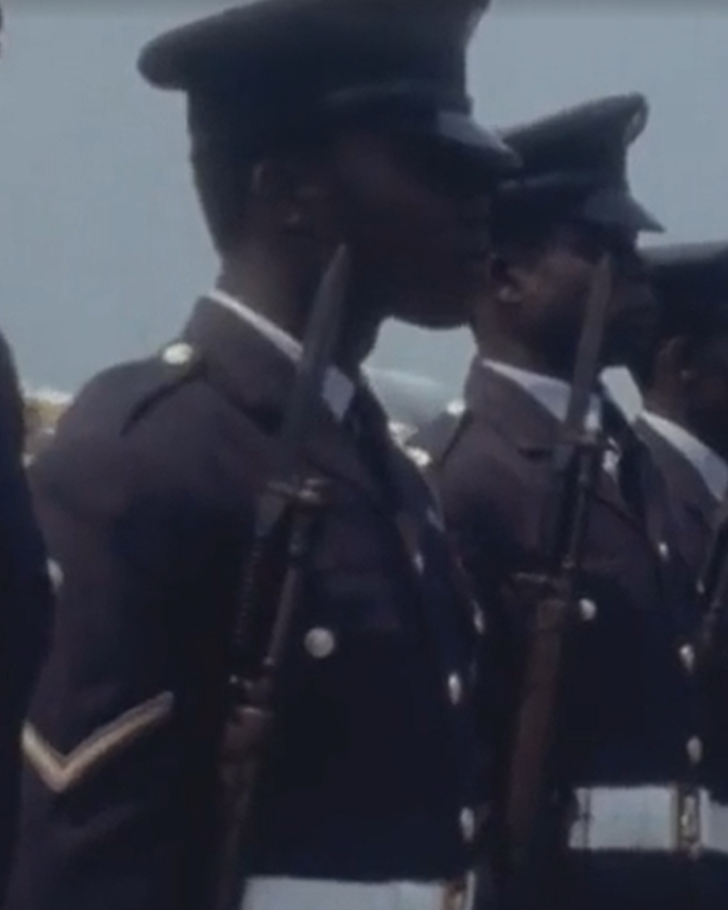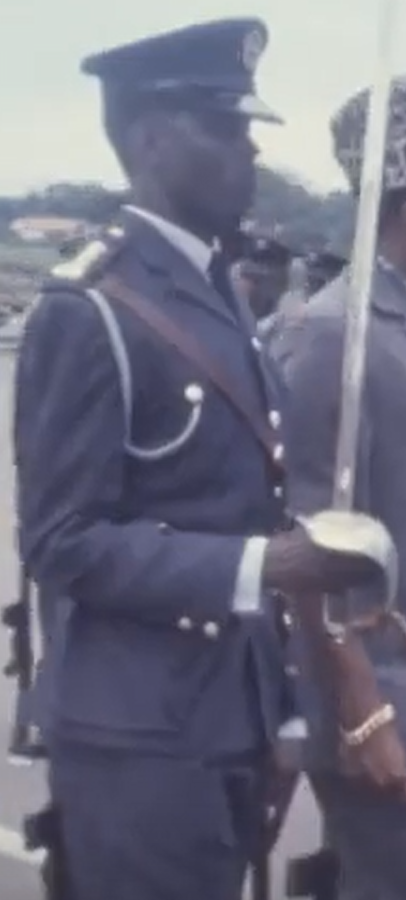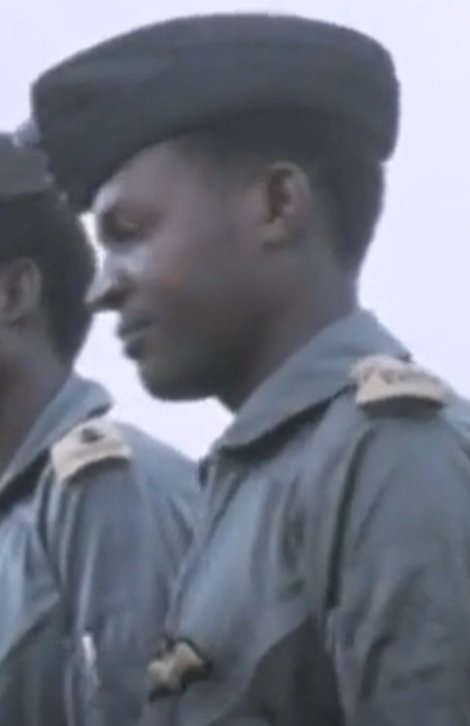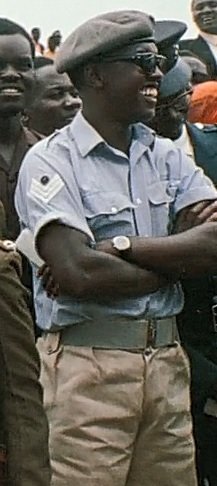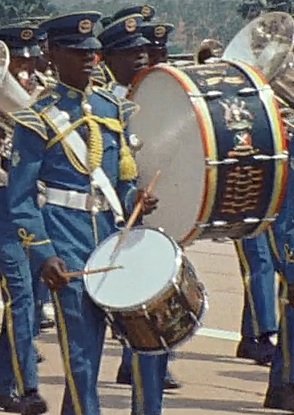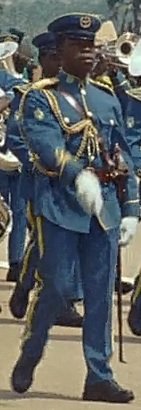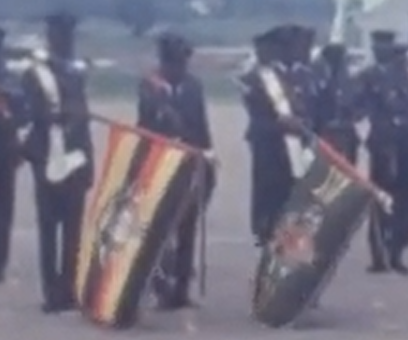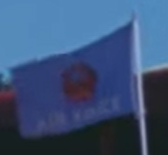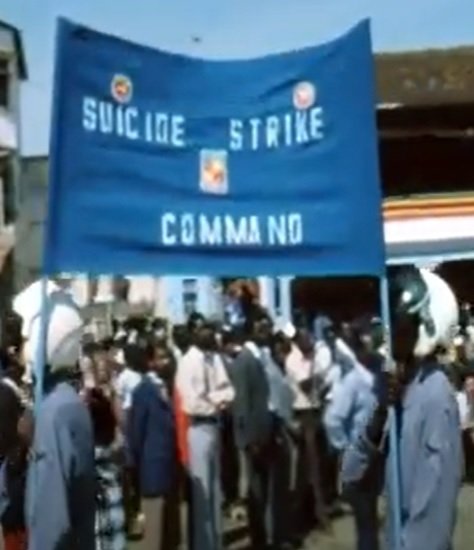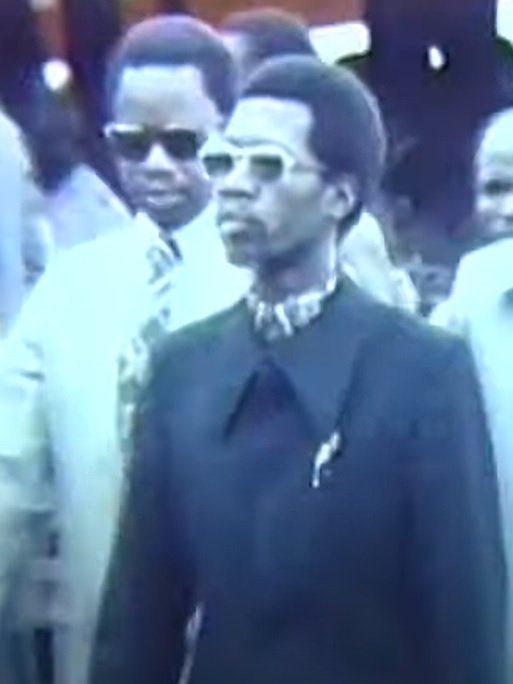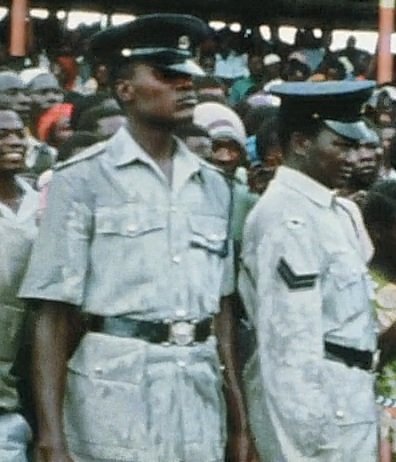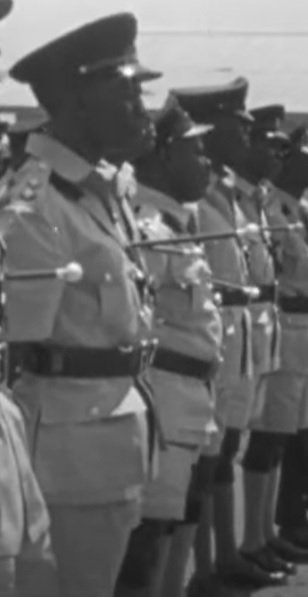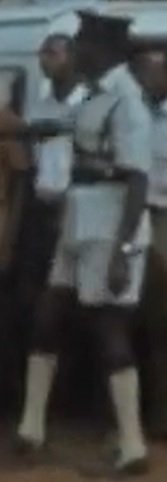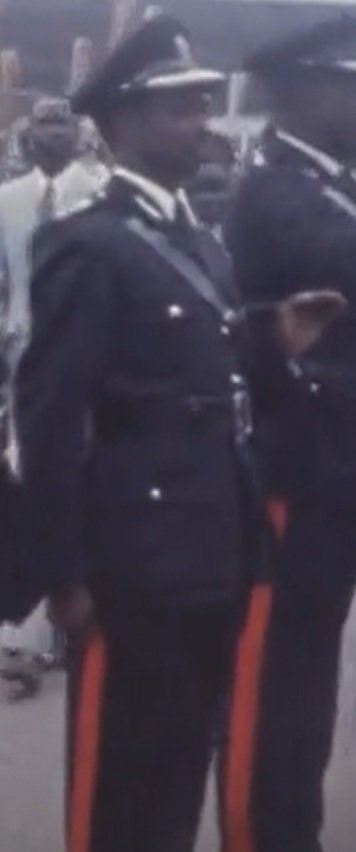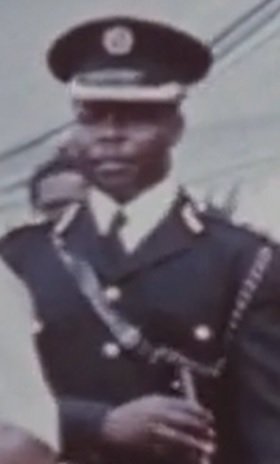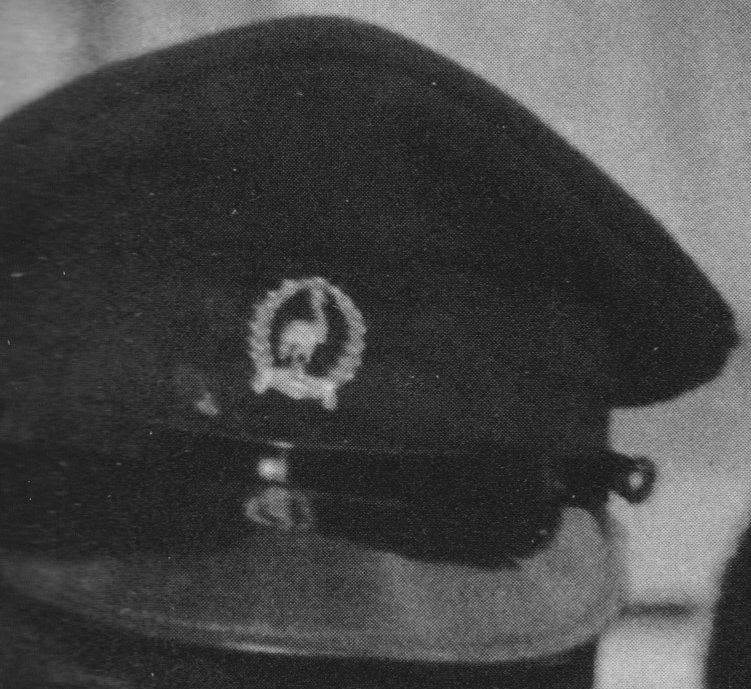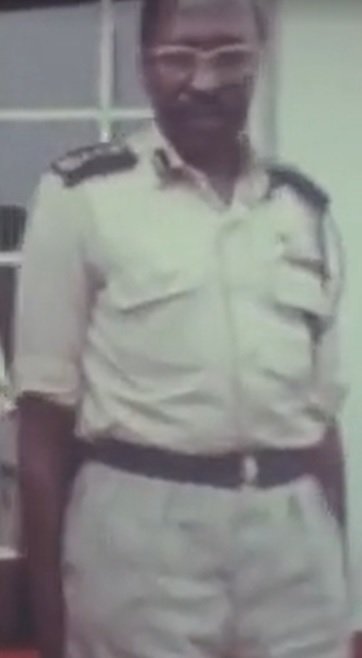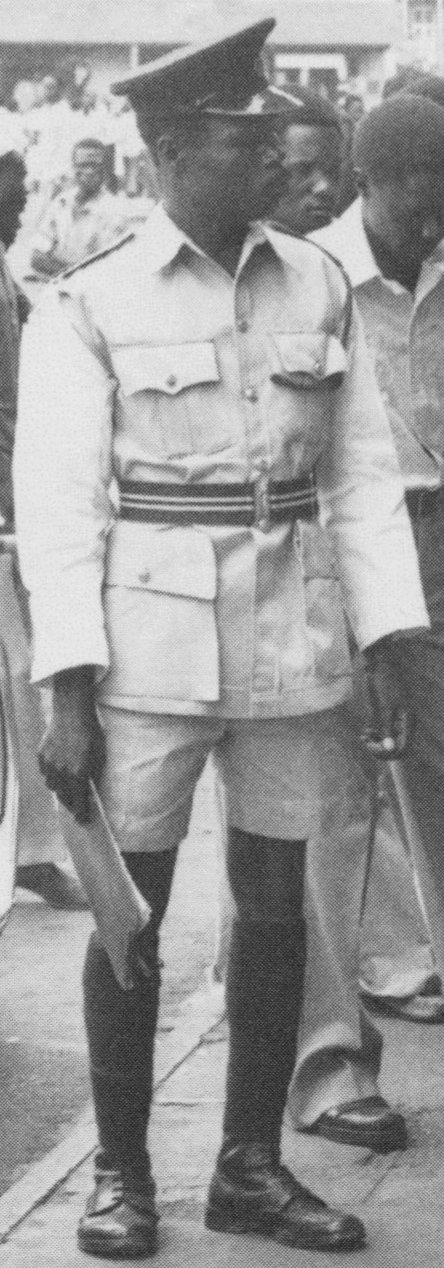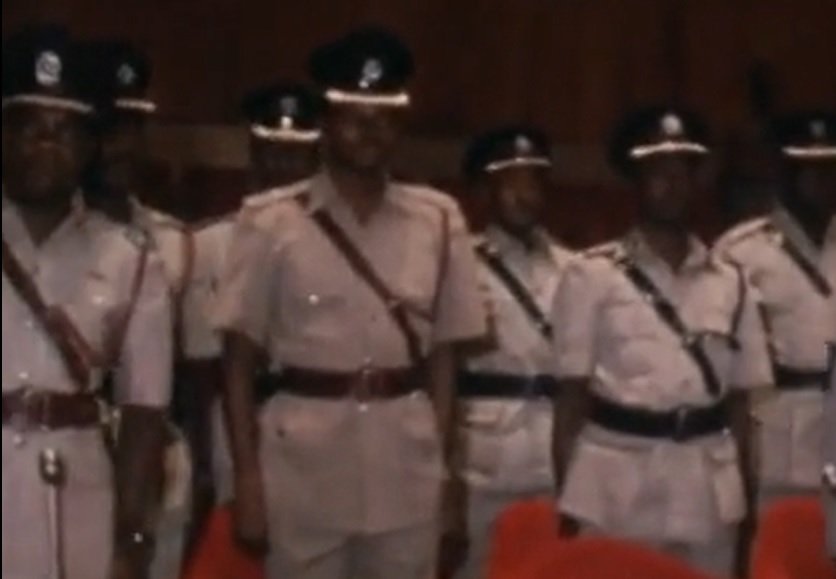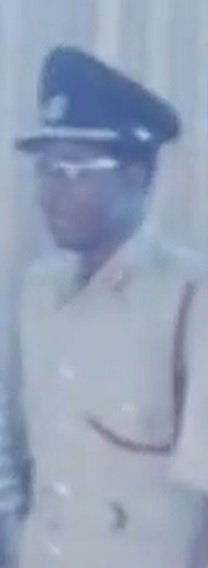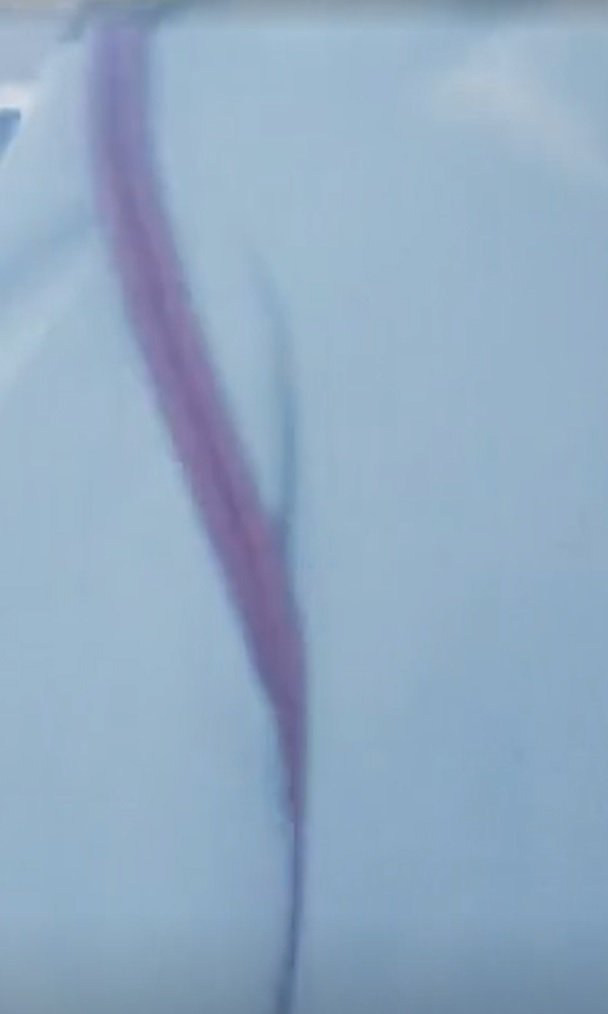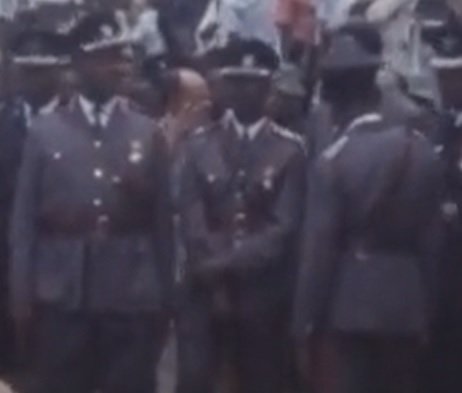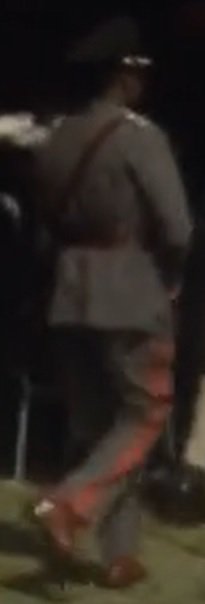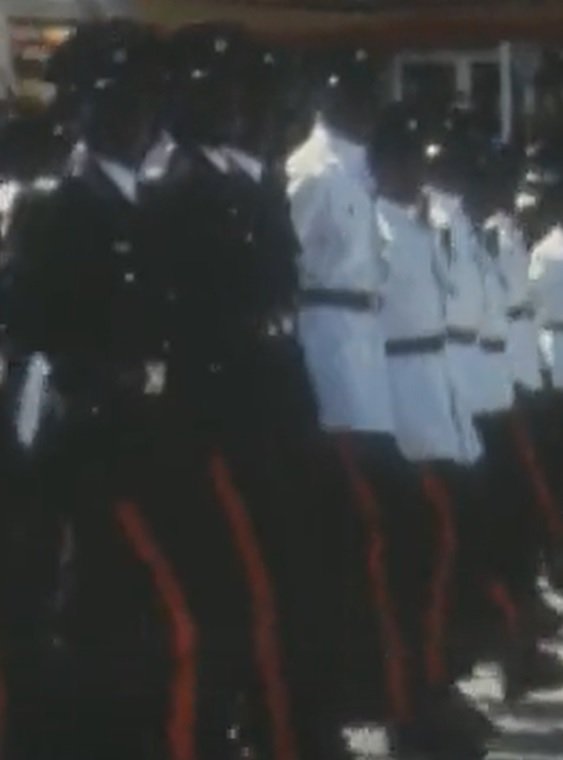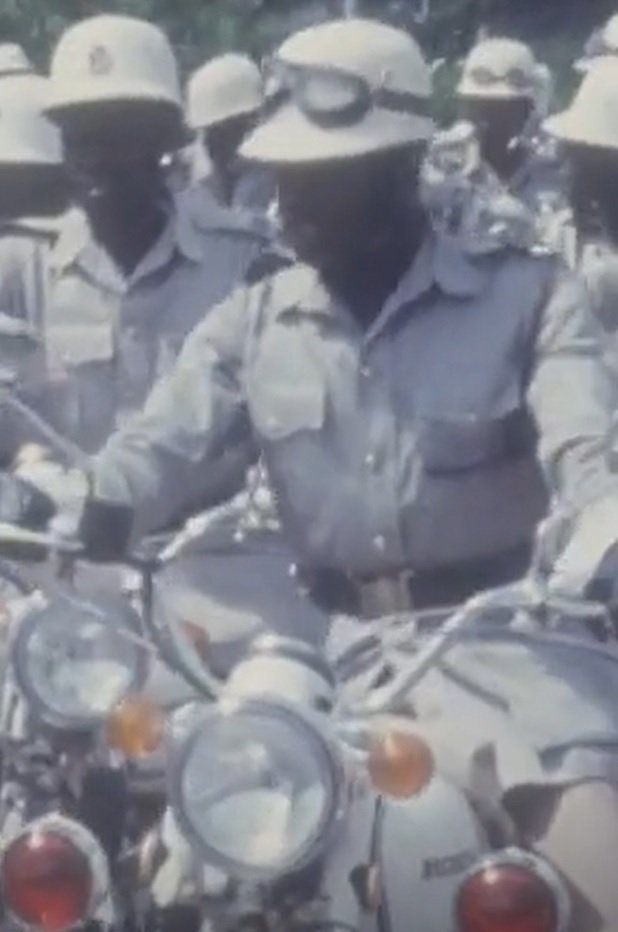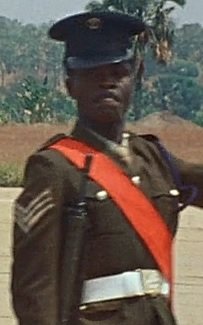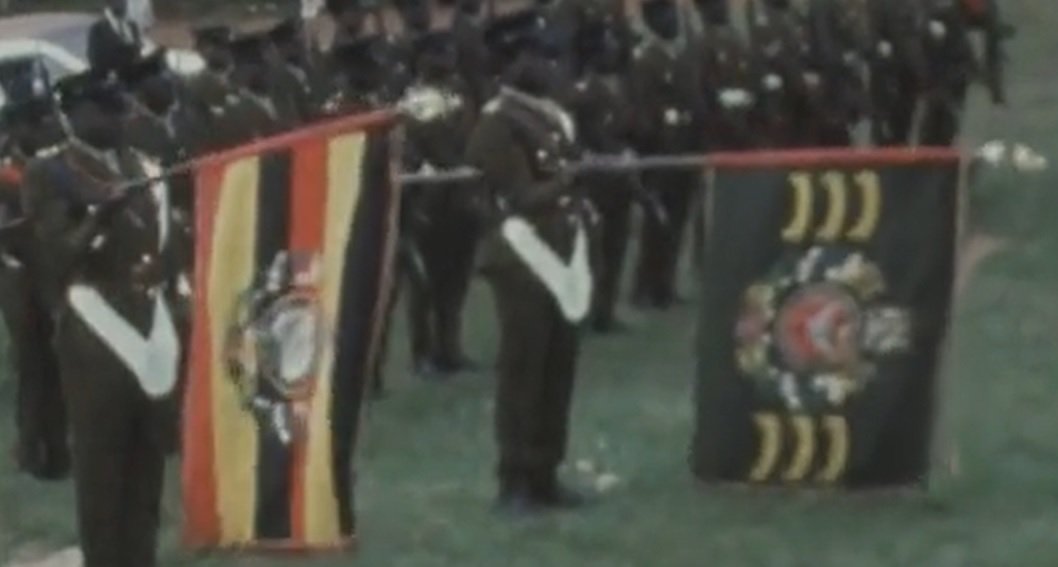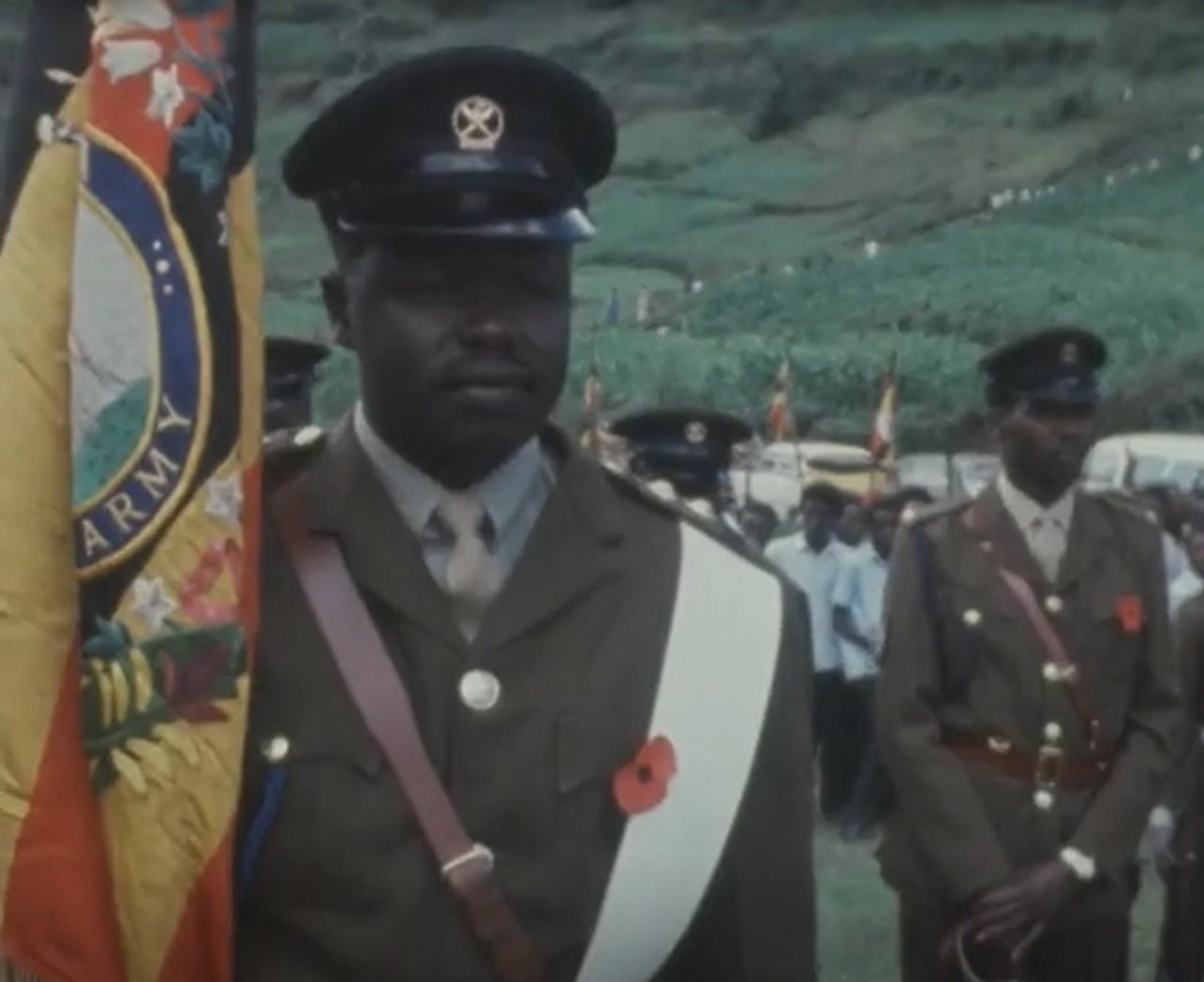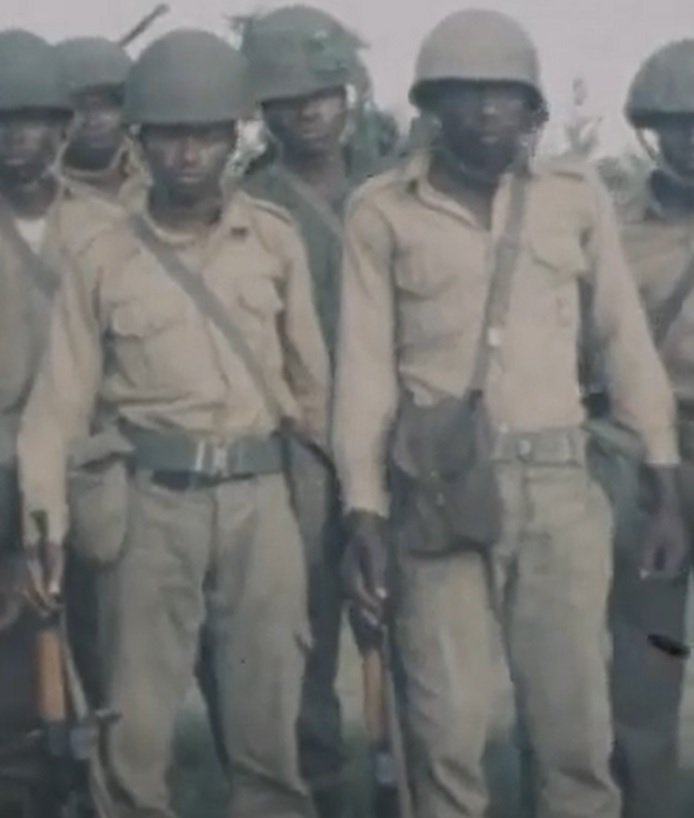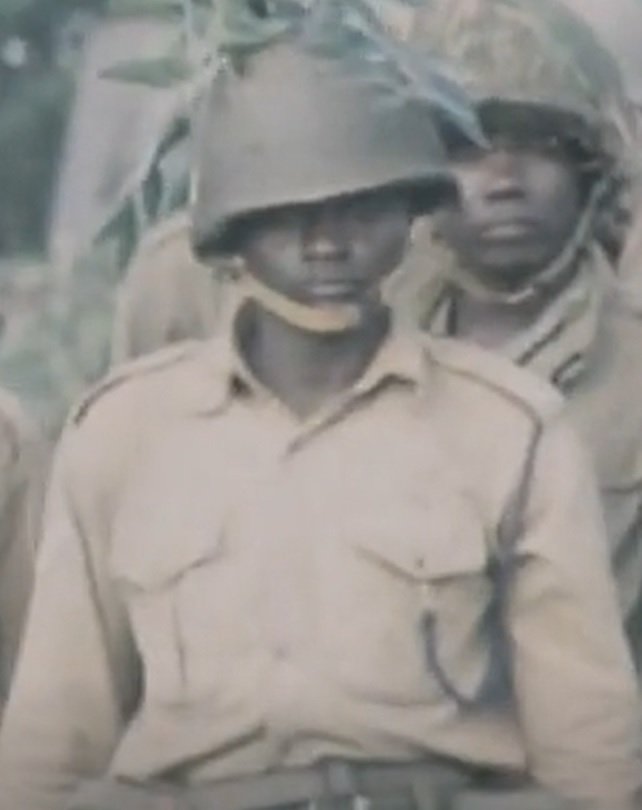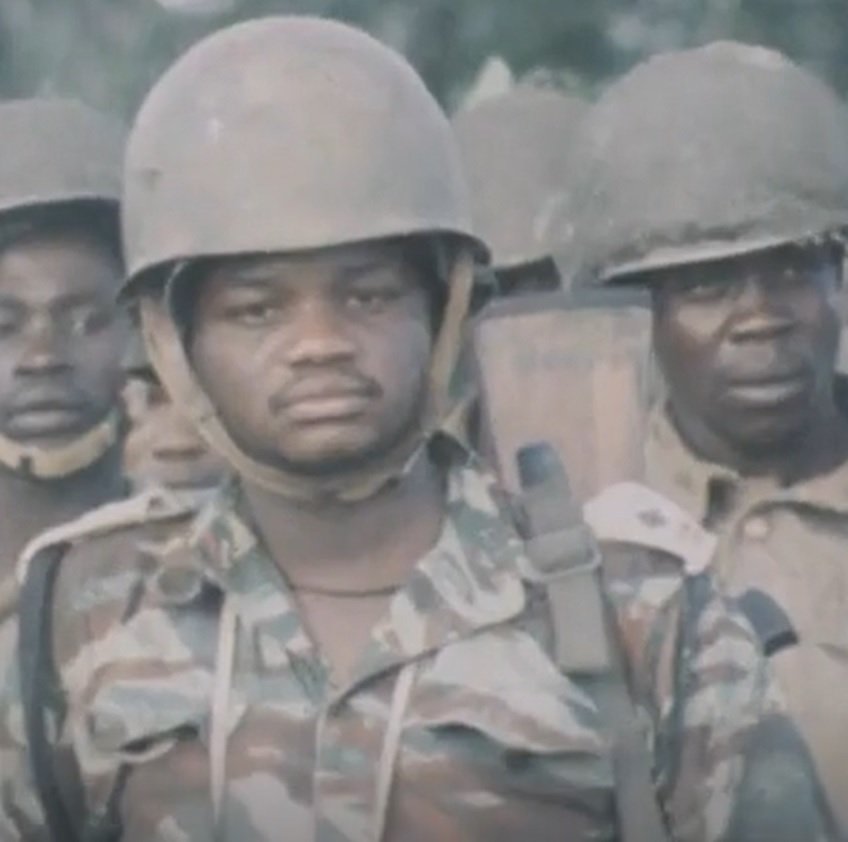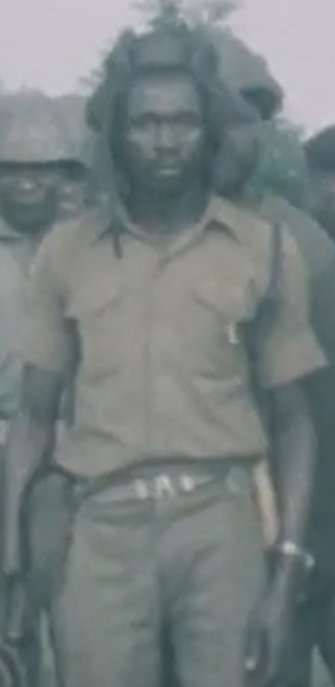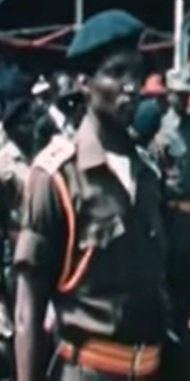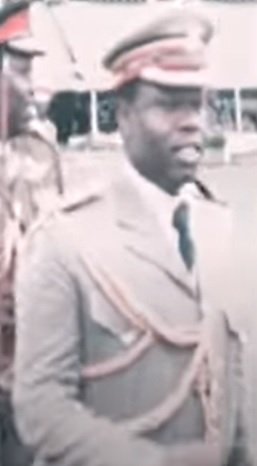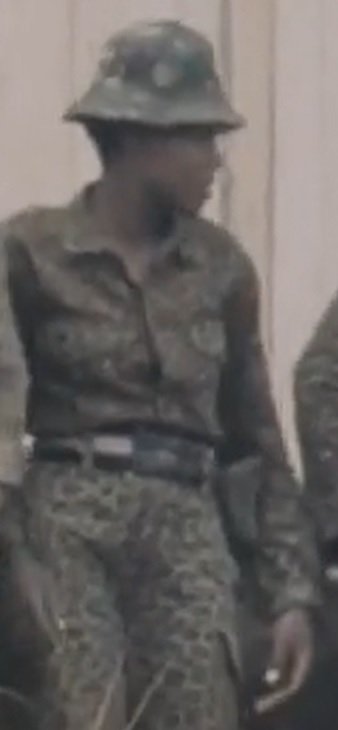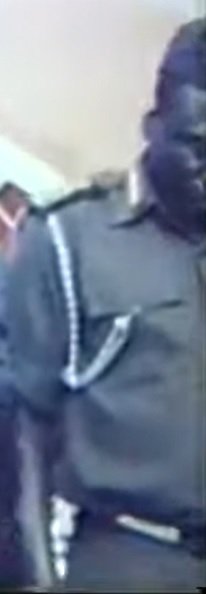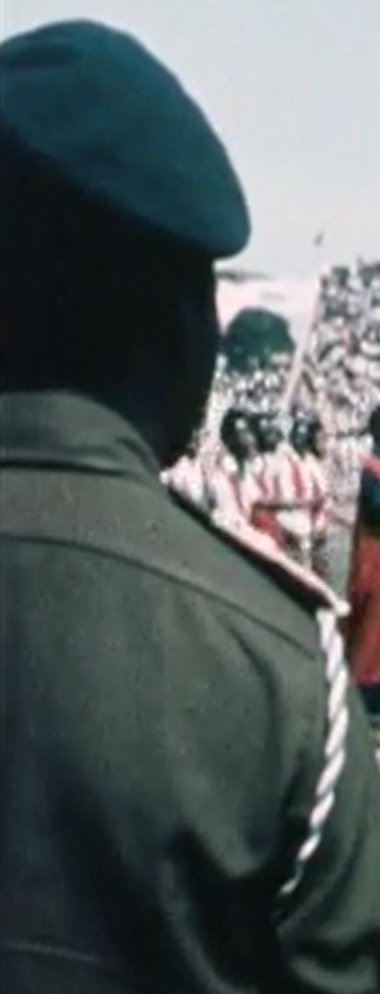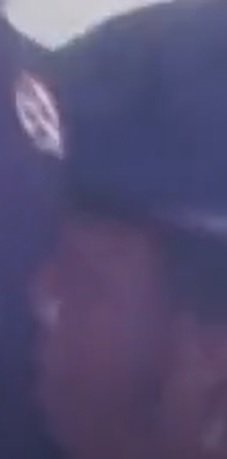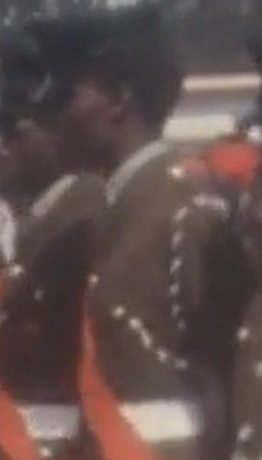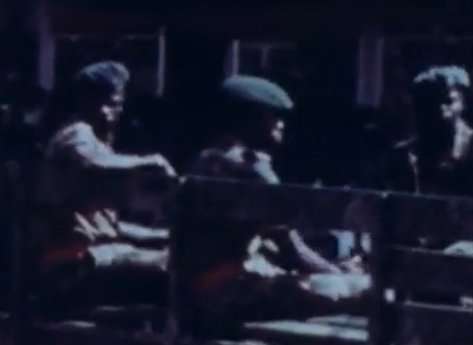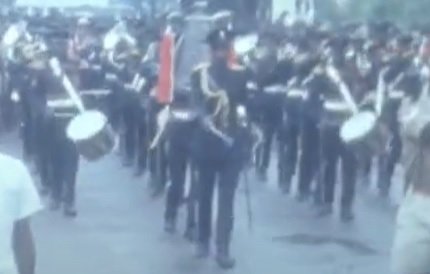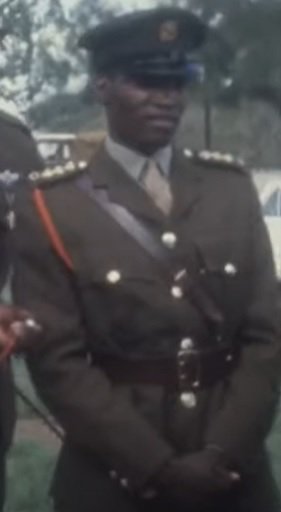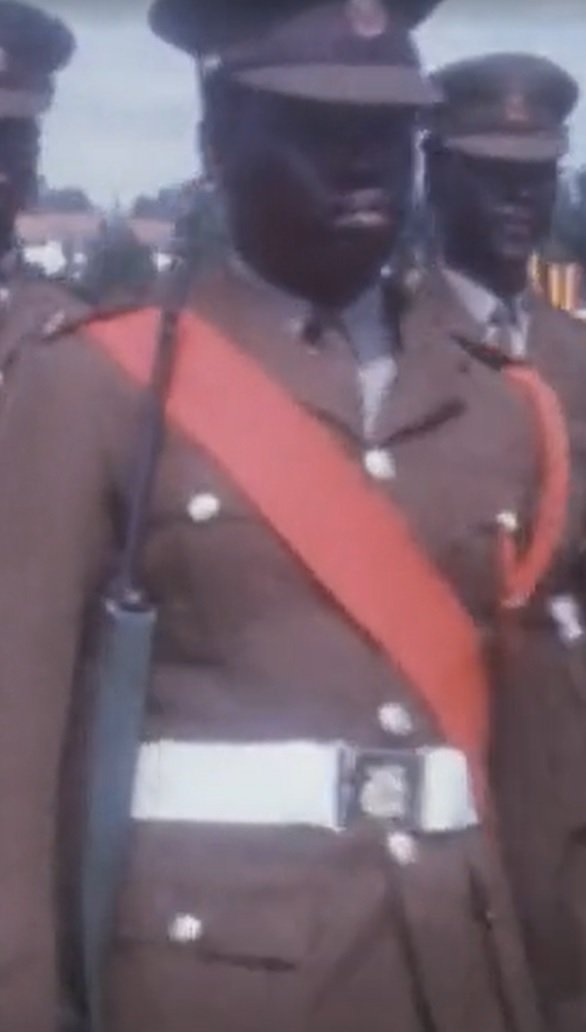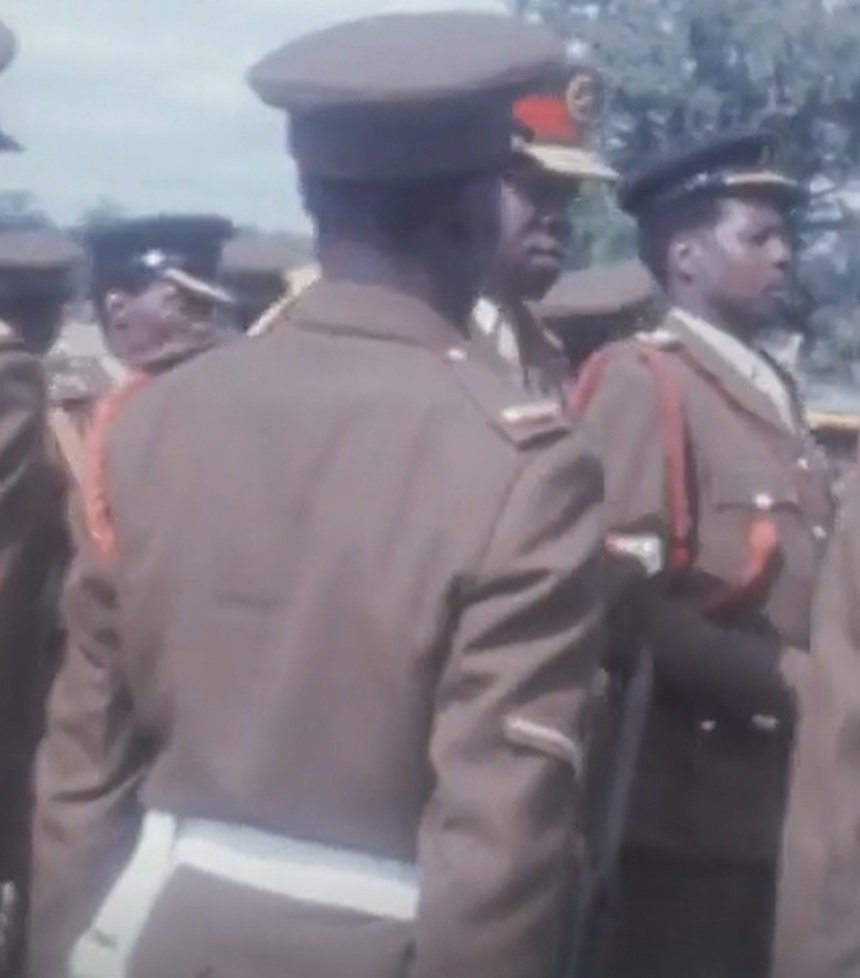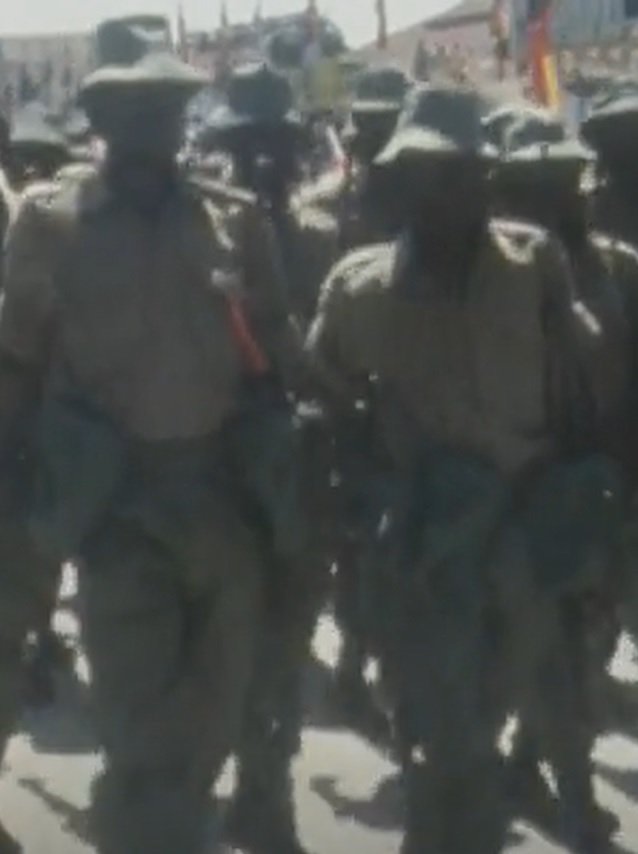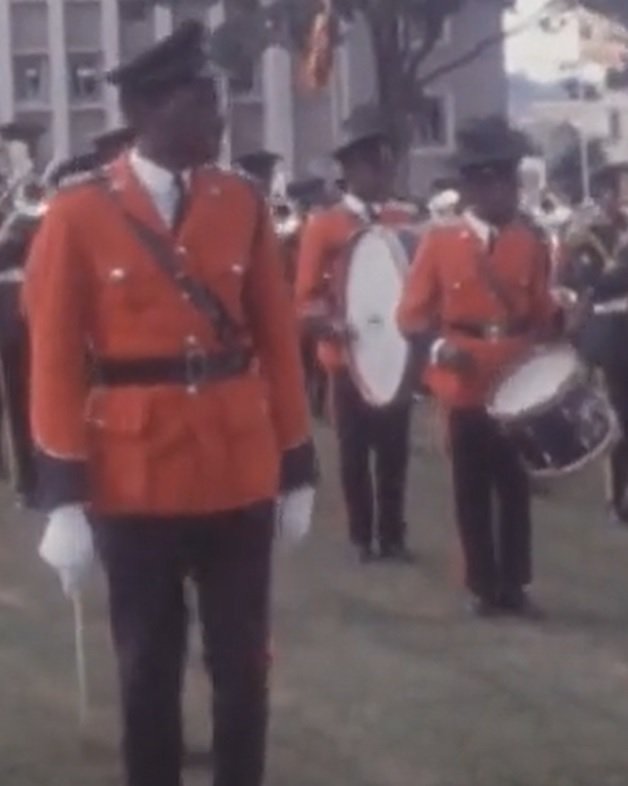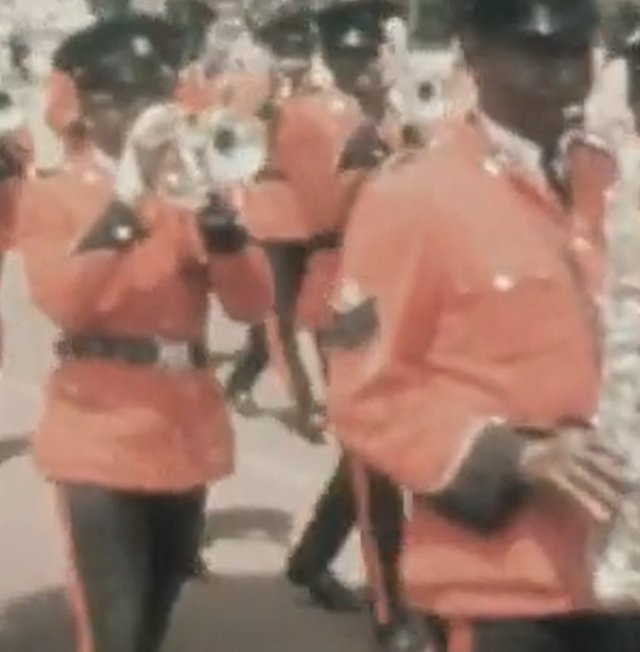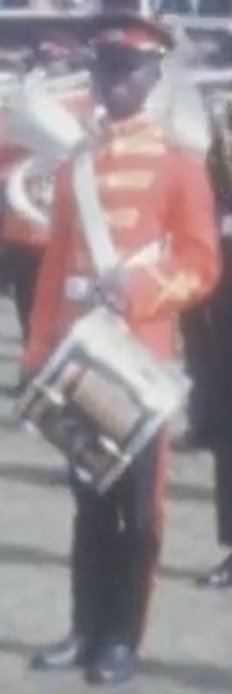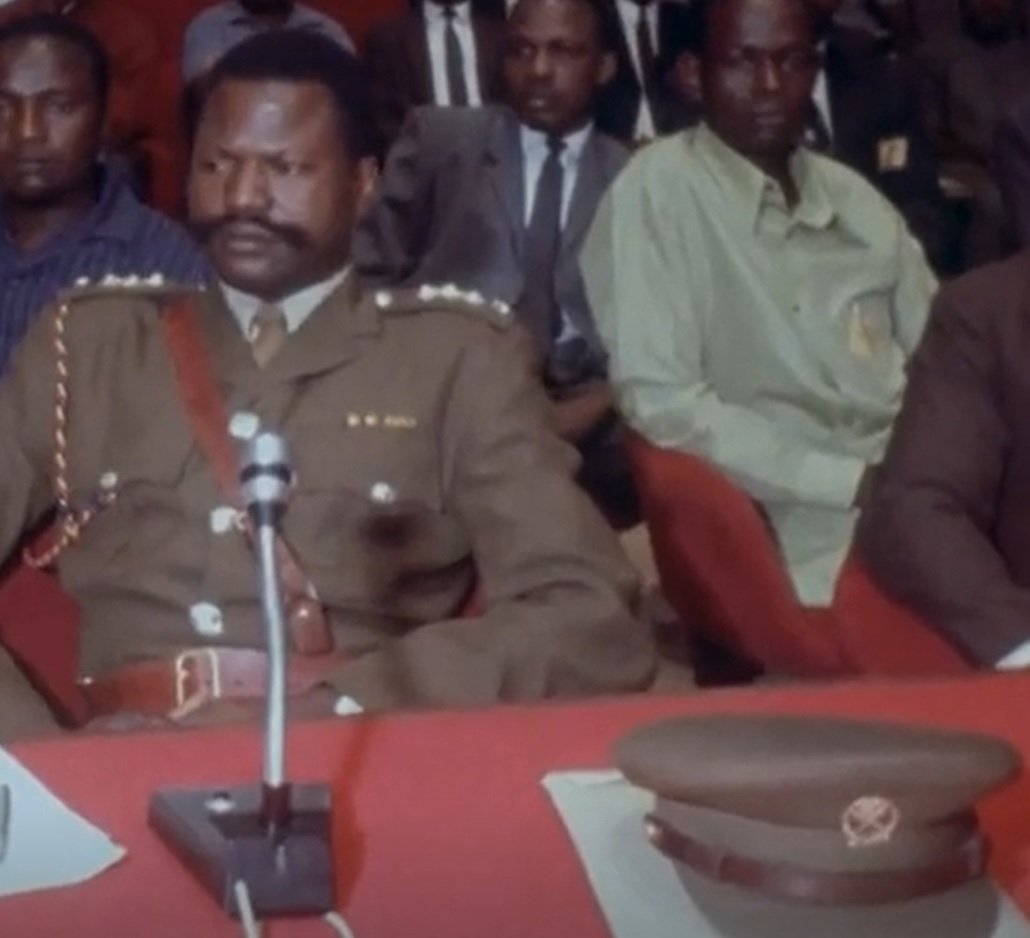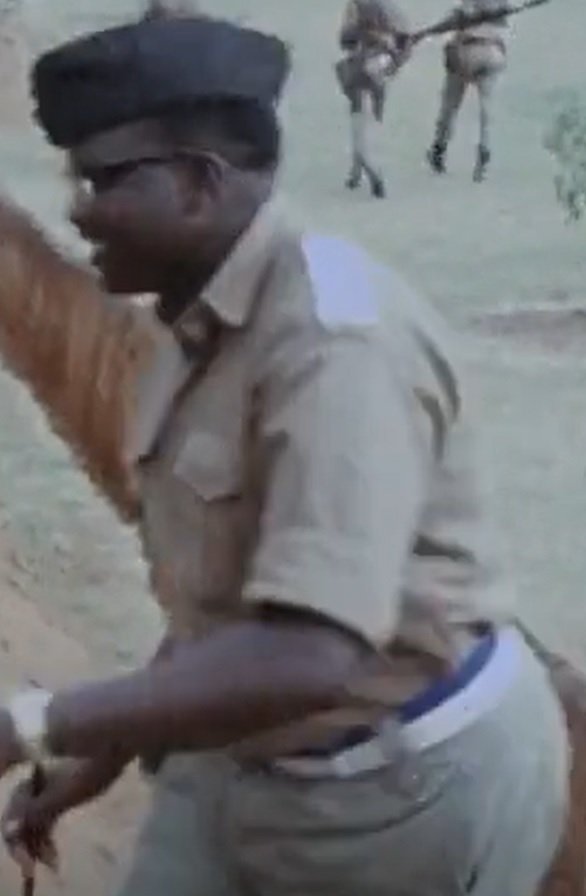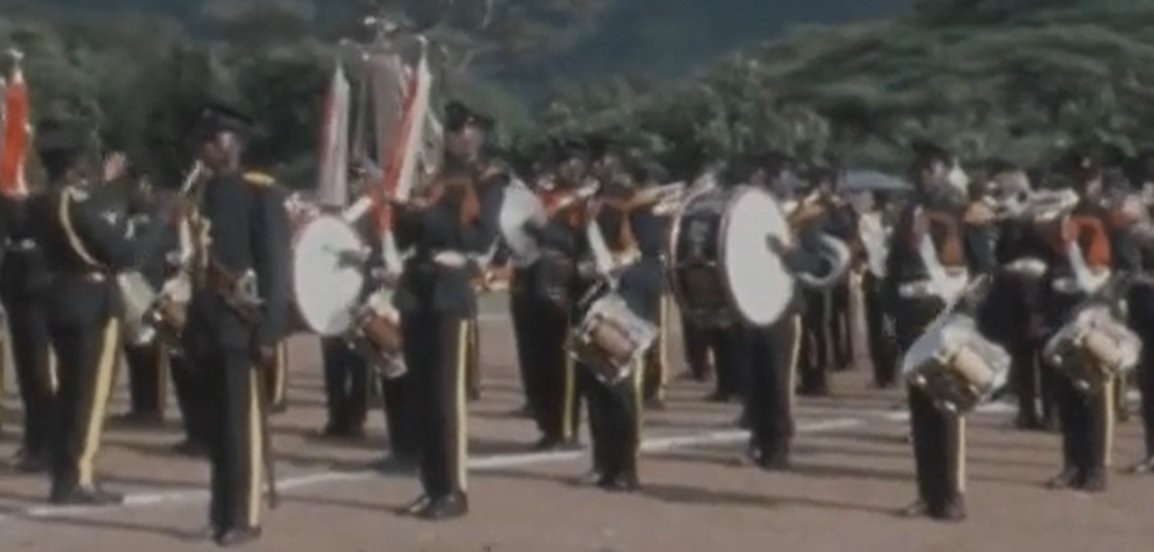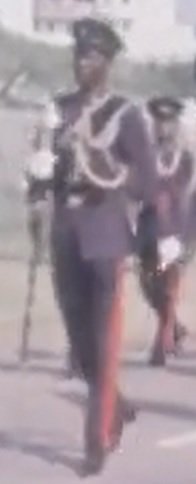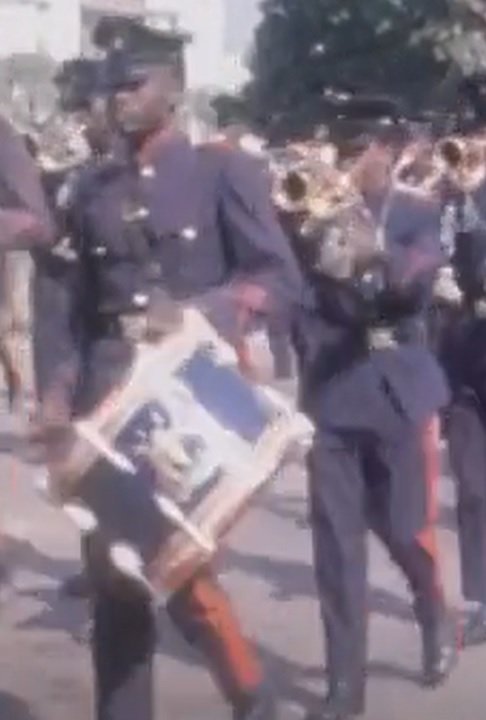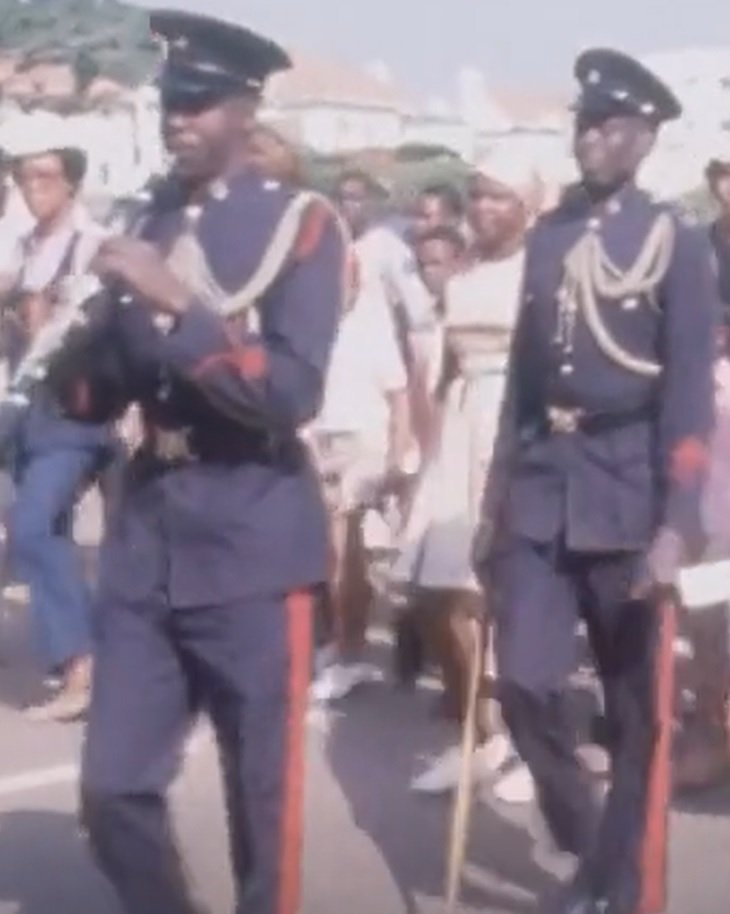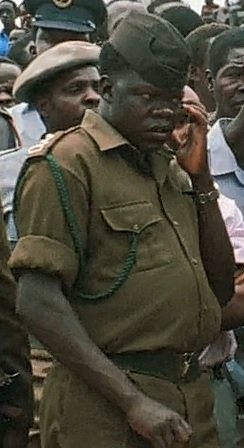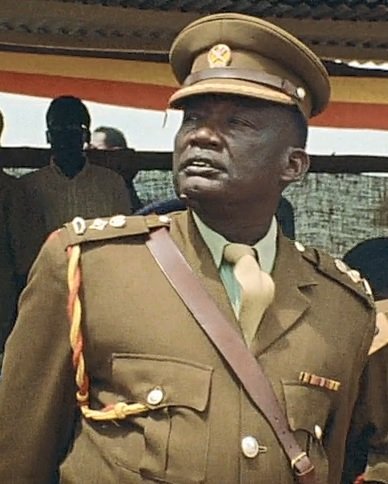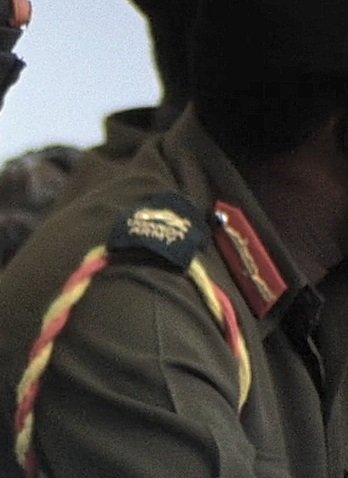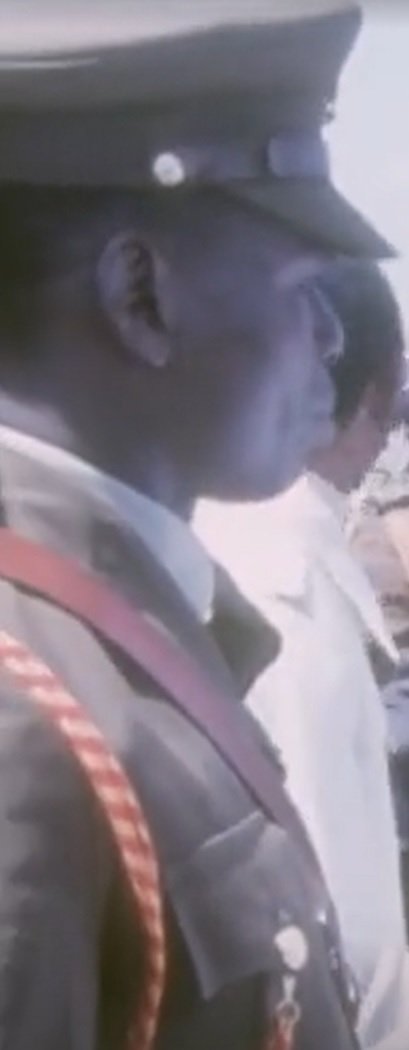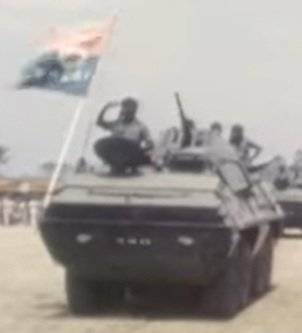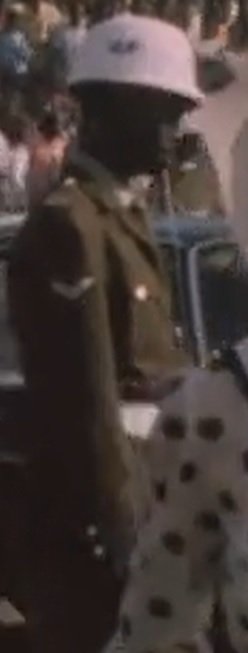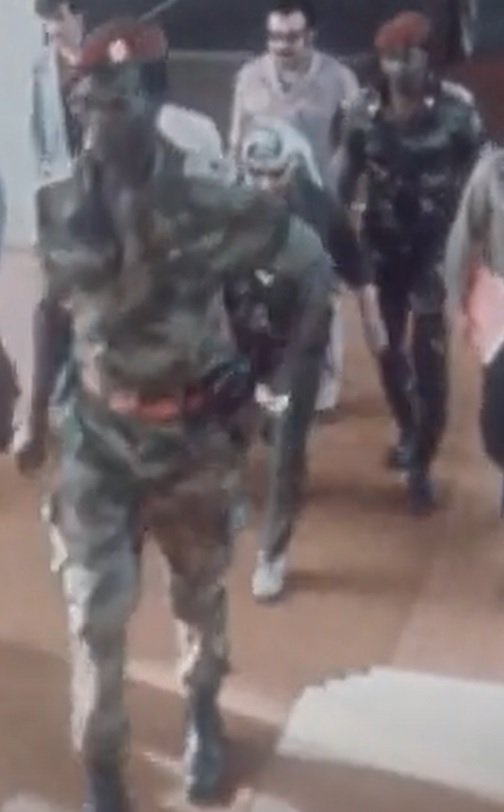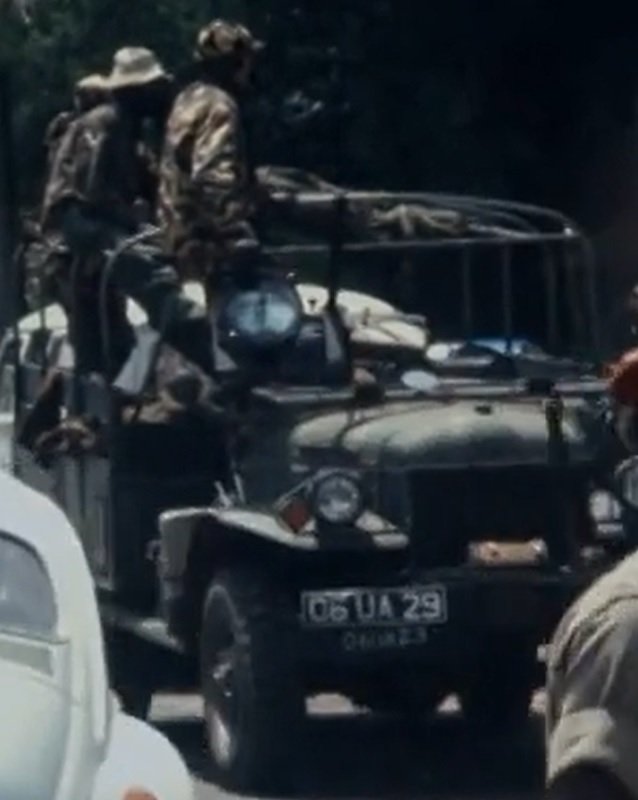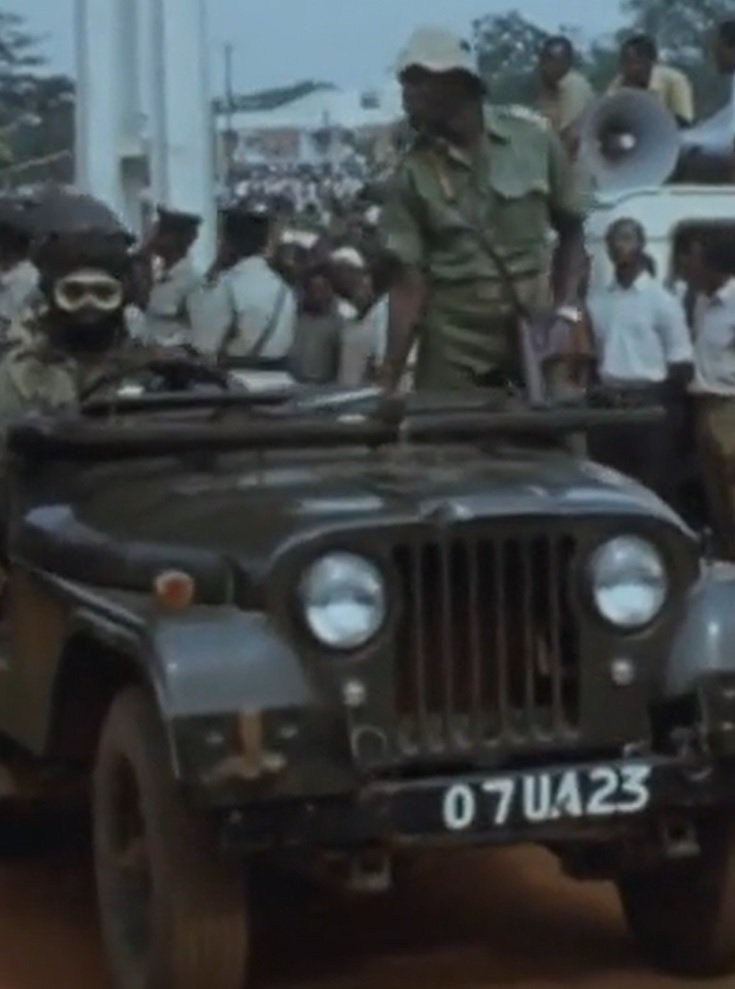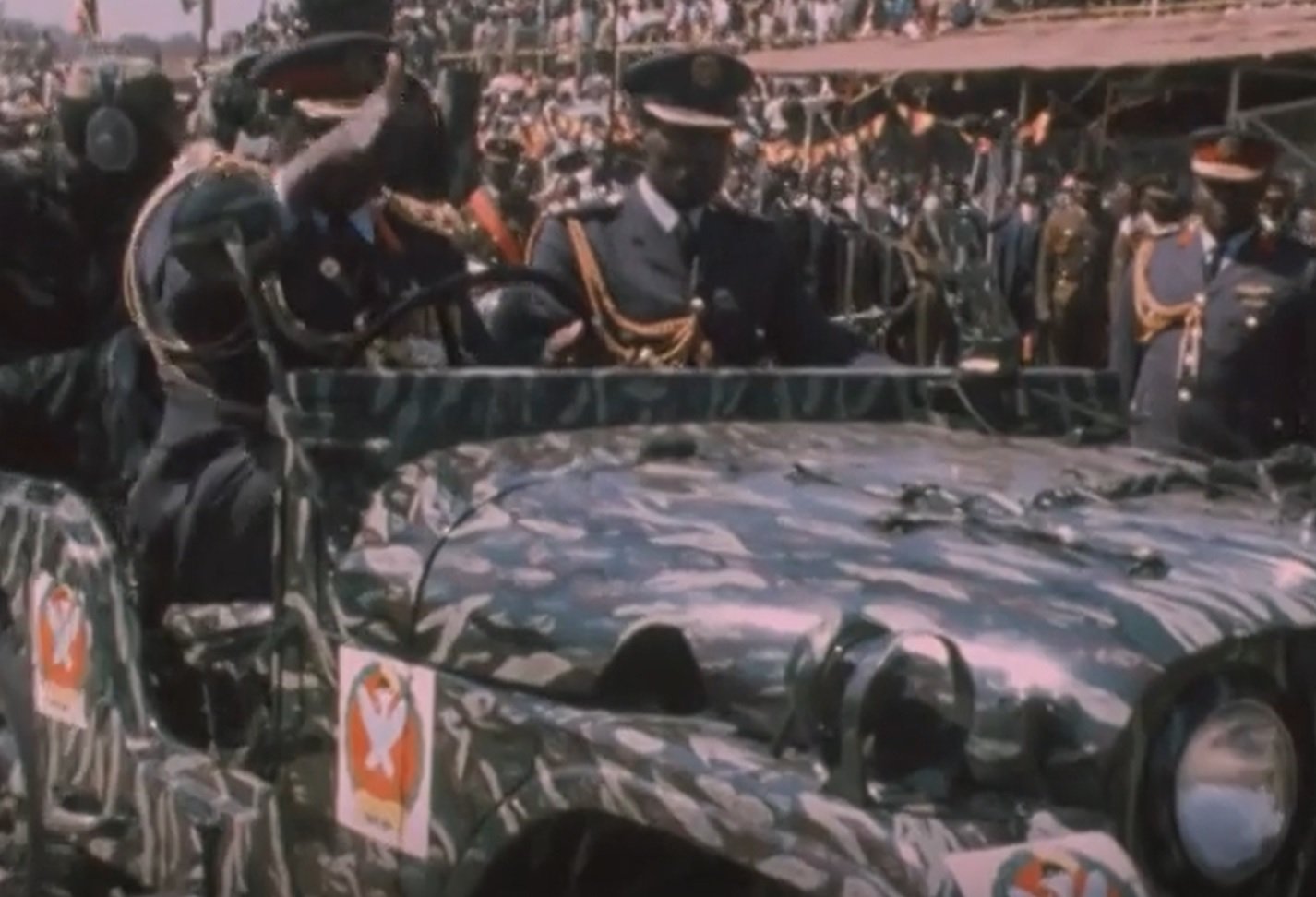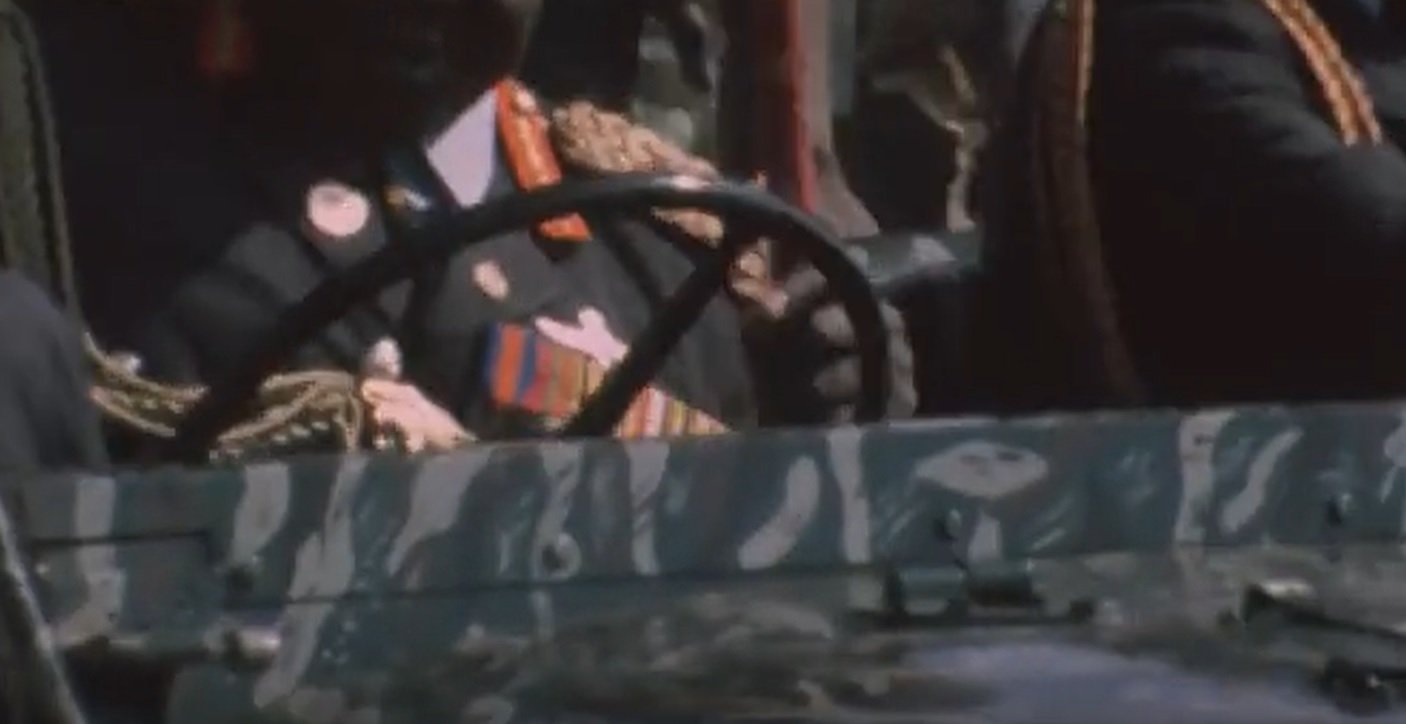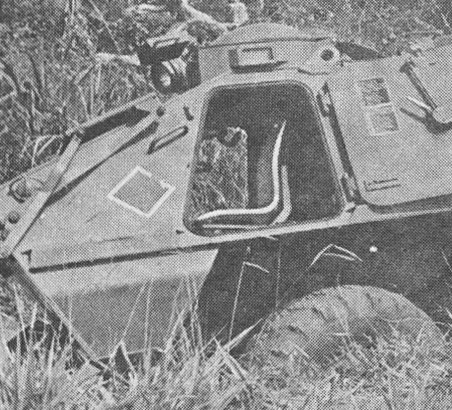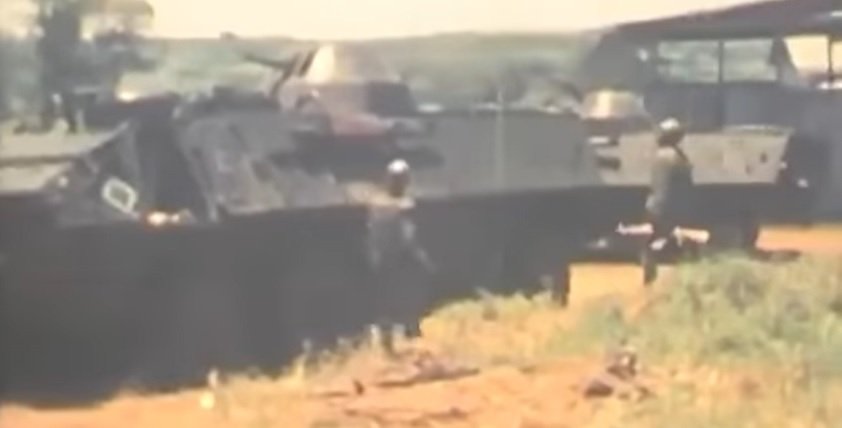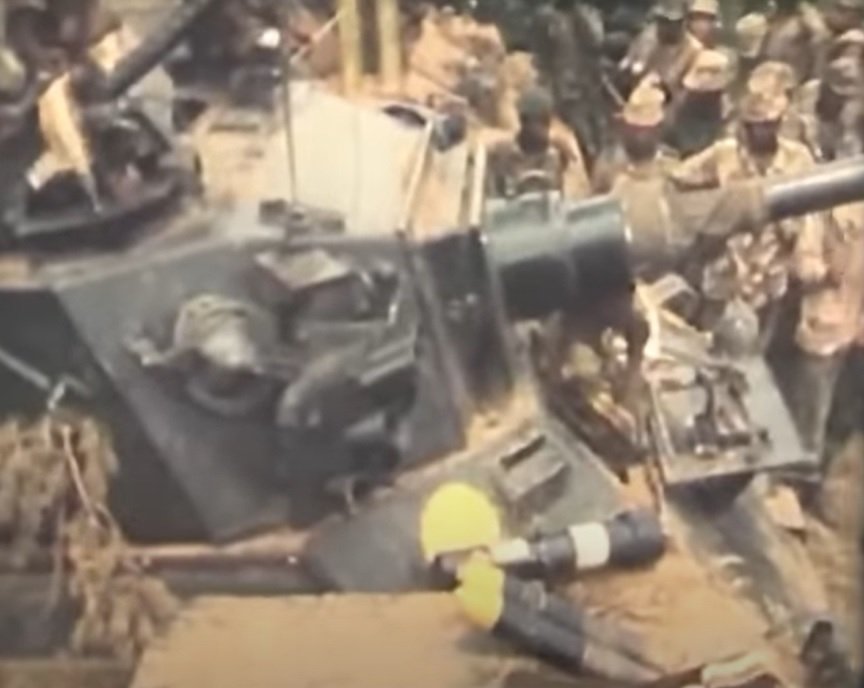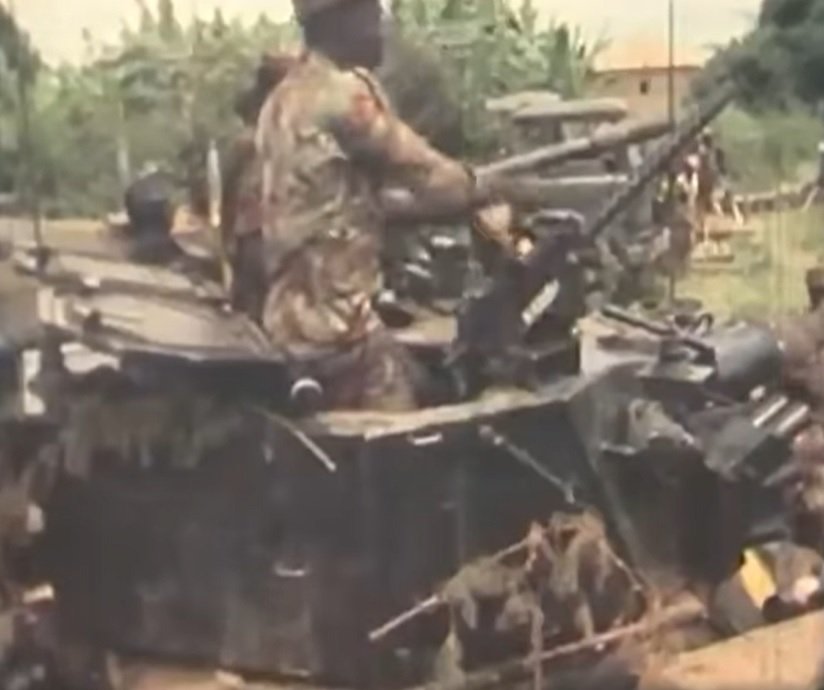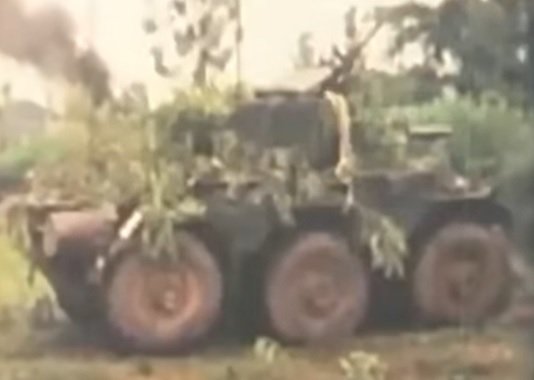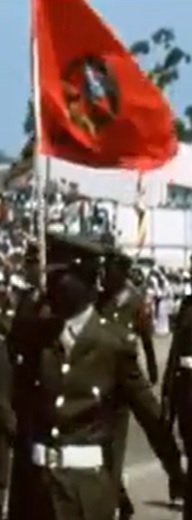Some notes on the uniforms and insignia of the Ugandan army, 1971-1979
Introduction.
On this page I attempt to sketch out a few rough thoughts about the appearance of the Ugandan army under Idi Amin. This topic abounds with uncertainties and confusions, and this page should very much be taken as a rough attempt at untangling a few things, rather than any sort of authoritative or definitive commentary.
This page represents, I cannot over-emphasise, my personal conclusions, and nothing more — every single item here may be wrong in part or in whole, and is entirely at the mercy of corrections and clarifications. I would of course be sincerely grateful for any information any readers are able to offer.
It has, also, by this point, swelled to quite considerable length, much larger than I had initially envisaged. I’ll see what I can do about making it a bit more manageable, eventually.
A note on image sources.
Generally the footage and images I have used are datable. A few screenshots are undated — this is entirely my carelessness in neglecting to note down the dates. But I don’t think anything turns on this.
Anything credited “© Les Films du Losange” is from the classic Général Idi Amin Dada Autoportrait. We learn from Ugandan radio (via the BBC’s Summary of World Broadcasts) that the Malire Regiment’s attack on the “Golan Heights” was filmed on 31 January 1974, and Amin’s visit to the Tiger Regiment at Mubende was on 2 February 1974. The scene with jets and pilots was probably 16 February 1974. The state of my current knowledge doesn’t allow me to date the rest of the footage.
Anything credited “© Mwalimu Nyerere Foundation” is from the Tanzanian documentary film Vita vya Kagera (1980). This contains many rarities, though all the copies available online are unfortunately fairly miserable quality. I can’t speak a word of Swahili, so any additional information that may be contained in the narration is unfortunately lost to me.
General comments about the uniforms.
Colours. I use “khaki” here in the British sense — i.e., a relatively dark shade, and not in the American sense of a light tan. The latter I describe as “tan” etc.
Orders of dress. I use “no. 2 dress” to mean, basically, how that term would be understood in the British context, and “service dress” to refer to fatigue and camouflage uniforms — these were worn as campaign dress, internal service dress, exercise dress (etc.), but often also parade dress. Strictly speaking this is a corrupt use of language as, in the British army, no. 2 dress is a uniform, and not an order of dress — British “service dress” is no. 2 dress. But I trust this won’t cause any confusion.
No. 2 dress. Khaki (often with a notable green tinge) four-pocket tunic with silver buttons. Pointed cuffs with two buttons at each cuff. Tan shirt and necktie, the shades varying enormously. Khaki trousers and black leather shoes. A khaki peaked cap with brown chinstrap and khaki peak, or a rifle-green cap with black peak and chinstrap (see text).
Fatigues. An infinite variety of fatigues, bush hats, etc. Generally the shirts seem to have been more tan, and the trousers and hats more green, but I wouldn’t seek to be too dogmatic about this. M1 helmets and what seem to be Czechoslovak M53s also worn. Black boots worn with or without khaki gaiters.
Berets. Some units wore berets — see their relevant sections. A (green?) beret was possibly also standard headgear for (enclosed?) vehicle crews in units which didn’t wear berets normally — very unclear to me.
Enlisted men’s headgear. Enlisted men (without berets, etc) seem not to have had a “smart” off-duty headgear, so presumably they just wore their bush hats(?)
Officers’ side caps. These seem to have been consistent between branches — a rifle green side cap in British cut, the edges of the top fold seemingly piped black. Black buttons. Gold circular UA badge with pompon or similar behind. This seems to have been red for the army and light blue for the air force.
Officers’ peaked caps. I can find no obvious system in the use of khaki versus rifle-green caps by officers. It may simply have been a matter of personal taste. Majors and lieutenant-colonels had one line of gold foliage, at the edge of the cap peak, colonels and above two rows.
Lanyards. The system here seems to have been that officers wore these on the right shoulder, and men (seemingly just NCOs) on the left shoulder. Unless I note otherwise, this is the system in use in the descriptions below.
Czechoslovak camouflage. The UA seems to have received a shipment of Czechoslovak “mlok” camouflage at some point in the Obote era. I can’t quite get a sense for which units received this — I’ve noted it in the text where I’ve seen this, but I imagine random bits and pieces of it could be found in all units.
Rank insignia. NCO chevrons seem to have only been worn on the right arm. Shoulder rank insignia followed the classic British system – e.g. a brigadier had the insignia of a “senior colonel”. The main difference is the constant presence of “Uganda Army” below the shoulder rank insignia, for officers and NCOs. On rank slides this was literally the words “UGANDA / ARMY” at the bottom of the slide, and on shoulder straps it was a metal device with “UGANDA” in an arc over “ARMY” (I think?) at the base of the shoulder strap. This device was worn below rank insignia for officers, and on its own for NCOs. Rank slides themselves seem to have consistently been light tan, with insignia and text in black or dark green. There might be some eccentricities here and there in the senior ranks’ collar tabs.
Regimental colours.
These were introduced at some point in the Obote era. These seem to have been of identical design for all units except the Marine Regiment (see its section), including the Air Force honour guard. Units seem to have also had camp colours, of varying patterns — I deal with these in their relevant sections. The camp colours perhaps supplanted the regimental colours as the “main” regimental flags as the Amin era went on, but the relative lack of later date footage makes this hard to say much about.
The national colour. The Ugandan flag. Red socket, gold fringe and gold tassels. Gold Ugandan crane finial atop a gold cylinder. Black or dark brown staff. An elaborate central device as seen. A blue disc, edged in gold, reading in gold “THE UGANDA” (top) “ARMY” (bottom), with three dots separating the two sections of text. above the disc, the national coat of arms, in full. Around the disc, a wreath of various foliage, both sides seemingly identical. The pictures above are the best I can do in terms of detail. In the centre of the disc, the Ugandan crane, on a white or very light blue background, standing on a green hill. I lack a clear view of this but this is what the modern Ugandan army employs, and it would fit here.
The regimental colour. As for the national colour, except as noted. A dark green field. In the centre of the disc, the Uganda Army badge (crossed machetes below a Ugandan crane head), on a red background. Six battle honours, in yellow scrolls, on either side. This is somewhat obscure. I can’t find a single straight description of the King’s African Rifles colours anywhere, but the system seems(?) to have been that there were six battle honours for WWI and earlier*, which were common to all battalions, and carried on the regimental colour. Meanwhile WWII battle honours (a total of 26) seem to have been awarded only to the battalions that actually took part in the engagements in question, and were carried on the king’s colour. So my best guess is that the Uganda Army regimental colour carried the WWI and earlier battle honours, and the WWII battle honours, which ought to have been on the national colour after the British system, were left off completely. Which feels a little curious but, nevertheless.
*I think these went left-right, top-bottom. “ASHANTI 1900” / “SOMALILAND 1901-1904” / “KILIMANJARO” / “NARUNGOMBE” / “NYANGAO” / “EAST AFRICA 1914-1918”.
Earlier uniforms, and the transition to the Amin era.
Strictly outside the scope of this review, but I think it might be profitable to set out a couple of notes here.
4th Battalion, King’s African Rifles. The ancestor of the Ugandan army. For such a famous and hard-fighting corps, details of the KAR’s uniforms are strangely elusive, particularly the battalion distinctions. As far as I can discern, then. Enlisted men: a long shirt-tunic, tan, black buttons. Tan shorts. Red fez, green sash and lanyard. Blue puttees worn over socks of an unclear dark colour. On the upper sleeve a red circle with crossed swords. Officers: a four-pocket open-necked tan tunic, etc. Black buttons. Tan slouch hat.
The Ugandan army under Milton Obote. The 4th Battalion KAR became the 1st (and only) Battalion, Uganda Rifles, at some point in the immediate runup to Ugandan independence in 1962. At independence, or thereabouts, it was renamed the 1st Battalion, Uganda Army. The 2nd Battalion was raised in 1963, subsequent ones in due course.
In this period, army uniforms continued along KAR lines, with tan uniforms and “rifles” style distinctions (i.e., black buttons and dark NCO chevrons, use (by some units) of dark caps, socks, etc.). For parade (etc.) dress, enlisted men received a four-pocket closed-collar tunic, while officers continued with their open-collar tunic. Branch distinctions (differences in headgear, etc) seem to have sprung up rapidly — I don’t propose to go into detail about these. A fairly consistent feature of the uniforms seems to have been a patch, worn on the upper left sleeve of the tunic, or both sleeves: a green square, on which the Ugandan cockerel emblem on a white circle edged yellow. Presumably, this was intended to be a replacement for the red KAR patch described above. Fatigue uniforms were as they would continue to be. This is a whole separate topic and I’m barely scratching the surface of it here, no doubt.
This was the uniform in use at the time of Amin’s coup, and for a time afterwards — it is much in evidence at Mutesa II’s state funeral in April 1971 (indeed, this event is the best source of colour images and footage of it I am aware of).
One particular peculiarity of generals’ no. 2 uniforms of this era is a black, gold-edged shoulder strap with rank insignia.
Notable in the early footage is the prominent role played by the police — a large rifle-armed police honour guard formation with white tunics (officers: black) is often seen.
Introduction of the khaki no. 2 dress. The earliest certain appearance of the khaki no. 2 dress I can find is July 1971 — worn by Amin himself, on his visit to the UK. He also seems to be wearing it in a 1966 black-and-white photo, shown below — the colour is visibly darker than that worn by the NCO to his right. It seems to have taken longer to be rolled out to the army as a whole — I believe the earliest occasion of it being worn en masse that I can find is January 1972. I’m very hesitant to put solid dates on anything, but my best conjecture from the footage is that the tan four-pocket tunics were obsoleted at some point in the middle of 1972.
There seems to have possibly been a short transitional period where the no. 2 dress was worn with black “metal”, instead of silver — Amin himself is often seen with black buttons in 1971, and another man can be seen with the same in November 1972. Elsewhere, an officer wears silver buttons but black rank pips.
It should be noted that the air force no. 2 uniform appears to have also used black buttons, before they were replaced with silver.
What else became obsolete at this point? Obote-era footage of the army shows units in tan slouch hats and, elsewhere, rifle-green Balmoral caps with rifle-green hackles. These seem to have vanished, likewise the tan caps with dark (rifle-green?) bands which were much in evidence. The sleeve patches with the Ugandan emblem also disappeared. Waist sashes also seem to have fallen out of use around this time — some units had a sash in the Ugandan national colours, the police a red sash. Slouch hats continued to make the occasional appearance, e.g. the footage of the Tiger Regiment’s barracks in Idi Amin Dada Autoportrait.
Generals and command staff.
Generals’ no. 2 dress. Army and air force generals were distinguished by their rank insignia, of course, and, in the case of no. 2 dress, a red cap band, sometimes a dark (dark blue or rifle green, unclear) cap crown, two rows of gold foliage on the cap peak and gold aiguillettes (piped red for army generals and light blue for air force generals). On some occasions army generals are seen with enormous twisted gold epaulettes, on which embroidered rank insignia on red backing.
The cap badge was more elaborate, and individual examples seem to have varied in somewhat in their finer details. Army generals’ badge was a large gold wreath, in the middle of which (from top): the Ugandan cockerel head; a crossed sabre (top-left to bottom-right) and baton; and a scroll, in black edged silver, reading “UGANDA ARMY” in silver. Air force generals had the cockerel head, then an eagle with spread wings, then a scroll with “UGANDA AIR FORCE”.
A uniform which one tends to overlook, simply from how ubiquitous it is in the source material, is Amin’s iconic blue outfit. This seems to have been an air force general’s uniform — why this one appealed to him so much, out of the entire Ugandan military repertoire, I cannot guess, although it certainly made a handsome appearance. The cap badge seems to have been an army general’s, not an air force general’s.
Service dress. Very early footage shows what I take to be general staff service uniforms — these seem to have been set aside fairly quickly in the Amin era. Amin himself is seen with a twisted red and blue lanyard, red-over-blue stable belt (the blue seemingly a touch lighter than that of the Malire Regiment’s belt) and, variously, a black beret with general officer’s badge, or a unique dark blue side cap with light blue pompon with red centre and gold UA badge. Some officers seen around him can be seen wearing dark blue side caps with red tops and false peaks, dark blue top seam and trim to the false peak. Their lanyard had red in it, and I can’t comment further — the same lanyard and belt for Amin is the obvious guess. The usual collar tabs were worn. A pre-coup photo of Amin, as army chief of staff, seems to show him wearing the red and blue cap.
Various flags as pictured. The black and red swallow-tailed flag is Amin’s own vehicle flag.
Regimental bands.
Bear with me here — I put this at the top for a reason. Idi Amin Dada Autoportrait gives us a good view of a band which I think the context requires must be the band of the 3rd (Tiger) Regiment. Rifle-green caps piped yellow. Rifle-green five-button (silver) four-pocket tunic with standing collar piped yellow, yellow trefoils atop green pointed cuffs piped yellow, rifle-green trousers piped yellow. Rifle-green swallows’ nests piped yellow. Some sort of yellow insignia on the collar. Yellow lyre badge on the upper arm. Yellow NCO chevrons. Yellow flounders at the right shoulder tied to the top tunic button and somewhere on the left breast. White belt, gold square buckle with silver central device. Rifle-green or black drums with a long scroll above the national arms, above something illegible, above another scroll, battle honours on either side. The drum-major with a gold officer style aiguillette on the left shoulder and a rifle-green ornamental drum belt piped gold(?). The conductor with the same time of aiguillette on the right shoulder. Brown Sam Browne belt, sword, etc.
I have seen a couple of 1972 clips where dignitaries arriving at Entebbe Airport are greeted by a band which seems to be mostly the Tiger Regiment band —or, at least, another band with the same uniform— but with a handful of men off to one side are wearing what seems to be the same uniform but with the yellow distinctions (except the trouser stripes, oddly) in red, blue or green. So I wonder if what we’re seeing here is an illustration of the colour schemes of the four senior regiments. The Tiger Regiment must have worn yellow (below) and I can make a tenuous case for giving blue to the Simba Regiment (see below). Red and green, then, for the Jinja Regiment and the Gondo Regiment, or vice-versa, which feels plausible. Red is a good generic colour and green, of course, goes to the “Uganda Rifles” heritage of the army, so again a good and decent colour. I just now need more evidence to make attributions here.
In earlier footage the bands seem to have worn sashes under their belts — perhaps in national flag colours.
3rd (“Tiger”) Infantry Battalion.
The best attested of the infantry battalions, thanks to their appearance in Idi Amin Dada Autoportrait. The identification comes from an officer naming the unit in one scene.
Tiger Battalion (no. 2 dress). No. 2 dress, etc. Brown cap band and cloth peak, some officers with rifle-green caps. Yellow lanyard. Officer rank insignia and cap badge sometimes with a yellow backing, likewise occasionally the men’s (or at least, the NCOs’). White belt with gold buckle and silver central device.
Tiger Battalion (service dress). Fatigues, etc. Yellow stable belt. Dark green(?) socks with yellow tops and flashes, worn with khaki gaiters etc. Yellow lanyard. Slouch hat with light tan band and, on the turn-up, a gold UA badge on a yellow backing. It looks almost like a bugle-horn shape on the one example I have seen (pictured above) but could simply be a square at 45 degrees). A shot in the Tanzanian “Vita vya Kagera” film appears to show a corpse with the yellow belt of this unit, and a jacket in Zairian “leopard” camouflage — for decorum I don’t show this here.
Tiger Battalion (flags). The regimental colours seem to have been the standard type — exact details unclear.
1st Simba Mechanised Regiment
Originally, the 4th (“Simba”) Infantry Battalion
See the previous page for my comments on the organisation and re-organisation of this unit.
Simba Battalion (service dress). The above photo, while horrible both in quality and in subject-matter, is quite exceptional in that it’s explicitly captioned as showing the Simba Regiment (in a clipping from “The Star” newspaper — I think this is the Daily Star of Tanzania). The lack of colour is of course to be regretted, but we can make out FN FALs and, interestingly, berets. This photo (September 1972) predates the unit becoming formally “mechanised” so the berets were, perhaps, worn by the crews of its jeeps or whatever enclosed vehicles they may have had at this point (unclear).
I think it is very likely that my unidentified unit 1 is this unit. The use of blue vehicle flags/pennants perhaps implies blue was the regimental colour — if so, the blue lanyards and tank helmets of unidentified unit 1 all link together I think.
Beyond this, I can’t say much about this unit’s uniforms. If the T-55s with tank riders (below) belong to this regiment then the vehicle crews seem to have had green berets. In wartime footage they appear with what seems to be Zairian “leopard” camouflage.
Simba Battalion (BTR-152s). The regiment was upgraded to a mechanised unit in April 1973 (per US diplomatic cable 1973KAMPAL01195) and not Cooper & Fontanellaz’s 1978. Footage from the Tanzanian “Vita vya Kagera” film shows a Soviet BTR-152 labelled as seen. We see a BTR-152 with “14UA” number plate in other footage (dated January 1976, so far as I can tell), leading a column of SKOTs. C&F don’t give SKOTs to this unit, but I think it’s plausible. The pennant on the BTR isn’t wholly legible, but the final letters are “M R”, presumably for “Mechanised Regiment”. All vehicles seem to be solid green — the BTR in the “Viyta” footage seems to have some sort of yellowish rectangle on the side, but I couldn’t guess whether or not that’s meant to be insignia.
Simba Battalion (jeeps). The same January 1976 footage also shows several jeeps, which I think must belong to the same unit as the BTRs and SKOTs. They seem to be in plain green. The pennant is illegible.
Simba Battalion (T-55s). This unit received T-55s in late 1973, or 1974 (Cooper & Fontanellaz). I choose to assign the T-55s I’ve seen in footage to this unit — they had T-55s, I haven’t read of any other units having them, and the January 1976 footage I’ve discussed above also shows T-55s in the vehicle procession (though, that in itself doesn’t mean all the vehicles belonged to the same unit, of course). That footage is the earliest appearance of the T-55s I can find. They have a very distinctive, hard-to-describe camouflage: on a darkish green, a light pattern consisting of broadly circular clusters of dots, each cluster with a “tail” of three strokes. The density of the dot/cluster arrangements, and their regularity, seems to vary between tanks. There’s also a few random broad strokes of the lighter colour, on which the pattern continues, but in a dark colour, probably the base darkish green. Perhaps other tanks simply had blotches instead of dot/cluster arrangements.
In another piece of footage (from 1978) we see one T-55 flying a flag with blue field with black bars top and bottom. There’s also possibly some sort of circular insignia forward of the tactical number, but it’s illegible.
As noted, I haven’t seen any reliable accounts of other Ugandan units having T-55s. I think this requires this unit to have been present at the battle of Simba Hills, where a number of T-55s were lost to the Tanzanians. The order of battle given in Cooper & Fontanellaz is the Suicide Regiment and the 1st Infantry Battalion — the latter I think must be in error.
Simba Battalion (SKOTs). The SKOTs of unidentified unit 18 have a different, but similar in ambience, camouflage pattern, so I’m tempted to attribute those to the Simbas also, but the footage discussed above seems to show them with plain SKOTs, contemporary to this camouflage on the T-55s.
Revolutionary Suicide Mechanised Specialist Regiment
Originally, the 2nd Simba Mechanised Battalion
This was not the Malire Regiment — see the previous page for much more on this.
Suicide Regiment (service dress). This is very conjectural. The man pictured here is the only individual I can find where there’s the slightest contextual clue he belongs to this regiment — we see him standing behind the Suicide Regiment Jazz Band in Idi Amin Dada Autoportrait. Fatigues, with black beret and a dark lanyard and stable belt — it seems to have a slight greenish hue to it, but this could just be the footage.
There’s a passage in a video where we see Amin touring the Suicide Regiment barracks in Masaka, during the earlier part of the Kagera War — unfortunately the scenes are crowded and confused, with men from several regiments in evidence. While Amin gives a speech, a man stands behind him with a blue-over-red camp colour, which is unaccountable.
Malire/Suicide Regiment (T-34s). Cooper & Fontanellaz give these to the Suicide Regiment. Seen in this item of footage, from this angle, and nowhere else. Solid green — some sort of white thing on the front right, but impossible to tell if it’s insignia or something else. For whatever it may be worth, this footage implies (by reference to the preceding footage) that these tanks were seen at Mbarara (garrison town of the Simba Mechanised Regiment), rather than Masaka.
Suicide Revolutionary Jazz Band. A real thing! Their evidently hand-made banner had the UA crest as its central device.
5th Mechanised Specialist Reconnaissance Regiment (aka the Malire Regiment)
This was not the Suicide Regiment — see the previous page for much more on this.
Malire Regiment (full dress). Black glengarry cap with red and white diced band. Gold circular badge (the UA badge, presumably) on a black flash. Rifle green tunic in “highland” cut. Open neck with three silver(?) front buttons, breast pockets with buttons, no skirt pockets. Plain shoulder straps. Tan shirt with tartan tie. White belt with gold square buckle with silver central device. White sporrans. Tartan kilt and socks. Black boots with khaki gaiters or socks outside the tartan socks. The tartan itself is red predominantly – “Royal Stuart” or some such. Red lanyard. The men equipped with G3 rifles and bayonets. The bayonet scabbard on a white baldric attached to the waistbelt. Officers with brown Sam Browne belts. Bandsmen the same uniform but with rifle green swallows’ nests with red trim. The drum-major in the January 1975 footage pictured above wears the same uniform as the band, but by August he obtained an elaborate uniform with Balmoral cap, as illustrated. A couple men seem to have a red lyre device on their lower left sleeve. Dark blue(?) drums with the national arms, above something illegible, with battle honours at either side.
Malire Regiment (no. 2 dress). This identification isn’t certain but, we read in the Summary of World Broadcasts that the Malire Regiment provided an honour guard for the opening of the 1975 OAU summit in Kampala. The footage here is from another occasion at the summit, rather than its opening, but that surely must be close enough, and these men are otherwise unattributed. Khaki no. 2 dress, khaki caps, white belts, red lanyards, red/blue backings to the cap badges and shoulder titles (at least on some men) as indicated. Note that, here, red is the “leading” colour over blue on the cloth flashes, whereas blue is leading on the stable belt and slouch hat flash. I should note that this is the earliest (and only) I’ve seen this unit in no. 2 dress. I imagine they were first issued it around this time — we see them at e.g. Amin’s inauguration in 1971 in shirtsleeves, and presumably, on an occasion like that, they’d have worn a more solemn uniform if they had one. Being vehicle-borne, they might’ve been regarded as a lower priority for a dismounted dress uniform compared to the infantry.
Malire Regiment (service dress). Fatigues, etc. The occasional item of “lizard” camouflage and probably also Czechoslovakian “mlok”. Navy-over-red stable belt with gold buckle. Black beret with gold circular UA badge. A red, or twisted red and blue lanyard. Red is more common and, if we assume the full dress uniforms (below) are a “perfected” version of the uniform, then red was probably the regulation. Red and blue is more congruent with the system seen elsewhere of lanyards using all the colours in their respective stable belt, however. Light NCO chevrons. Sterling SMGs, G3 rifles, probably also FALs. A few men can be seen with slouch hats with gold circular UA badge atop a navy (left) and red (right) flash. The band is a very light tan with, seemingly, a thin red strip at the top.
Malire Regiment (flags). The Malire Regiment’s regimental colours seem to have been the standard type — exact details unclear. A white or yellow company flag reading “A-COY” in black, below a disc with the Ugandan cockerel. A red company flag reading “[x]-COY” in white (presumably also with the disc). A black company flag with obv. the UA badge on a red circle and rev. “H-Q-COY” in white. A Sherman on parade has some sort of red, blue and white flag, and a SKOT, on a different occasion, a small blue over red diagonal pennant.
Malire Regiment (Shermans). At the time of the coup, the Shermans had a white disc on the front right of the glacis plate, and a full-colour UA badge on a white square on the left. There seems to have been no other insignia. By early 1972 this had changed to a green-over-red square flash on the front left, left and rear left. Full-colour UA badge on a white square on the rear right. The regiment appears to have held onto its Shermans even after its loss of prestige following the 1974 coup — see the previous page. Shermans are seen in the Kagera War with, seemingly, no insignia.
Malire Regiment (SKOTs). A flash on the front right and front left — presumably introduced at the same time as this insignia was for the Shermans, as it is absent in early 1971 footage. A captured SKOT, paraded in Tanzania after the war, still has this insignia.
Malire Regiment (Jeeps). As seen.
Malire Regiment (Ferret armoured cars). I’ve only seen the one sad example pictured here — no insignia visible.
Airborne.
Structure. There was a 2nd Para[chute? trooper?] Battalion – vividly entitled the “Mountains of the Moon Battalion”. Cooper & Fontanellaz don’t list a 1st Battalion. Neither does the Wikipedia list, but it lists, as a separate unit, the “Paratroopers Military School”. The paratroopers indeed had a school (amusingly depicted in Idi Amin Dada Autoportrait), but it feels implausible that this would have been a discrete military unit in itself. The news article Wikipedia cites as its source is unhelpful. However – in Autoportrait we see Amin at the paratrooper school, firing a G3 rifle marked “PS 555”. 1975 footage taken in Kampala shows men in paratrooper uniforms providing security at a ceremony, one of whom is behind a heavy machine-gun marked “HQ 1 PS”. If “PS” stands for “Paratrooper School” then perhaps, indeed, these men could be mobilised and sent on duties in their own right.
At any rate, I think I only see one set of paratrooper unit distinctions.
Airborne (no. 2 dress). No. 2 dress, etc. Brown cap band and cloth peak. Silver parachutist badge on cap band and left breast. Red lanyard. White belt, buckle unclear.
Airborne (service dress). Fatigues, etc, “lizard” camouflage or “mlok” camouflage. Red beret with silver parachutist badge or the gold UA circular badge (the latter perhaps more common). Sometimes a second silver parachutist badge on the left breast. Red stable belt. Red lanyard. Red-brown “jump boots”. Alternatively, shorts with grey socks with red tops, worn with gaiters. Officers also wore the rifle-green side cap, sometimes with the parachute badge pinned to the left side. Helmets with irregular, presumably locally-produced camouflage covers — dark brown and green blotches on light brown. G3 rifles with collapsible stocks.
Airborne (flags). Indistinct pair of national and regimental colours — the latter maybe blue instead of the typical green? A red camp colour with “AIR BORNE”(?) and further illegible text, in white, above presumably a winged parachute or similar. Note that the image above is flipped horizontally in order for the flag to be legible.
The Commando Battalion.
I have no explicit identification of this unit but, to me, them being the Commando Battalion feels like an irresistible inference.
Commando Battalion (service dress). These men seem to parade behind the paratroopers, but separately, and they don’t wear red belts or berets, at least not on parade. They have a distinctive high-stepping quick march and some men seem to wear knives on their belts. “Lizard” camouflage. Rifle-green berets or M1 helmets or liners in a shiny blueish grey colour, at least for parade purposes. Red lanyards. Light chevrons. One man has some sort of yellow upper sleeve insignia, seemingly an eagle descending to attack a serpent or etc (see the flag below). G3 rifles with collapsible stocks. The red and yellow stable belt man I’ve put here, for the moment, as a conjecture. Black-and-white photographs of the notorious Abdallah Nasur show him wearing a rifle-green side cap with a small badge with the eagle device, as well as a two-colour lanyard and a stable belt with at least one narrow stripe — no particular reason why they should be this unit’s, perhaps.
Commando Battalion (no. 2 dress). I assume from the upper sleeve insignia that this man belongs to this unit.
Commando Battalion (flags). A splendid, fantastical two-man flag. A golden winded parachute, over a dark green(?) disc with gold edge. Inside the disc is a gold eagle, its wings extending outside the disc, grabbing a snake or similar with its claws. The field seems to be “lizard” camouflage(!).
The Artillery and Signals Regiment.
These two branches were, for whatever reason, combined together. I’ve seen Amin wearing the above stable belt — it’s a conjecture but, the British Royal Artillery wears a belt of this pattern so, I think this is probably a safe guess. The rest of the uniform is olive green with the rifle-green officer side cap.
Footage shows men in black berets and fatigues with vehicle-towed artillery — I must assume this is, also, this regiment. The use of 09UA registrations is very odd as we also see 09UA on a military police vehicle, and that vehicle also has military police flashes, so it can’t be one which they just borrowed. More evidence needed. The artillery vehicles seem to have no flashes anywhere.
The Air and Seaborne Regiment.
A Sergeant Arkanjero Baru, of this unit, had a publicised court-martial in late 1972, for having murdered a Kenyan air force officer — he was found guilty and executed. Here we see him. This is of fairly limited value, uniformologically, as this is evidently an early, transitional type uniform with Obote-era cap and black buttons. The lanyard seems to be several thin gold(?) cords grouped together, and the cap badge has a red backing.
The Marine Regiment.
Marine Regiment (no. 2 dress). First seen by me in November 1977. White cap (red band for officers) with black chinstrap and peak. White embroidered badge (in the general style of the UA badge) on navy blue backing. Navy blue open-collar tunic with silver buttons. White shirt and black tie. A closely twisted white and blue double lanyard. Arced upper sleeve title reading “UGANDA ARMY / MARINES” in light blue on dark blue. Navy blue trousers with broad light blue stripe. White belt with gold square buckle and silver central device. Some men may have had gold open buckles. Officers black leather etc. Bandsmen with elaborate aiguillettes as pictured — gold for NCOs and, so far as I can tell, mixed gold and red for enlisted men.
Marine Regiment (service dress). The two pictures above are from the Voice of Uganda newspaper. An exceptional use of Belgian “jigsaw” camouflage seen in 1975 — perhaps the distinctively-coloured copy manufactured in Zaire rather than Belgian surplus. By 1978 they’d evidently switched to Zairian “leopard”. Beyond these two pictures, which are what they are in terms of usefulness, I think it’s very likely my “unidentified unit 4” is also the Marines.
Marine Regiment (flags). The regimental colour was white with the Ugandan flag in the top-left, a narrow blue cross, and the UA badge “proper” on a white disc, towards the right. The national colour perhaps the standard one.
The Military Police.
Uniforms. The uniform seen for most of Amin’s era is a red (crown)/white (band) cap, loosely twisted red and white lanyards, a red-over-white stable belt, and olive-green socks with white-over-red tops (i.e. red on top when folded over), worn with short puttees or gaiters, the latter sometimes white.
This uniform replaced an earlier one, towards the end of 1971 — September 1971 footage shows a fairly haphazard mix of both. The older uniform was a red (crown)/rifle green (band) cap, one or two narrow red lanyards, red-over-rifle-green stable belt, and olive-green socks with red-over-green tops, worn with gaiters etc as above. One man can be seen with a rifle-green(?)(crown) / red (band) cap.
In general: gold UA badge. Light chevrons. Pistols, sterling SMGs, G3 rifles, some sort of AK with collapsible stock, an RPD machine gun(!) and I think I see an Uzi as well. Some type of helmet (as pictured), poorly painted red. One man has a slouch hat, the flash etc sadly invisible. A colonel can be seen with collar tabs and an incongruous green beret, seemingly with some kind of gold square badge. Officers seemingly could also wear the rifle-green side cap. Officers and men can be seen in no. 2 dress, but not often. A colonel or brigadier can be seen with rifle green cap with red-over-white band, gold UA badge. A man’s head, briefly seen at Amin’s wedding, may be an MP — if so, a solid khaki cap but a red-over-white backing to the cap badge. A certain aversion among officers to wearing the fully red and white cap, perhaps? Two men, I think MPs, can be distantly seen wearing greatcoats.
Towards the end of Amin’s reign, the military police can be seen wearing very fetching red jungle hats — the screenshot here is from post-Amin footage but the hats can be seen in the Amin period as well.
Vehicle insignia. As pictured. The use of 09UA here is confusing, as this can also be seen on an artillery tractor (see the Artillery and Signals Regiment, above ). This may have been the “miscellaneous units” code, perhaps.
The Air Force.
Air Force (no. 2 dress). Air force blue cap, tunic and trousers. Cap with black peak and chinstrap. Gold embroidered air force badge on dark blue backing. Four-button open-collared tunic. Silver(?) buttons. Light blue lanyard. Pilot wings above left pocket when worn. The only NCO chevrons I can see are army-style tan on khaki but no doubt there were appropriately coloured ones also. Light greyish blue belt with gold buckle with silver central device. Brown belt etc for officers.
Air Force (service dress). Khaki beret or dark side cap — the colour is frustratingly unclear but either the typical rifle-green or dark blue. The pompon light blue, unclear badge. Amin is seen once with this pompon, but wearing an army uniform — there it has a red centre and gold circular UA badge, which may be a personal touch. Light greyish blue shirt, model 37 type belt and fatigue trousers. White NCO chevrons, officers with dark blue rank slides. The actual flying uniform was a blueish grey overall, worn with rank slides. Note that these slides read “Uganda Army” — presumably the metal arc when metal insignia was worn also did.
Air Force (band). As seen. Blue uniform with yellow facings, etc.
Air Force (flags). The air force honour guard seems to have had army-style flags, down to the green regimental colour. Elsewhere, a blue camp colour with indecipherable emblem and “AIR FORCE” below. The flag of the deliciously named “Suicide Strike Command” as seen.
Vehicles seem to have had registrations beginning “AF” instead of “UA”, but I can’t confirm.
The State Research Bureau.
A slightly excitable NBC news report (undated) says that Amin’s “S-Men” can be identified by their distinctive dark glasses, worn around the clock, and their car number plates, which supposedly all begin with “UVS”. Henry Kyemba also notes the “UVS” plates and the gaudy clothing of these men.
The Police.
There seem to have been a few different types of police, and sorting them out is difficult.
“Normal police.” Service dress uniform a distinctive light greenish grey colour, the tunic sometimes with short sleeves. Black caps, lanyards, socks and leather, silver buttons. Black or black with two white stripe stable belts can be seen, rarely. Black NCO chevrons on an olive-drab base. Officers seem to have worn their lanyards on the left, at least sometimes. Confusing picture with senior officers. Lieutenant-colonels (or equivalent) seem to have had one row of silver foliage on the cap and short black collar patches with silver embroidery. Full colonels (or equivalent) had two rows. Officer shoulder insignia had black backing or was on black slides. The cap badge the Ugandan cockerel above a scroll, inside a wreath. Full dress uniform a black four-pocket tunic with silver buttons etc. Black leather. Broad red trouser stripes. On at least one officer, in the black uniform, the lanyard seems to be twisted black and white.
Prison officers. The text description of one video describes a shot in it as showing “police and prison officers” — the police officers are accounted for, so by elimination the other men seen are the prison officers. Uniforms as for police officers, but with brown belts and red double lanyards. A colonel seen in Idi Amin Dada Autoportrait wears red collar patches and a red rank slide as well as the red lanyard.
Another police unit. Black caps. Dark grey uniform with brown leather. Red trouser stripes.
Motor police(?) White tunic, etc. These men can be seen doing escort duty on motorbikes with white helmets, etc. etc.
Unidentified Units.
Unidentified unit 1. These men are seen in both early and late footage. I think it is almost certain this is the Simba Regiment. Blue lanyards. No. 2 dress: rifle-green cap, white belt with gold buckle, light NCO chevrons. This seems to be the only unit where the men consistently wear rifle-green caps — if these are the Simbas, a nice distinction for the senior regiment. Service dress: fatigues etc. or “lizard” camouflage on a few men. AK rifles, magazines in a mix of G3/FAL pouches and locally-made pouches on shoulder straps. The helmets seem to be Czechoskovak M53s(?). A few men have Soviet-style tank helmets — again, we know the Simba Regiment was mechanised.
Unidentified unit 2. Red beret, yellow or red/yellow(?) lanyard and stable belt in some red and yellow combination.
Unidentified unit 2A. Green beret, yellow/red(?) lanyard, red-yellow-red-yellow-red stable belt.
Unidentified unit 3. The grey no. 2 dress and unusual cap badge (the national coat of arms, I think) suggests something outside the army.
Unidentified unit 4. I suspect this is the Marine Regiment — the use of a twisted white and blue (I assume it’s blue) lanyard matches, as does the use of “leopard” camouflage. I think the September 1978 photo in the Marines section shows light-over-dark stable belts, but it’s extremely unclear. The beret colour is elusive, from the poor quality of the footage — my instinct would’ve been green, but it’s about an identical hue to Amin’s blue-grey undress uniform (seen in the same shot), so blue is possible, and perhaps makes more sense in a “marines” context. Other footage yields a man with a blue beret (the only one I’ve seen), but a red lanyard, with green fatigues, in Amin’s entourage.
If the men in khaki no. 2 dress with this lanyard are the Marines, then that requires explanation. Perhaps, simply, the blue no. 2 uniform wasn’t issued until 1978 (I haven’t seen it earlier than that) and they wore a khaki uniform before then.
See also unidentified unit 12.
Unidentified unit 5. A red stable belt, but a dark beret. Unclear. In one bit of footage they can be seen marching behind men in fatigues with red lanyards, but it’s unclear if they’re the same unit or the next one in sequence. Elsewhere, men with what seem to be red stable belts and green berets in a truck with towed anti-aircraft gun.
Unidentified unit 6. A band with dark uniforms — I think these are too dark to be an infantry regimental band. Other units in this footage are an armoured regiment/the Malire Regiment, and some military police.
Unidentified unit 7. I imagine this was one of the four regular regiments. Probably the 2nd (Gondo/Gonda) Battalion — 1972 footage has Amin visiting Karamoja district (where Motoro, the Battalion’s garrison, was located) and reviewing a passing-out of new recruits. Unfortunately this is right at the end of the “Uganda Rifles” era of uniforms, so the men are wearing tan/dark peaked caps, which complicates identification. But red lanyards and socks with solid red tops are much in evidence. No. 2 dress: an infantry type uniform with a red lanyard. Rifle green caps for officers. Light NCO chevrons. White belt with square buckle — it seems like silver with a gold central device, but this could just be the lighting. Service dress: fatigues, etc. FN FAL rifles.
Unidentified unit 8. As seen — an infantry type uniform with entwined red and rifle-green lanyard. I think I can see this unit’s enlisted men in other footage, in no. 2 dress — rifle-green caps, white belts with gold buckle and silver central device.
Unidentified unit 9. Another band. This one is identified in a video caption as the police band, which is possible. Red open-collar tunic, dark blue or black pointed cuffs trimmed yellow, cap, and trousers (the last with red stripe). Dark blue or black drums. Dark blue or black NCO chevrons. Presumably, if this is the police band, black in each case.
Unidentified unit 10. Another band. The video description, if I read it correctly, seems to identify these men as the police band, in which case they got a bit of a uniform upgrade following the above entry. Red tunic with yellow “brandenburgs” and pointed cuff trim with trefoils. Red cap band and dark blue or black top. Gold badge and chinstrap(?). Dark blue or black trousers with red stripe. Dark blue or black drum. If this is indeed the police band the dark elements are presumably black.
Unidentified unit 11. No. 2 dress with lanyard in, perhaps, the national colours. Khaki cap.
Unidentified unit 12. Blue-over-white stable belt. Conceivably this is the belt of unidentified unit 4, worn upside-down.
Unidentified unit 13. Another band!! It never ends. I would have regarded this as the band of the red details infantry regiment except some men here seem to have yellow swallows’ nests, the conductor has a yellow aiguillette, and the officer facing the camera has a very restrained tunic, seemingly with no breast or front pockets.
Unidentified unit 14. Yet another band-!!!!! Anyway this one’s a little distinct — navy blue uniforms, black belts, red trim, cuff trefoils etc, black caps.
Unidentified unit 15. I think this might be one of the four original battalions but, if so, it’s the rarest of the four (i.e., the units I take to be the four) in the footage. Fatigues, etc. Green lanyard and stable belt.
Unidentified unit 16. Twisted red and yellow lanyard, red-over-yellow stable belt. A lieutenant-colonel is seen with a yellow backing to his gold UA badge. The fourth image here may be a different unit, but I put it here for the moment. I think I can see a man with this belt (fatigues, jungle hat) in a photo taken the day of the coup — so whatever unit this is, it must’ve existed in January 1971 (ruling out e.g. the Suicide Regiment).
Unidentified unit 17. Footage of late date (January 1978 or circa) shows a SKOT with the flag seen above. The vehicle is seemingly uncamouflaged. This can’t be the Malire Regiment, as its distinctions were navy-over-red, and we have the opposite here. Cooper and Fontanellaz give SKOTs to the Marine Regiment, though red wasn’t prominent in their colouring. There seems to have been no insignia.
Unidentified unit 18. Seen, blurrily, in August 1975 footage. SKOTs with some sort of dappled camouflage pattern: it’s similar in ambience to the “lines and dots” pattern seen on T-55s, but less regular, and much cruder. Mostly it’s blotches in the lighter colour, but I see a few streaks in the lighter colour with blotches in the dark colour. Seemingly no insignia. I can’t see the left side, but the front right, where the SKOTs of the Malire Regiment had a flash, is blank, as is the rest of the right side, the front, and the rear. Men with red(?) or green berets, one with a red lanyard and unclear headgear. Camouflage in some sort of “duck hunter” type pattern(?)
Unidentified unit 19. No doubt this is some other unit where, for whatever reason, some men were wearing white helmets/helmet liners on some occasion.
Unidentified unit 21. No idea. Zairian “jigsaw” camouflage, red beret, dark-over-red stable belt.
A unit with “06UA” number plates. Lizard camouflage, fatigues, etc. Light chevrons. From context this may be the Malire Regiment.
A unit with “07UA” number plates Fatigues, etc. The scene in this footage is chaotic and it’s hard to tell who belongs to where. The tanker helmet on the driver may indicate some sort of mechanised etc. unit — this is early footage so, the Malire Regiment again? The “07UA” would perhaps be out of place, if so.
“08UA”. This was perhaps the code for Amin’s personal vehicles, as I’ve only seen it used on jeeps he’s driving. One jeep, pictured here, is lavishly marked with UA crests and has a fine three-colour brushstroke type camouflage pattern.
SKOTs with white-edged diamond insignia. A small mystery. In Vita vya Kagera we see several of these lying around at (what I think the context requires must be) the Suicide Regiment barracks at Masaka. The Tanzania-Uganda War in Pictures shows another specimen, apparently captured during the fighting for Jinja. The Suicide Regiment had been destroyed months before this, but a SKOT surviving to take part in the battle at Jinja is plausible, surely. This also avoids having to give SKOTs to the Jinja Battalion — I haven’t seen anything else to suggest they had them, although (see previous page) the Jinja Battalion was described as “Mechanised”, at least occasionally.
Cooper & Fontanellaz have another view of one of these with “07UA” number plate, whatever that may suggest.
Saladins. These were used by the Malire/Suicide Regiment, but possibly also others, so I put them down here. These are rare in footage — one, captured by Tanzanians, seems to have a yellow disc on the front right, as seen.
Some camp colours. These are seen all together at a parade, carried by men in no. 2 dress with khaki caps. The temptation to attribute them to the regular infantry battalions is enormous. Unfortunately the quality of the footage makes it hard to see the lanyards. The red flag seems to be amidst a couple of red lanyard guys. I possibly see a single green lanyard, on the man carrying the green flag, but it could be a visual artefact. The yellow colour is too far back.

